Search results
206 results found.
206 results found.
Molly Beck, via a kind reader:
One in three black students was chronically absent from school during the 2013-14 school year, according to a Madison School District report.
Thirty-six percent of the district’s black students have an attendance rate lower than 90 percent. That corresponds to missing, on average, one half day of school every week, or 18 days during the year. The rate has remained steady for the past three school years.
Overall, 20 percent of students were chronically absent last school year, up from 19 percent during the two previous school years, according to the report, which was presented to the School Board on Monday. The district’s total attendance rate was 93 percent.
Nearly one in three students from low-income households was chronically absent compared to one in 10 students who didn’t qualify for free or reduced-price meals.
Superintendent Jennifer Cheatham and board members said the data illustrate the need to further emphasize school attendance — especially as the district seeks to close the achievement gap between white and minority students and as it works to increase academic rigor in middle and high schools.
“On average the district does pretty well, but we have subgroups that we simply need to be sure they are in school more,” said James Howard, board vice president. “You can’t learn if you’re not in school — it’s just that simple.”
How to Get Kids to Class: To Keep Poor Students in School, Provide Social Services
FOR the 16 million American children living below the federal poverty line, the start of a new school year should be reason to celebrate. Summer is no vacation when your parents are working multiple jobs or looking for one. Many kids are left to fend for themselves in neighborhoods full of gangs, drugs and despair. Given the hardships at home, poor kids might be expected to have the best attendance records, if only for the promise of a hot meal and an orderly classroom.
But it doesn’t usually work out that way. According to the education researchers Robert Balfanz and Vaughan Byrnes at Johns Hopkins, children living in poverty are by far the most likely to be chronically absent from school (which is generally defined as missing at least 10 percent of class days each year).
Amazingly, the federal government does not track absenteeism, but the state numbers are alarming. In Maryland, for example, 31 percent of high school students eligible for the federal lunch program had been chronically absent; for students above the income threshold, the figure was 12 percent.
Thanks to groundbreaking research compiled by Hedy Nai-Lin Chang, the director at Attendance Works, we have ample proof that everything else being equal, chronically absent students have lower G.P.A.s, lower test scores and lower graduation rates than their peers who attend class regularly.
The pattern often starts early. Last year in New Mexico, a third-grade teacher contacted the local affiliate of Communities in Schools, the national organization that I run, for help with a student who had 25 absences in just the first semester. After several home visits, we found that 10 people were living in her two-bedroom apartment, including the student’s mother, who had untreated mental health issues. The little girl often got lost in the shuffle, with no clean clothes to wear and no one to track her progress. Nor was there anything like a quiet place to do homework.
Madison School District Superintendent Jennifer Cheatham has “brought a fresh lens to the district,” and exceeded the School Board’s expectations, according to her first evaluation by the board.
The work completed in the district under Cheatham is “moving in the right direction,” board members wrote in a seven-page evaluation.
Cheatham was hired in the spring of 2013.
There will be no changes to Cheatham’s pay or benefits associated with the evaluation, according to district spokeswoman Rachel Strauch-Nelson. Cheatham is currently paid $235,000 annually.
Cheatham exceeded expectations in the areas of organizational climate and culture, instructional leadership, talent performance and management and in relations with the Madison community.
“You stepped into the leadership role of an organization experiencing many stresses,” board members wrote. “You did not shy away from taking control and setting direction.”
Communication with board members, budget and operations management were areas where Cheatham “met expectations.”
Much more on Superintendent Reviews, here.
Middle schools in the Madison Metropolitan School District have become caring environments for students, but aren’t rigorous enough to prepare them for high school academic work, says Superintendent Jennifer Cheatham.
“We know there are quite a few things that highly effective schools do that we have not been doing in both our middle and our high schools,” Cheatham told Madison School Board members Monday during a review of a district report on coursework in the high schools.
“We haven’t established a coherent approach to instruction, as you’ve heard me say again and again, but we are making progress. We’ve all spent quality time in our middle and high school classrooms, and in middle schools in particular, we’ve made tons of progress in creating very caring environments, but the level of rigor and academic challenge isn’t where it needs to be,” Cheatham said.
Related:
Madison’s High School Coursework Review
Connected Math and https://www.schoolinfosystem.org/?s=%22Everyday+Math%22″>Everyday Math
High School Redesign & Small Learning Communities.
At the end of the day, given the District’s long term disastrous reading results, is it possible to see meaningful achievement improvement with an agrarian / Frederick Taylor era structure?
Supt. Cheatam on 1st year of new school improvement effort: Schools moving away from wanting to be complaint, to adapting for their students
— Molly Beck (@MollyBeckWSJ) June 28, 2014
"You don’t get to opt out of doing what works in schools, but there are lots of ways that can look (for each school)."
— Molly Beck (@MollyBeckWSJ) June 28, 2014
Cheatham, board discussing ways to better communicate the district's direction to the community.
— Molly Beck (@MollyBeckWSJ) June 28, 2014
Board member Ed Hughes: We need results to show that the "theory of change" works.
— Molly Beck (@MollyBeckWSJ) June 28, 2014
"Give us stories to tell and we'll tell them."
— Molly Beck (@MollyBeckWSJ) June 28, 2014
T.J. Mertz, on getting more parents involved in school improvement effort: "The way to get people involved is to give them some real power."
— Molly Beck (@MollyBeckWSJ) June 28, 2014
Meeting agenda, here.
Related: Superintendnet Cheatham’s Rotary Club Talk – 2013
There’s been little movement since mid-March when Madison School District Superintendent Jennifer Cheatham proposed asking voters in November for $39.5 million in borrowing to upgrade facilities and address crowding.
The proposed referendum’s annual impact on property taxes on a $200,000 Madison home could range from $32 to $44, according to the district.
After discussing the idea, School Board members said that the always contentious idea of changes to school boundaries would at least have to be publicly vetted as a possible solution to crowding before moving forward with a referendum. There have not been any public discussions on the matter since.
Spending and accounting problems with the last maintenance referendum (2005) lead to a discussion of an audit.
I recently met a young “Epic” husband and wife who are moving from their Madison townhouse to the Middleton/Cross Plains area. I asked them what prompted the move? “Costs and taxes per square foot are quite a bit less” as they begin planning a family. See “Where have all the students gone“.
Their attention to detail is unsurprising, particularly with so many young people supporting enormous student loans.
Madison spends double the national average per student. I hope that District seeks more efficient use of it’s $402,464,374 2014-2015 budget before raising property taxes.
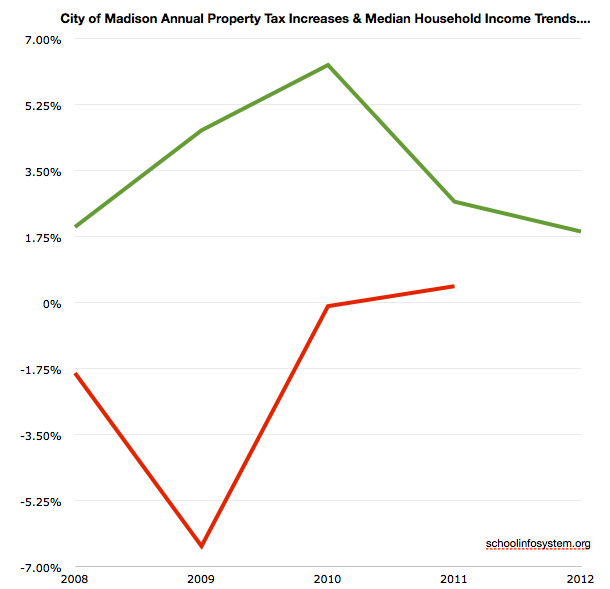
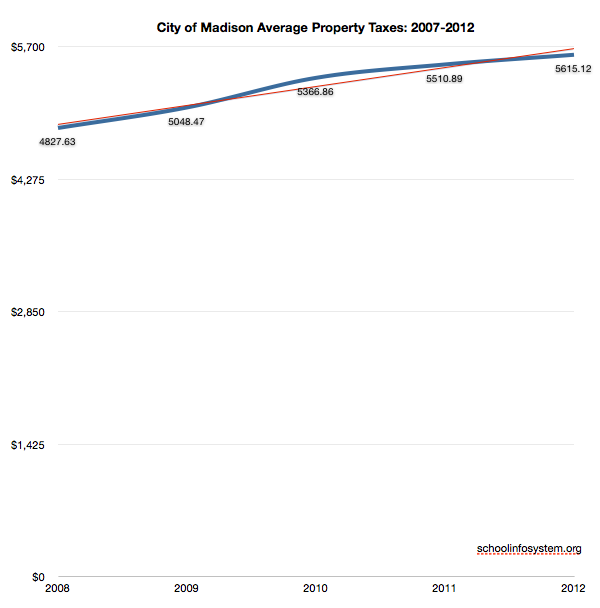
Dive deeper into the charts, here.
The statistics on African-American achievement have been so grim throughout the years that in 2010, Kaleem Caire, at the time the CEO of the Urban League of Greater Madison, put forth a proposal for a charter school designed to help African-American students surmount the achievement gap. It was ultimately rejected by the Madison School Board in 2011 after a bitter fight.
It’s against this backdrop that Madison School District Superintendent Jennifer Cheatham took over the top job in spring 2013. In her first year, Cheatham earned favorable remarks from many in the community for her smart, focused and flexible approach, with a talent for connecting with teachers, the School Board, parents and city leaders alike.
Madison School District superintendent Jennifer Cheatham listens during a meeting at Madison Central Library.
In the 2013-2014 school year, she revised the discipline policy to reduce the number of suspensions and expulsions in favor of practices that let students stay in school, own up to misconduct, and learn how to better conduct themselves in the future. Many education equity advocates see changes in school discipline policies, like those adopted under Cheatham, as key to closing the achievement gap.
Related: Madison’s Disastrous Reading Results.
That was one issue that brought together family activists who formed Madison Partners for Inclusive Education [duckduckgo search] in 2003, Pugh said.
“A parent in an elementary school on the west side could be seeing high-quality inclusive expert teaching with a team that ‘got it,’ and someone on the east side could be experiencing exactly the opposite,” Pugh said. Families and the school district are still striving to provide the best learning experience to all students with disabilities.
The key is to establish a culture throughout the district where participation in the classroom by students with disabilities is expected and valued. In addition, all teachers need to be trained to work collaboratively with special education teachers to make that happen, she said.
“It comes down to leadership,” said Pugh, who added that she is heartened by Superintendent Jennifer Cheatham’s remarks about raising expectations for all students. “That’s where we start.”
The district had an outside consultant review its special education programs earlier this year.
“In the next several weeks, we’ll use this information, our own data and expertise in the district to develop an improvement plan, including what our immediate steps will be,” spokesperson Rachel Strauch-Nelson said.
There has been no small amount of tension over Madison’s tactics in this matter from the one size fits all English 10 to various “high school redesign” schemes.
Yet, Madison’s student population remains stagnant while nearby districts have grown substantially.
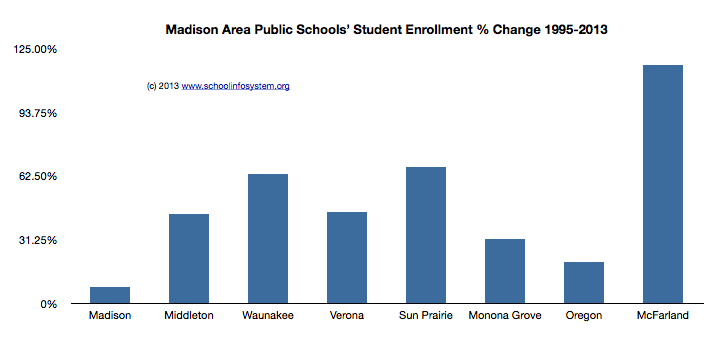
Outbound open enrollment along with a Talented and Gifted complaint are topics worth watching.
My simple thoughts on Madison’s latest Superintendent, Jennifer Cheatham:
How is the new Superintendent Doing?
Our community faces several historic challenges:
Despite spending double the national average per student, Madison’s reading results are a disaster. The Superintendent has been talking about this and there are indications that at least administrative attention to this urgent problem has changed.
Perhaps the most significant challenge our community faces is that school districts largely remain as they were a century ago: doing the same thing over and over yet becoming more costly each year. The rest of the world is obviously not standing still (www.wisconsin2.org)
The organizational stasis continues despite:
A. The information revolution:
I had dinner with some college students recently. All bright and motivated, they mentioned using the Khan Academy and many other online resources to learn. Sometimes supplementing coursework and in other cases replacing inadequate classroom lectures.
B. A few public schools are re-thinking their models:
Some Wisconsin Public schools are moving toward year around schedules:
Madison, meanwhile, seems largely content with the status quo:
C. Substantial growth in property taxes over the years, despite big changes in homeownership trends, demographics (rental growth) and the local economy.
https://www.schoolinfosystem.org/2013/06/09/madison_schools_89/
http://www.waxingamerica.com/2006/02/nineteen_financ.html
D. Michael Barry (the Madison School District’s Business Services Director) recently confirmed to me via email that 25% of the District’s 2014-2015 budget is spent on benefits (!)
Those trends will be very difficult to address within the current structure.
In summary: two big challenges: disastrous reading problems and an organization structure created for 1914.
It is too early to tell how things are going, though the District could certainly share reading results throughout the most recent school year, via its test results.
The interested reader would do well to review previous Superintendent coverage before, during and after. It is revealing. Pat Schneider takes a quick survey, here.
Dear Editor: While I bet much of sleepy Madison loved your article on new super-intendent Jennifer Cheatham, I found it both revolting and a perfect microcosm for the extreme flaws in the way we talk about student issues in Madison. The Madison School District and local media refuse to ever put the focus of these types of conversations on students. “Locals,” to you, means 11 bureaucrats and one graduated student. I have no interest in hearing from self-serving members of various boards and committees.
What I want, and what I never get, is testimonies from actual kids in the district who are struggling, who have had a problem during their K-12 years, and who could be better served by the Madison School District. I want to hear from a kid whose only meal comes at school, telling me the actual truth about whether their situation has improved or worsened, not 12 nearly identical, nondescriptive praises by adults. Put the focus where it belongs.
The Madison School District (3MB PDF):
Five Priority Areas (just like the “Big 10”) but who is counting! – page 6:
– Common Core
– Behavior Education Plan
– Recruitment and hiring
– New educator induction
– Educator Effectiveness
– Student, parent and staff surveys
– Technology plan
2014-2015 “budget package” 3MB PDF features some interesting changes, beginning on page 92, including:
1. + $986,314 to other Wisconsin public school districts due to Outbound open enrollment growth and $160,000 for Youth Options (page 108)
2. + 5.3% Teacher & Staff Health insurance spending is $44,067,547, or 11% of total spending! (Page 92). Total teacher & staff benefits are $73,248,235 or 18% of total spending. Let’s compare (as best we can):
Madison: 18% budget web page. Note, Madison’s is likely higher than 18% as I did not count all “funds” beyond teachers and certain staff. I’ve sent an email to the District for a complete number.
Middleton: 15.7% 2013-2014 Budget (PDF) Middleton – Cross Plains School District Budget web page. Middleton’s document summarizes spending across all funds (Page 8), something that I did not find in the Madison document (Pages 110-123 summarize aspects of Madison’s spending).
Boston: 14.1% Boston Schools 2013-2014-2015 budget xls file) Boston schools’ budget information.
Long Beach: 15.9% (Long Beach Budget Document (PDF)) Long Beach budget information.
Madison Superintendent Cheatham cited the Boston and Long Beach Schools for “narrowing their achievement gap” during a July, 2013 “What Will be Different This Time” presentation to the Madison Rotary Club.
3. “Educational Services” (Page 96) benefits are $21,581,653 up 4.5%.
4. “Food Services” (Page 98) benefits are $2,446,305, up 4.2%.
5. 10.3%: MSCR’s health insurance cost increase (page 99). MSCR spending and property tax growth (“Fund 80”) has been controversial in the past.
The Madison School District’s per student spending has been roughly constant for several years at about $15,000. Yet, certain budget elements are growing at a rather high rate, indicating an ability to manage effectively by reallocating and raising tax dollars or the presence of a rather fluid budget.
“focused instead on adult employment”
Retired Ripon Superintendent Richard Zimman’s 2009 Madison Rotary speech is always worth revisiting:
Zimman’s talk ranged far and wide. He discussed Wisconsin’s K-12 funding formula (it is important to remember that school spending increases annually (from 1987 to 2005, spending grew by 5.10% annually in Wisconsin and 5.25% in the Madison School District), though perhaps not in areas some would prefer.
“Beware of legacy practices (most of what we do every day is the maintenance of the status quo), @12:40 minutes into the talk – the very public institutions intended for student learning has become focused instead on adult employment. I say that as an employee. Adult practices and attitudes have become embedded in organizational culture governed by strict regulations and union contracts that dictate most of what occurs inside schools today. Any impetus to change direction or structure is met with swift and stiff resistance. It’s as if we are stuck in a time warp keeping a 19th century school model on life support in an attempt to meet 21st century demands.” Zimman went on to discuss the Wisconsin DPI’s vigorous enforcement of teacher licensing practices and provided some unfortunate math & science teacher examples (including the “impossibility” of meeting the demand for such teachers (about 14 minutes)). He further cited exploding teacher salary, benefit and retiree costs eating instructional dollars (“Similar to GM”; “worry” about the children given this situation).
Zimman noted that the most recent State of Wisconsin Budget removed the requirement that arbitrators take into consideration revenue limits (a district’s financial condition @17:30) when considering a District’s ability to afford union negotiated compensation packages. The budget also added the amount of teacher preparation time to the list of items that must be negotiated….. “we need to breakthrough the concept that public schools are an expense, not an investment” and at the same time, we must stop looking at schools as a place for adults to work and start treating schools as a place for children to learn.”
The price of budget spaghetti manifests itself via little to no oversight – see legitimate questions on the District’s most recent $26,200,000 maintenance referendum (another tax increase looms). These documents, while reasonably detailed, are impossible to compare to recent budgets.
The demise of Lawrie Kobza’s 2 page “citizen’s budget” will lead to growing cost of living and achievement gaps, including nearby Districts such as Middleton where a comparable homeowner spends 16% less on property taxes.
Last April, and to a remarkable amount of fanfare, Jennifer Cheatham became the superintendent of the Madison Metropolitan School District. From the very start, the community has opened its arms to welcome her. When I interviewed her for Madison Magazine TV last month, I was aware that the community, especially parents of color, continues to be hopeful, if not expectant, that she’ll be a superintendent who follows through on her promises to ensure that all students learn—no excuses. Here’s an excerpt of our talk.
Deana Wright: One component of the district’s new strategic framework is parental and community involvement. Research, of course, has shown that when parents get involved in their kids’ education, not only do test scores go up, but disciplinary problems go down. The report does indicate that the plan to develop family engagement strategies for each school is a little behind schedule. What is the next step?
Jennifer Cheatham: Each of our schools develop their school improvement plans, and one of the requirements for those improvement plans is to have a strategy for better engaging families. What we learned quickly is that our schools are struggling with that. They just don’t know enough about what great parent engagement looks like. So, we had to take a close look at, really, what defined parent and family engagement, first of all. I think we intentionally had to slow this work down, because we realized that it was more complicated than we originally thought and we’re trying to re-define family engagement so it isn’t about expecting families to come to us, to come to the traditional events that we hold in our schools, but to really think about family engagement differently.
DW: Does that mean going to them?
Related:
Madison’s long term disastrous reading results
Madison’s 2013-2014 budget, about $392,000,000 or $15k/student
A brief look at recent Madison Superintendents.
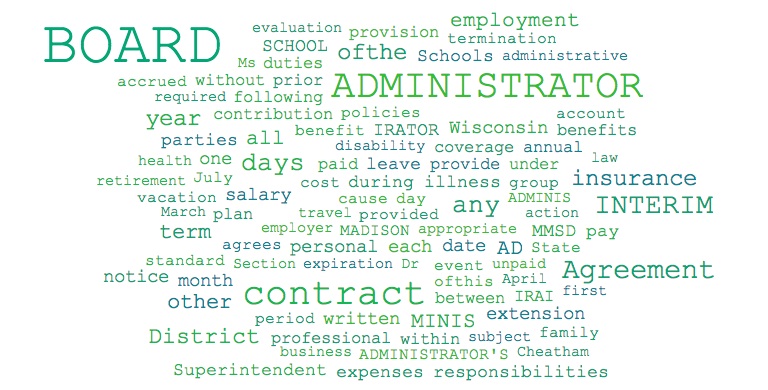
630K PDF Contract between Superintendent Cheatham and the Madison School District.
The lack of Superintendent oversight was an issue during the Rainwater era. Superintendent Cheatham’s contract includes this:
14.01 At least once each year, the BOARD of Education will provide the ADMINISTRATOR with an evaluation
a. The annual evaluation shall occur in closed session.
b. Prior to the BOARD conducting the SUPERINTENDENT’S evaluation, the SUPERINTENDENT shall provide the BOARD a self-appraisal. The BOARD shall take this self-appraisal into account in conducting its evaluation
c. All forms used and report formats requested as part of the evaluation process shall be collaboratively developed and mutually agreed upon by the ADMINISTRATOR and the BOARD.
d. While individual opinions may be expressed in the evaluation process, the final written record of performance evaluations shall include only narrative statements or opinions endorsed by a majority of the BOARD. The written evaluation shall be considered confidential to the extent permitted by law
Related: A Look At Compensation Packages for Wisconsin School District Superintendents.
Yet, reading, an issue for years in the Madison School District, remains a disastrous problem.
Today, Caire’s tone has moderated. Somewhat.
“Teachers are not to blame for the problems kids bring into the classroom,” he says. “But teachers have to teach the kids in front of them. And Madison teachers are not prepared to do that. Now we have two choices: Make excuses why these kids can’t make it and just know that they won’t. Or move beyond and see a brighter future for kids.”
Many parents back him up. And many parents of students of color say that their experience with Madison’s public schools–both as students here, themselves, and now as parents–is simply much different and much worse than what they see white students and parents experiencing.
“I just always felt like I was on as a parent, like every time I walked through the door of that school I would have to go to bat for my son,” says Sabrina Madison, mother of a West High graduate who is now a freshman at UW-Milwaukee. “Do you know how many times I was asked if I wanted to apply for this [assistance] program or that program? I would always say, ‘No, we’re good.’ And at the same time, there is not the same ACT prep or things like that for my child. I was never asked ‘Is your son prepared for college?’ I never had that conversation with his guidance counselor.”
Hedi Rudd, whose two daughters graduated from East and son from West, says it has been her experience that the schools are informally segregated by assistance programs and that students of color are more likely to be treated with disrespect by school personnel. “Walk into the cafeteria and you’ll see the kids [of color] getting free food and the white students eating in the hall. I walked into the school office one day,” she recalls. “I look young and the secretary thought I was a student. She yelled, ‘What are you doing here?’ I just looked at her and said, ‘Do you talk to your students like that?'”
Dawn Crim, the mother of a daughter in elementary school and a son in middle school, says lowered expectations for students of color regardless of family income is an ongoing problem. “When we moved to Madison in 1996, we heard that MMSD was a great school district … and for the most part it has been good for our kids and family: strong teachers, good administrators, a supportive learning environment, and we’ve been able to be very involved.”
But?
“Regarding lower expectations for kids of color, not just disadvantaged kids, we, too, have experienced the lower expectations for our kids; overall there is a feeling and a sense of lower expectations,” Crim says. “And that should not come into play. All of our kids should be respected, pushed, have high expectations and should get the best education this district says it gives.”
In the meantime, the school district has been running programs in partnership with the Urban League of Greater Madison, UW-Madison, United Way of Dane County, the Boys and Girls Club of Dane County, and other organizations–all designed to lift scholastic achievement, close the gap, and get more kids graduated and on to college.
The Advancement Via Individual Determination program known as AVID (or AVID/TOPS, when coordinated with the Teens Of Promise program) is run by the district and the Boys and Girls Club here, and is a standout in a slew of public/private efforts to change the fate of students of color in Madison.
…..
At the end of the last school year, a total of four hundred forty-two students did not graduate on time from high school in Madison. One hundred nine were white, eighty-six were Hispanic, thirty-three were Asian and one hundred ninety-one were African American. If the graduation rate for African American students had been comparable to the eighty-eight percent graduation rate of white students, one hundred forty more African American students would have graduated from Madison high schools.
But they did not. While it’s true that the district actively searches out students who did not graduate on time, and works with them so that as many as possible do ultimately graduate, the black-and-white dividing line of fifty-five/eighty-eight remains for now the achievement gap’s stark, frightening, final face. What can be said is that many more Madisonians are paying attention to it, and many people in a position to make a difference are doing their level best to do something about it.
……
“One of the reasons we haven’t been as successful as we could be is because we’ve lacked focus and jumped from initiative to initiative,” she (Cheatham) says of the Madison schools.
Related: notes and links on Mary Erpanbach, Jennifer Cheatham and Madison’s long term disastrous reading scores.
Background articles:
Notes and links on the rejected Madison Preparatory IB Charter School.
When all third graders read at grade level or beyond by the end of the year, the achievement gap will be closed…and not before (2005).
Notes and Links on the Madison K-12 Climate and Superintendent Hires Since 1992.
My Life and Times With the Madison Public Schools
Latest Madison Schools’ 2013-2014 $391,834,829 Budget.
@jimzellmer She sees "lack of focus" as problem. District "has spread itself too thin." Throws so many strategies at problem. @MollyBeckWSJ
— Scott Milfred (@ScottMilfred) January 16, 2014
@jimzellmer On teaching and learning, district will now "execute on a few things & do them really well." @MollyBeckWSJ
— Scott Milfred (@ScottMilfred) January 16, 2014
I’m glad to see the apparent focus on doing a few things well. This is the only way forward given the District’s disastrous reading results. That said, I was disappointed when the new Superintendent largely continued the “same service” budget approach during the 2013-2014 financial discussions.
The District’s 2x per student spending (above the national average) has supported numerous initiatives, likely preventing a focus on those that are truly meaningful for our students. For example, Kerry Motoviloff noted that Madison Schools Administration has “introduced more than 18 programs and initiatives for elementary teachers since 2009”. Steven Sinofsky’s latest is also worth reading in this context.
All students in the Madison School District would have their own tablets or notebook computers by the 2018-19 school year under a five-year, $31 million plan proposed by Superintendent Jennifer Cheatham.
If approved, the plan would increase the district’s current
$1.5 million annual technology budget to $4.2 million in the 2014-15 school year to start upgrading the district’s network infrastructure, upgrade or equip classrooms and libraries with new technology or computers, and provide notebook computers to all district teachers and administrators. Elementary teachers also would get tablet computers under the plan.
Costs to upgrade are projected to increase each of the five years of the plan for a total of $31 million spent in that time. Afterward, the annual budget for technology would be about $7 million per year going forward.
…..
Madison School Board members, who formally received the plan at their meeting Monday, were mostly optimistic about the plan. Board member T.J. Mertz questioned whether the program needed to be as extensive as it’s proposed given what he said were other unmet needs in the district and given research that he called “universally disappointing” surrounding such initiatives.
Mertz said in an interview after Monday’s board meeting that he agrees with the majority of the investments in technology under the plan, “but then there’s a third or a quarter where I think it’s going overboard.”
As an example, Mertz said he questions whether every kindergarten student needs their own tablet computer.
Prior to spending any additional taxpayer funds on new initiatives, I suggest that the District consider (and address) the status of past expensive initiatives, including:
Infinite Campus: is it fully implemented? If not, why? Why continue to spend money on it?
“Standards based report cards“.
Connected Math.
Small Learning Communities.
And of course, job number one, the District’s long term disastrous reading scores.
Madison already spends double the national average per student ($15k). Thinning out initiatives and refocusing current spending on reading would seem to be far more pressing than more hardware.
The district provided a comprehensive extended learning summer school program, K-Ready through 12th grade, at ten sites and served 5,097 students. At each of the K-8 sites, there was direction by a principal, professional Leopold, Chavez, Black Hawk and Toki, and oral language development was offered at Blackhawk and Toki. The 4th grade promotion classes were held at each elementary school, and 8th grade promotion classes were held at the two middle school sites.
Students in grades K-2 who received a 1 or 2 on their report card in literacy, and students in grades 3-5 who received a 1 or 2 in math or literacy, were invited to attend SLA. The 6-7 grade students who received a GPA of 2.0 or lower, or a 1 or 2 on WKCE, were invited to attend SLA. As in 2012, students with report cards indicating behavioral concerns were invited to attend summer school. Additionally, the summer school criterion for grades 5K-7th included consideration for students receiving a 3 or 4 asterisk grade on their report card (an asterisk grade indicates the student receives modified curriculum). In total, the academic program served 2,910 students, ranging from those entering five-year-old kindergarten through 8th grade.
High school courses were offered for credit recovery, first-time credit, and electives including English/language arts, math, science, social studies, health, physical education, keyboarding, computer literacy, art, study skills, algebra prep, ACT/SAT prep, and work experience. The high school program served a total of 1,536 students, with 74 students having completed their graduation requirements at the end of the summer.
All academic summer school teachers received approximately 20 hours of professional development prior to the start of the six-week program. Kindergarten-Ready teachers as well as primary literacy and math teachers also had access to job embedded professional development. In 2013, there were 476 certified staff employed in SLA.
Jennifer Cheatham:
Key Enhancements for Summer School 2014
A) Provide teachers with a pay increase without increasing overall cost of summer school.
Teacher salary increase of 3% ($53,887).
B) Smaller Learning Environments: Create smaller learning environments, with fewer students per summer school site compared to previous years, to achieve the following: increase student access to high quality learning, increase the number of students who can walk to school, and reduce number of people in the building when temperatures are high. ($50,482)
C) Innovations: Pilot at Wright Middle School and Lindbergh Elementary School where students receive instruction in a familiar environment, from a familiar teacher. These school sites were selected based on identification as intense focus schools along with having high poverty rates when compared to the rest of the district. Pilot character building curriculum at Sandburg Elementary School. ($37,529)
D) Student Engagement: Increase student engagement with high quality curriculum and instruction along with incentives such as Friday pep rallies and afternoon MSCR fieldtrips. ($25,000)
E) High School Professional Development: First-time-offered, to increase quality of instruction and student engagement in learning. ($12,083)
F) Student Selection: Utilize an enhanced student selection process that better aligns with school’s multi-tiered systems of support (MTSS) so that student services intervention teams (SSIT) have time to problem solve, and recommend students for SLA. Recommendations are based on student grades and standardized assessment scores, such as a MAP score below the 25th percentile at grades 3-5, or a score of minimal on the WKCE in language arts, math, science, and social studies at grades 3-5. (no cost)
Estimated total cost: $185,709.00
Summer School Program Reductions
The following changes would allow enhancements to summer school and implementation of innovative pilots:
A) Professional development (PD): reduce PD days for teachers grades K-8 by one day. This change will save money and provide teachers with an extra day off of work before the start of summer school (save $49,344.60).
B) Materials reduction: the purchase of Mondo materials in 2013 allows for the reduction of general literacy curricular materials in 2014 (save $5,000).
C) Madison Virtual Campus (MVC): MVC is not a reimbursable summer school program as students are not in classroom seats. This program could be offered separate from summer school in the future (save $18,000).
D) Librarians: reduce 3 positions, assigning librarians to support two sites. Students will continue to have access to the expertise of the librarian and can utilize library resources including electronic equipment (save $12,903.84).
E) Reading Interventionists: reduce 8 positions, as summer school is a student intervention, it allows students additional learning time in literacy and math. With new Mondo materials and student data profiles, students can be grouped for the most effective instruction when appropriate (save $48,492).
F) PBS Coach: reduce 8 positions, combining the coach and interventionist positions to create one position (coach/interventionist) that supports teachers in setting up classes and school wide systems, along with providing individual student interventions. With smaller learning sites, there would be less need for two separate positions (save $24,408).
G) Literacy and Math Coach Positions: reduce from 16 to 5 positions, combining the role and purpose of the literacy and math coach. Each position supports two schools for both math and literacy. Teachers can meet weekly with literacy/math coach to plan and collaborate around curriculum and student needs (save $27,601.60).
Estimated Total Savings: $185,750.04
Strategic Framework:
The role of the Summer Learning Academy (SLA) is critical to preparing students for college career and community readiness. Research tells us that over 50% of the achievement gap between lower and higher income students is directly related to unequal learning opportunities over the summer (Alexander et al., 2007). Research based practices and interventions are utilized in SLA to increase opportunities for learning and to raise student achievement across the District (Odden & Archibald, 2008). The SLA is a valuable time for students to receive additional support in learning core concepts in literacy and math to move them toward MMSD benchmarks (Augustine et.al., 2013). SLA aligns with the following Madison Metropolitan School District (MMSD) Strategic Framework goals:
A) Every student is on-track to graduate as measured by student growth and achievement at key milestones. Milestones of reading by grade 3, proficiency in reading and math in grade 5, high school readiness in grade 8, college readiness in grade 11, and high school graduation and completion rate.
B) Every student has access to challenging and well-rounded education as measured by programmatic access and participation data. Access to fine arts and world languages, extra-curricular and co-curricular activities, and advanced coursework.
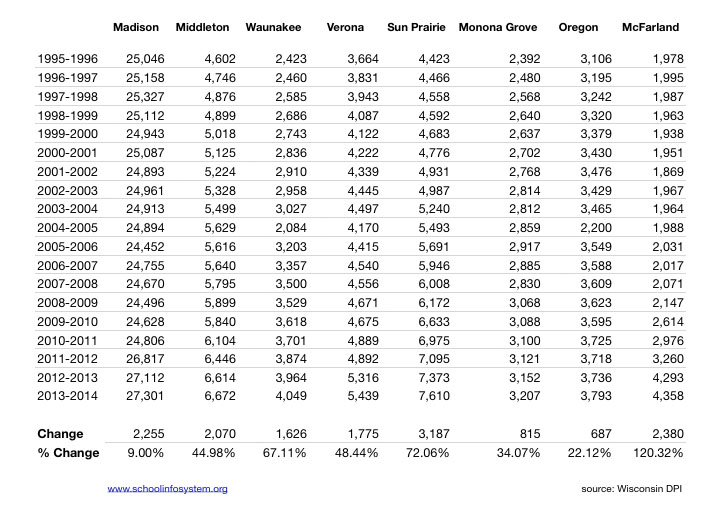
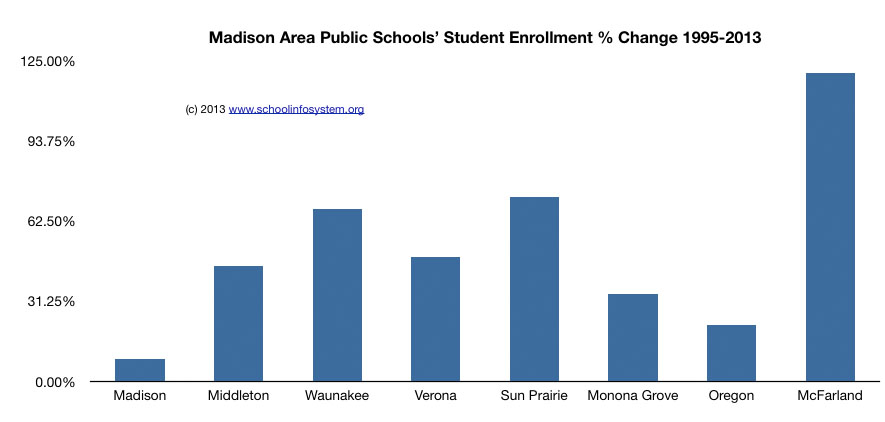
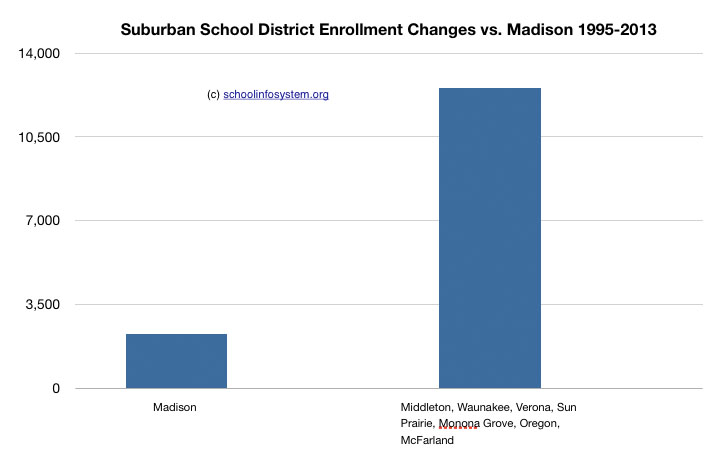
In light of Alan Borsuk’s positive article, I thought it timely understand the mountain to be climbed by our traditional $15k/student public school district. The charts above are a brief update of the always useful “Where have all the Students Gone” articles.
Further, early tenure cheerleading is not a new subject. Those interested might dive into the Capital Times & Wisconsin State Journal Superintendent (recently easily searched, now rather difficult) archive:
Cheryl Wilhoyte (1,569) SIS
Art Rainwater (2,124) SIS
Dan Nerad (275) SIS
That being said, Superintendent Cheatham’s comments are worth following:
Cheatham’s ideas for change don’t involve redoing structure. “I’d rather stick with an imperfect structure,” she said, and stay focused on the heart of her vision: building up the quality and effectiveness of teaching.
Improving teaching is the approach that will have the biggest impact on the gaps, she said.
“The heart of the endeavor is good teaching for all kids,” Cheatham said in an interview. Madison, she said, has not defined what good teaching is and it needs to focus on that. It’s not just compliance with directives, she said.
Perhaps the State Journal’s new K-12 reporter might dive into what is actually happening in the schools.
Related: Madison’s long term disastrous reading results and “When all third graders read at grade level or beyond by the end of the year, the achievement gap will be closed…and not before“.
I called Hanks to ask her about her decision to leave Chicago. She responded by e-mail. “A great opportunity presented itself that I thought I could really grow and learn from. You know I am still pretty young, too. I don’t have kids, so it’s easier for me to move around now versus one day when I am more settled.
“I had a great experience leading Melody and I’m proud of the work that we did,” she went on. “That work prepared me to take on this role.”
A spokesperson for CPS told me in an e-mail: “We never like to see talented leaders like Nancy Hanks leave the district. We wish her success in her new role and hope she returns to CPS at some point.” He added that the district’s “extensive professional development, training, and recruiting programs . . . help ensure that we always have a pipeline of qualified leaders ready to replace principals who may move, retire, or leave the district for new opportunities.”
The Madison superintendent who recruited Hanks, Jennifer Cheatham, had herself recently left CPS. Cheatham, 41, who was chief instruction officer here, was named superintendent in Madison in February.
A cynic would be forgiven for wondering whether the press conference Minneapolis mayoral candidate Mark Andrew held Monday afternoon, flanked by five members of the school board, was at least partly an exercise in damage control.
At the session, held in the library at Windom Dual Immersion School in southwest Minneapolis, Andrew announced a three-pronged education agenda. At its center: a promise to convene a collaborative headed by education advocates with divergent philosophies, Mike Ciresi and Louise Sundin.
“The conversation about improving educational outcomes for kids of color has gotten extremely polarized and increasingly heated in the past several years,” Andrew explained in the plan. “The reformers vs. unions dichotomy is unproductive, and doesn’t serve the best interests of our children or find Minneapolis solutions to the problems in Minneapolis’ schools.”
Minneapolis plans to spend $524,944,868 (PDF budget book) during the 2013-2014 school year for 34,148 students or 15,364 per student, about the same as Madison.
Yet, property taxes are substantially lower in Minneapolis where a home currently on the market for $279,900 has a 2013 property tax bill of $3,433. A $230,000 Madison home pays $5,408.38 while a comparable Middleton home pays $4,648.18 in property taxes. Madison plans to increase property taxes 4.5% this year, after a 9% increase two years ago, despite a substantial increase in redistributed state tax dollar receipts. Yet, such history is often ignored during local tax & spending discussions. Madison Superintendent Cheatham offers a single data point response to local tax & spending policy, failing to mention the substantial increase in state tax receipts the year before:
When we started our budget process, we received the largest possible cut in state aid, over $8 million,” Cheatham said. “I’m pleased that this funding will make up a portion of that cut and help us accomplish what has been one of our goals all along: to reduce the impact of a large cut in state aid on our taxpayers.”
A bit more background.
Jennifer Cheatham, Madison School District superintendent, said what type of devices and how much funding the plan will need has not been determined.
“We believe that in order to be college-, career- and community-ready they need to know how to use the technology available to them,” Cheatham said.
At Sandburg, the iPads are used in lesson plans daily and stay with the students through the end of elementary school. By the end of the year, about 70 percent of the instruction and learning involve an iPad, according to Coblentz. Currently, students are not allowed to take them home.
The students start using the iPads in second grade with access to seven educational apps and no access to the Internet or the camera. Week by week the students learn how to use the iPad in additional subjects.
Coblentz and Wilfrid said the limited functionality is intentional. They want the younger students to learn how to correctly use the camera and Internet, and have students realize it is a privilege to use the devices and to demonstrate they are ready for other features.
I disagree somewhat with the Superintendent’s sentiment. The iPad per se is not terribly important at this point. Rather, reading continues to be job one along with math and science.
The third grader using an iPad today will be interacting with information in a very different way in tech school or college. Accomplished reading, math, science and critical thinking skills are far more important.
Kelly Ruppel grew up on a dairy farm outside Racine, headed to the west coast for college and worked in Washington D.C. before moving back to the Midwest and becoming a private consultant to the embattled Chicago Public Schools system.
When she received a job offer from new Madison Schools Superintendent Jennifer Cheatham, whom she met when Cheatham was a top administrator at Chicago Public Schools, she and her husband packed their bags.
Today Ruppel is Cheatham’s chief of staff, one of five top administrators hired by Cheatham with ties to Chicago since taking the reins of the Madison School District in April.
In addition to Ruppel, a former principal at Civic Consulting Alliance, they include:
Alex Fralin, assistant superintendent for secondary schools and former Deputy Chief of Schools for CPS
Rodney Thomas, special assistant to the superintendent and former director of Professional Development and Design for the Chicago Board of Education
Nancy Hanks, deputy assistant superintendent for Elementary Schools and a former Chicago public elementary school principal
Jessica Hankey, director of strategic partnerships and innovation, formerly manager of school partnerships at The Field Museum in Chicago.
Fascinating. Are these new positions, or are the entrants replacing others? 10/2013 Madison School District organization chart (PDF).
Related: “The thing about Madison that’s kind of exciting is there’s plenty of work to do and plenty of resources with which to do it,” Mitchell said. “It’s kind of a sweet spot for Jen. Whether she stays will depend on how committed the district is to continuing the work she does.”
Under the new contracts clerical and technical employees will be able to work 40-hour work weeks compared to the current 38.75, and based on the recommendation of principals, employees who serve on school-based leadership teams will be paid $20 per hour.
Additionally, six joint committees will be created to give employees a say in workplace issues and address topics such as planning time, professional collaboration and the design of parent-teacher conferences.
Kerry Motoviloff, a district instructional resource teacher and MTI member, spoke at the beginning of the meeting thanking School Board members for their collective bargaining and work in creating the committees that are “getting the right people at the right table to do the right work.”
Cheatham described the negotiations with the union as “both respectful and enormously productive,” adding that based on conversations with district employees the contract negotiations “accomplished the goal they set out to accomplish.”
“Madison is in the minority. Very few teachers are still under contract,” said Christina Brey, spokeswoman for the Wisconsin Education Association Council. Fewer than 10 of 424 school districts in the state have labor contracts with teachers for the current school year, she said Wednesday.
And while Brey said WEAC’s significance is not undermined by the slashed number of teacher contracts, at least one state legislator believes the state teacher’s union is much less effective as a resource than it once was.
Many school districts in the state extended teacher contracts through the 2011-2012 school year after Act 10, Gov. Scott Walker’s law gutting collective bargaining powers of most public employees, was implemented in 2011. The Madison Metropolitan School District extended its teacher contract for two years — through the 2013-2014 school year — after Dane County Judge Juan Colas struck down key provisions of Act 10 in September 2012.
The contract ratified by the members Monday will be in effect until June 30, 2015.
On Thursday, the Wisconsin Institute for Law and Liberty emailed a letter to Cheatham and the School Board warning that a contract extension could be in violation of Act 10.
Richard Esenberg, WILL president, said he sent the letter because “we think there are people who believe, in Wisconsin, that there is somehow a window of opportunity to pass collective bargaining agreements in violation of Act 10, and we don’t think that.”
If the Supreme Court rules Act 10 is constitutional all contracts signed will be in violation of the law, according to Esenberg.
Esenberg said he has not read the contract and does not know if the district and union contracts have violated collective bargaining agreements. But, he said, “I suspect this agreement does.”
The contract does not “take back” any benefits, Matthews says. However, it calls for a comprehensive analysis of benefits that could include a provision to require employees to pay some or more toward health insurance premiums if they do not get health care check-ups or participate in a wellness program.
Ed Hughes, president of the Madison School Board, said that entering into labor contracts while the legal issues surrounding Act 10 play out in the courts was “the responsible thing to do. It provides some stability to do the important work we need to do in terms of getting better results for our students.”
Hughes pointed out that the contract establishes a half-dozen joint committees of union and school district representatives that will take up issues including teacher evaluations, planning time and assignments. The contract calls for mediation on several of the issues if the joint committees cannot reach agreement.
“Hopefully this will be a precursor of the way we will work together in years to come, whatever the legal framework is,” Hughes said.
Matthews, too, was positive about the potential of the joint committees.
Wisconsin Institute for Law & Liberty:
WILL President and General Counsel Rick Esenberg warns, “The Madison School Board is entering a legally-gray area. Judge Colas’ decision has no effect on anyone outside of the parties involved. The Madison School Board and Superintendent Cheatham – in addition to the many teachers in the district – were not parties to the lawsuit. As we have continued to say, circuit court cases have no precedential value, and Judge Colas never ordered anyone to do anything.”
He continued, “If the Madison School District were to collectively bargain in a way that violates Act 10, it could be exposed to litigation by taxpayers or teachers who do not wish to be bound to an illegal contract or to be forced to contribute to an organization that they do not support.” The risk is not theoretical. Last spring, WILL filed a lawsuit against the Milwaukee Area Technical College alleging such a violation.
The Wisconsin Institute for Law & Liberty’s letter to Madison Superintendent Jennifer Cheatham (PDF).
The essential question, how does Madison’s non-diverse K-12 governance model perform academically? Presumably, student achievement is job one for our $15k/student district.
Worth a re-read: Then Ripon Superintendent Richard Zimman’s 2009 speech to the Madison Rotary Club:
“Beware of legacy practices (most of what we do every day is the maintenance of the status quo), @12:40 minutes into the talk – the very public institutions intended for student learning has become focused instead on adult employment. I say that as an employee. Adult practices and attitudes have become embedded in organizational culture governed by strict regulations and union contracts that dictate most of what occurs inside schools today. Any impetus to change direction or structure is met with swift and stiff resistance. It’s as if we are stuck in a time warp keeping a 19th century school model on life support in an attempt to meet 21st century demands.” Zimman went on to discuss the Wisconsin DPI’s vigorous enforcement of teacher licensing practices and provided some unfortunate math & science teacher examples (including the “impossibility” of meeting the demand for such teachers (about 14 minutes)). He further cited exploding teacher salary, benefit and retiree costs eating instructional dollars (“Similar to GM”; “worry” about the children given this situation).
Madison Superintendent Jennifer Cheatham recently cited the Boston and Long Beach Schools for “narrowing their achievement gap” during a July, 2013 “What Will be Different This Time” presentation to the Madison Rotary Club.
As time permits, I intend to post comparisons between the Districts, starting today.
Student / Teacher Ratio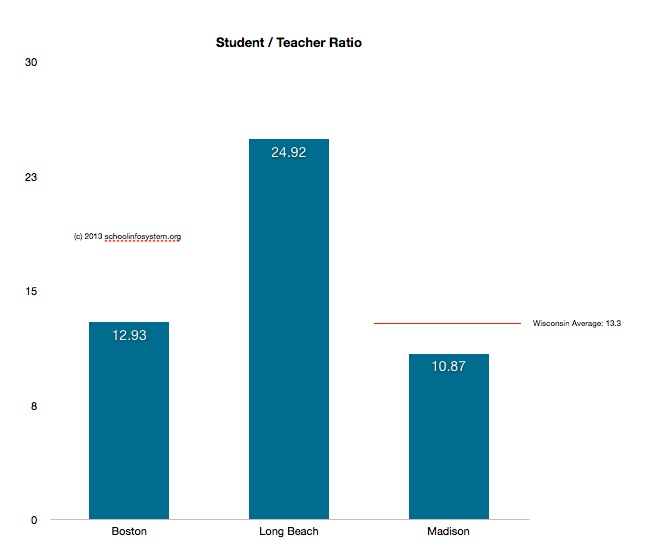
Per Student Annual Spending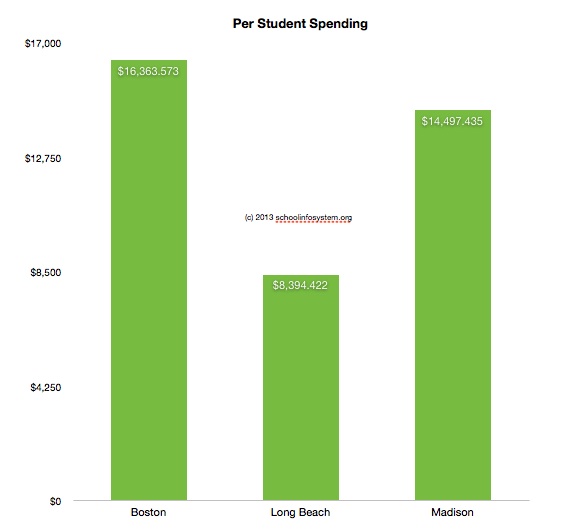
Boston Schools’ budget information was, by far the easiest to find. Total spending is mentioned prominently, rather than buried in a mountain of numbers.
Finally, after I noticed that Madison’s student / teacher ratio is significantly lower than Boston, Long Beach and the Badger state average, I took a look at the Wisconsin DPI website to see how staffing has changed over the past few years. Madison’s licensed staff grew from 2,273 in 2007-2008 to 2,492 in 2011-2012.
What are the student achievement benefits of Madison’s very low ratio?
Related: Madison Schools’ 2013-2014 budget includes a 4.5% property tax increase after 9% two years ago.
“Plenty of resources” and “the Madison School District has the resources to close the achievement gap“.
Given MTI’s victory in Circuit Court, wherein Judge Juan Colas found Act 10 unconstitutional, MTI and the District have agreed to commence Contract negotiations (PDF).
Details of this were announced in a joint letter to all District employees last Friday from Superintendent Jen Cheatham and MTI Executive Director John Matthews. Their letter stated that, “… to be successful this year and in the years to come, District employees must have a work environment that is both challenging and rewarding, and one which includes economic and employment security”. Matthews complimented the Superintendent and Board members for their progressive philosophy in recognizing the essentials in positive employment relations.
Contracts existed in all 423 school districts at the time Act 10 was passed in 2011. Currently, workers in only four school districts enjoy the wages, benefits and rights which a Collective Bargaining Agreement provides. The current Contracts for MTI’s five bargaining units expire June 30, 2014.
The State has appealed Judge Colas’ decision. The matter will be heard by the Wisconsin Supreme Court in November or December. In his ruling, Judge Colas stated that Act 10 was passed in a very controversial manner, skipping several steps mandated by legislative rules and Wisconsin law, and that it violated public workers’ Constitutional guarantees of freedom of speech and freedom of assembly, as well as the Constitutional guaranteed Equal Protection Clause.
I wonder what the sentiment across the teacher population might be? Perhaps there have been surveys?
Madison leaders say trimming city workers’ pay might be necessary:
Scheduled pay raises for union-represented city employees may need to be trimmed to help balance the 2014 city budget, Madison Mayor Paul Soglin and City Council President Chris Schmidt said Friday.
Schmidt said he didn’t relish the step — calling city workers “already underpaid for the jobs they do” — but he argued there could be no other choice.
Revenue limits under state law, rising city costs for fuel and health insurance, and a steadfast goal to protect funding for basic city services increasingly tie the city’s hands, he said.
“It’s understandable why it’s on the table, why we’re discussing it,” he said about the possible action, in which a 3 percent raise scheduled to start in the last pay period in December could be scaled back or eliminated for many employees in March.
Contract talks for Madison School District employees set to start this month, letter says contract negotiations for Madison School District employees are set to begin later this month, according to a letter sent Friday to district staff by superintendent Jennifer Cheatham and Madison Teachers Inc. executive director John Matthews.
Cheatham said in a phone interview that she and employee unions will be negotiating “as soon as we can” in order to create collective bargaining agreements that will take effect after the current contracts end in June 2014.
MTI asked the district to begin collective bargaining in May, but the new superintendent wanted to adjust to her role, become acquainted with the staff and hear their requests before bargaining with the teachers union and other employee unions.
Although the timeline is unclear, Cheatham said she expects to complete the contracts “fairly quickly” while also taking time to ensure the process is done correctly and has an outcome acceptable to all parties.
Much more on the Madison School District’s 2013-2014 budget (including a 4.5 property tax increase, after 9% two years ago), here.
he gist of her framework is hard to argue. It calls for a renewed focus on learning, a school system that makes curriculum consistent across the district and better measures student and teacher performance. In sum, it is a back-to-basics approach that does not require new money, at least for now.
Madison, of course, has been grappling with its changing demographics where many students, especially minority children, struggle academically. In shorthand, it’s called the “achievement gap,” and the approach to date has been a long list of seemingly laudable, logical programs.
Now comes Cheatham saying we don’t need more money, at least not yet, but instead we need to rebuild the foundation. Might some see that as counterintuitive, I wonder?
“It might be,” she responds. “My take is that we were adding on with a big price tag to an infrastructure that was weak. … Does that make sense? The bones of the organization were weak and we didn’t do the hard work of making sure that the day-to-day processes … were strong before deciding to make targeted investments on top of a strong foundation.”
She continues: “That doesn’t mean that there won’t be some targeted investments down the line. I suspect that will be in things like technology, for instance, which is a real challenge … and is going to have a price tag later. I need to make sure that the foundation is strong first.”
Cheatham alludes to her Chicago experience. “Having worked with lots of schools — and lots of schools that have struggled — and worked with schools targeting narrowing and closure of the achievement gap, these fundamental practices” make the biggest difference. “It’s that day-to-day work that ultimately produces results and student learning.”
We shall see. Local media have greeted prior Superintendents, including Cheryl Wilhoyte with style points, prior to the beginning of tough decision-making.
Related: The Dichotomy of Madison School Board Governance: “Same Service” vs. “having the courage and determination to stay focused on this work and do it well is in itself a revolutionary shift for our district”.
Another interesting governance question, particularly when changes to the 157 page teacher union contract, or perhaps “handbook” arise, is where the school board stands? Two seats will be on the Spring, 2014 ballot. They are presently occupied by Marj Passman and Ed Hughes. In addition, not all members may vote on teacher union related matters due to conflict of interests. Finally, Mary Burke’s possible race for the Governor’s seat (2014) may further change board dynamics.
I hope that Superintendent Cheatham’s plans to focus the organization on teaching become a reality. Nothing is more important given the District’s disastrous reading results. That said, talk is cheap and we’ve seen this movie before.
Madison Superintendent Jennifer Cheatham wisely stated:
“Rather than do a lot of work on opposing the voucher movement, we are going to focus on making sure our schools are the best schools possible and the schools of choice in Madison,” Cheatham said.
Just a few days ago, the Madison School Board said this in the “strategic framework document”:
Public education is under sustained attack, both in our state and across the nation. Initiatives like voucher expansion are premised on the notion that public schools are not up to the challenge of effectively educating diverse groups of students in urban settings.
We are out to prove that wrong. With Superintendent Cheatham, we agree that here in Madison all the ingredients are in place. Now it is up to us to show that we can serve as a model of a thriving urban school district, one that seeks out strong community partnerships and values genuine collaboration with teachers and staff in service of student success.
Our Strategic Framework lays out a roadmap for our work. While some of the goals will seem familiar, what’s new is a clear and streamlined focus and a tangible and energizing sense of shared commitment to our common goals.
Madison must focus, laser like on academic achievement.
The ill-fated charter school Madison Preparatory Academy would have cost Madison School District taxpayers about $17.5 million over five years to start addressing the district’s long-standing minority and low-income achievement gaps.
The achievement gap plan introduced by former superintendent Dan Nerad shortly after Madison Prep crashed and burned would have cost about $105 million over five years. Before being adopted, it was whittled down to about $49 million.
And the so-called “strategic framework” proposed last week by new superintendent Jennifer Cheatham?
Nada.
“The really exciting news is we have all the ingredients to be successful,” she told this newspaper.
No doubt that could be thinking so wishful it borders on delusion or, worse, code for “we’re not really all that interested in closing the gap anyway.” But it could also be a harbinger of real change.
“The framework isn’t meant to be compared to the achievement gap plan,” district spokeswoman Rachel Strauch-Nelson said. It’s “not about an array of new initiatives with a big price tag” but about focusing “on the day-to-day work of teaching and learning” and “what we know works.”
The dichotomy that is Madison School Board Governance was on display this past week.
1. Board Member TJ Mertz, in light of the District’s plan to continue growing spending and property taxes for current programs, suggests that “fiscal indulgences“:
Tax expenditures are not tax cuts. Tax expenditures are socialism and corporate welfare. Tax expenditures are increases on anyone who does not receive the benefit or can’t hire a lobbyist…to manipulate the code to their favor.
be applied to certain school volunteers.
This proposal represents a continuation of the Districts’ decades long “same service” approach to governance, with declining academic results that spawned the rejected Madison Preparatory IB Charter School.
2. Madison’s new Superintendent, Jennifer Cheatham introduced her “Strategic Framework” at Wednesday’s Downtown Rotary Club meeting.
The Superintendent’s letter (jpg version) (within the “framework” document) to the Madison Community included this statement (word cloud): 
Rather than present our educators with an ever-changing array of strategies, we will focus on what we know works and implement these strategies extremely well. While some of the work may seem familiar, having the courage and determination to stay focused on this work and do it well is in itself a revolutionary shift for our district. This is what it takes to narrow and eliminate gaps in student achievement.
The Madison School Board’s letter (jpg version) to the community includes this statement:
Public education is under sustained attack, both in our state and across the nation. Initiatives like voucher expansion are premised on the notion that public schools are not up to the challenge of effectively educating diverse groups of students in urban settings.
We are out to prove that wrong. With Superintendent Cheatham, we agree that here in Madison all the ingredients are in place. Now it is up to us to show that we can serve as a model of a thriving urban school district, one that seeks out strong community partnerships and values genuine collaboration with teachers and staff in service of student success.
Our Strategic Framework lays out a roadmap for our work. While some of the goals will seem familiar, what’s new is a clear and streamlined focus and a tangible and energizing sense of shared commitment to our common goals.
The bedrock of the plan is the recognition that learning takes place in the classroom in the interactions between teachers and students. The efforts of all of us – from school board members to everyone in the organization – should be directed toward enhancing the quality and effectiveness of those interactions.
There is much work ahead of us, and the results we are expecting will not arrive overnight. But with focus, shared effort and tenacity, we can transform each of our schools into thriving schools. As we do so, Madison will be the school district of choice in Dane County.
Madison School Board word cloud:
North Carolina Gov. Pat McCrory, a Republican, signed a budget bill Friday that eliminates teacher tenure and–in a rare move–gets rid of the automatic pay increase teachers receive for earning a master’s degree.
The legislation targets a compensation mechanism that is common in the U.S., where teachers receive automatic pay increases for years of service and advanced degrees. Some research has suggested those advanced degrees don’t lead to improved teaching.
Although a few other states have talked about doing away with the automatic pay increase for advanced degrees, experts say North Carolina is believed to be the first state to do so.
The budget bill–which drew hundreds of teachers to the Capitol in protest earlier this week–also eliminates tenure for elementary and high-school teachers and freezes teacher salaries for the fifth time in six years.
It comes as states and districts across the country are revamping teacher evaluations, salaries and job security, and linking them more closely to student performance. These changes have been propelled, in part, by the Obama administration and GOP governors.
The challenge for Madison is moving away from long time governance structures and practices, including a heavy (157 page pdf & revised summary of changes) teacher union contract. Chris Rickert’s recent column on Madison’s healthcare practices provides a glimpse at the teacher – student expenditure tension as well.
Then Ripon Superintendent Richard Zimman’s 2009 Madison Rotary speech offers important background on Madison’s dichotomy:
“Beware of legacy practices (most of what we do every day is the maintenance of the status quo), @12:40 minutes into the talk – the very public institutions intended for student learning has become focused instead on adult employment. I say that as an employee. Adult practices and attitudes have become embedded in organizational culture governed by strict regulations and union contracts that dictate most of what occurs inside schools today. Any impetus to change direction or structure is met with swift and stiff resistance. It’s as if we are stuck in a time warp keeping a 19th century school model on life support in an attempt to meet 21st century demands.” Zimman went on to discuss the Wisconsin DPI’s vigorous enforcement of teacher licensing practices and provided some unfortunate math & science teacher examples (including the “impossibility” of meeting the demand for such teachers (about 14 minutes)). He further cited exploding teacher salary, benefit and retiree costs eating instructional dollars (“Similar to GM”; “worry” about the children given this situation).
“Budget Cuts: We Won’t Be as Bold and Innovative as Oconomowoc, and That’s Okay”.
15mb mp3 audio.
Superintendent Cheatham’s slides follow (4MB PDF version). I hope that the prominence of Madison’s disastrous reading scores – slide 1 – indicates that this is job one for our $15,000ish/student organization.
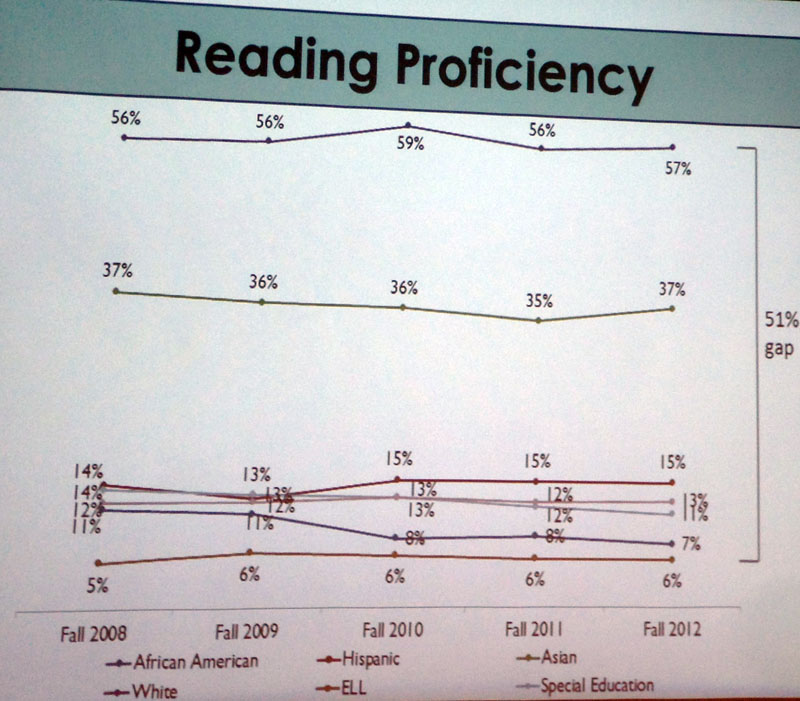
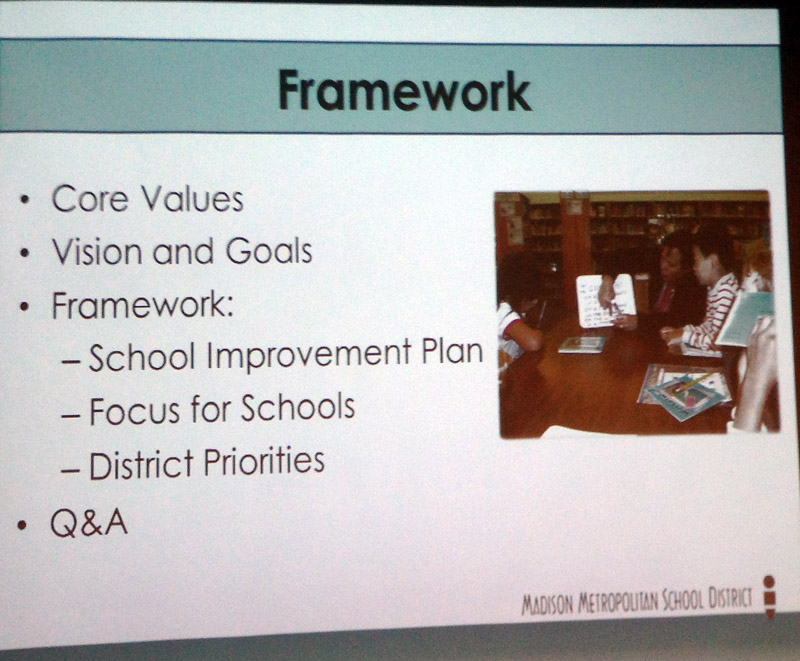
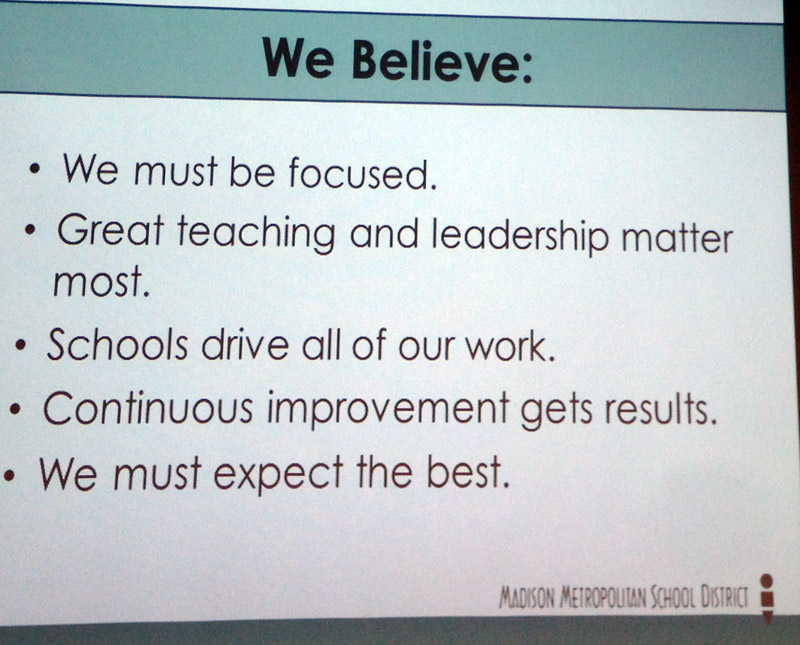
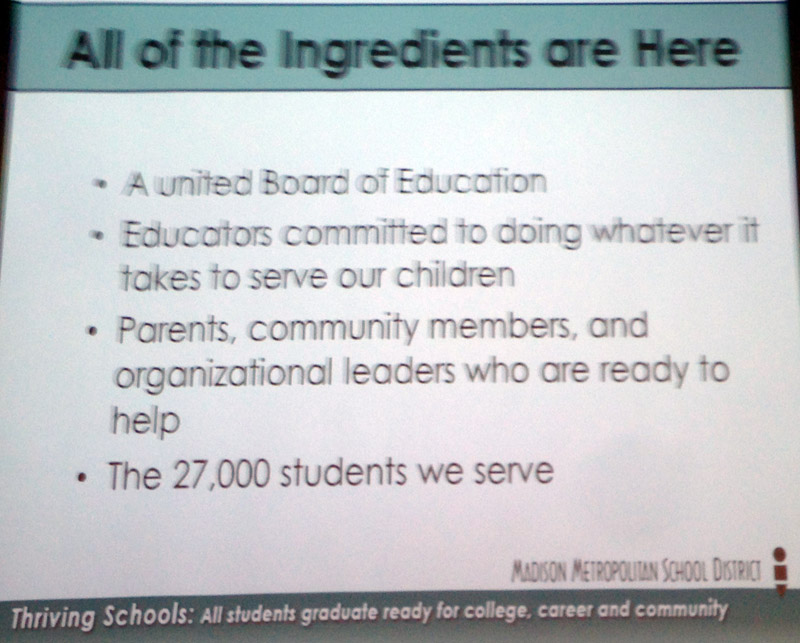
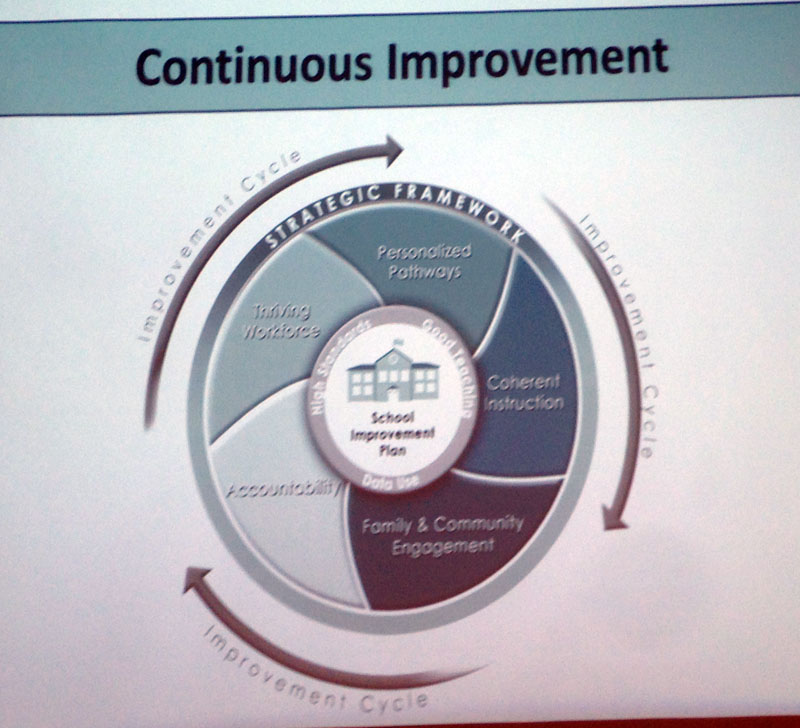
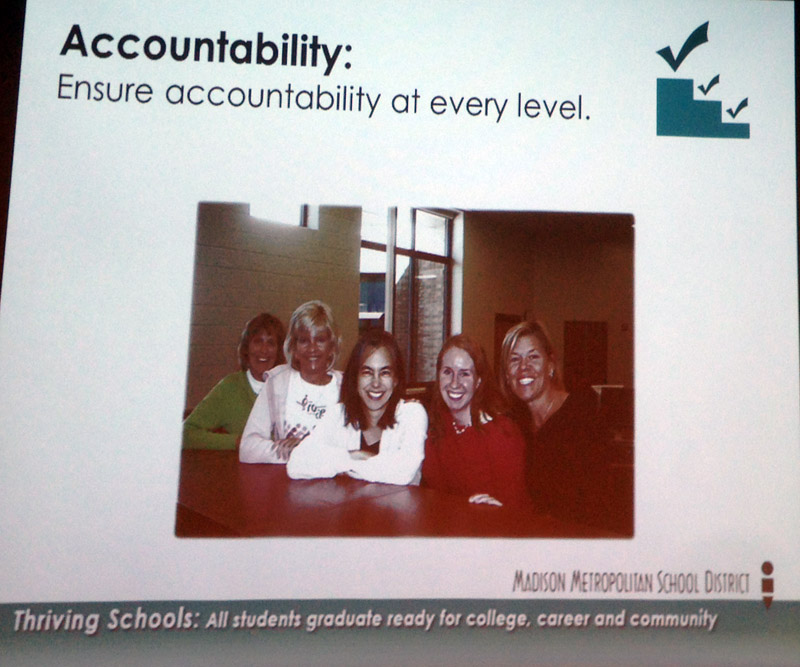
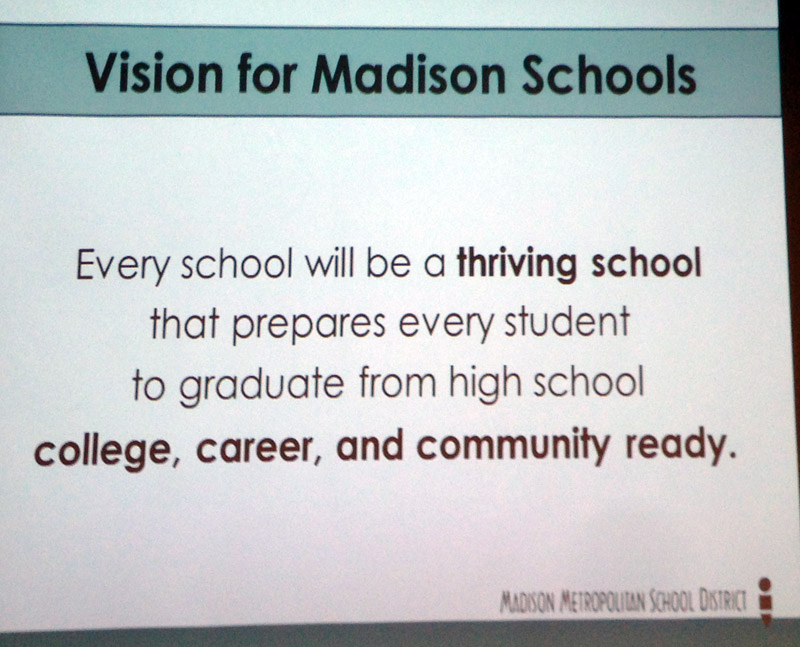
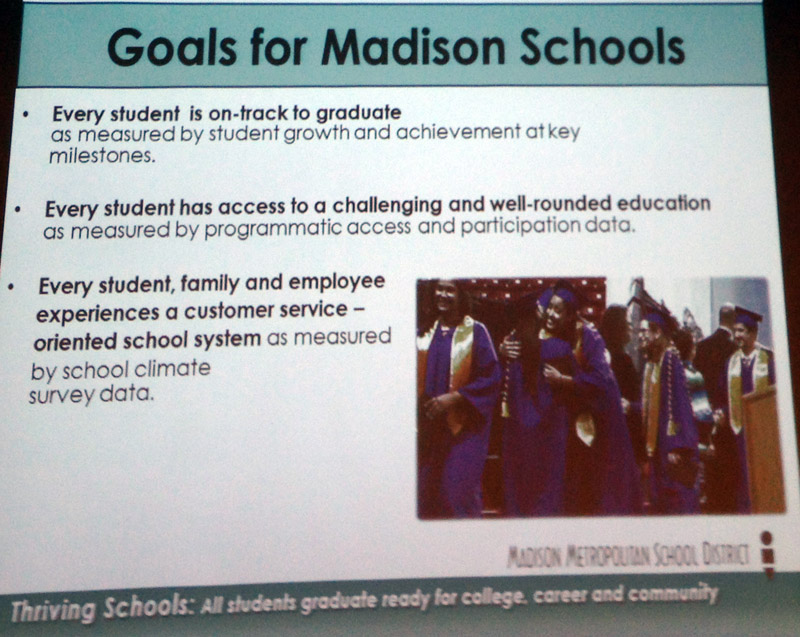
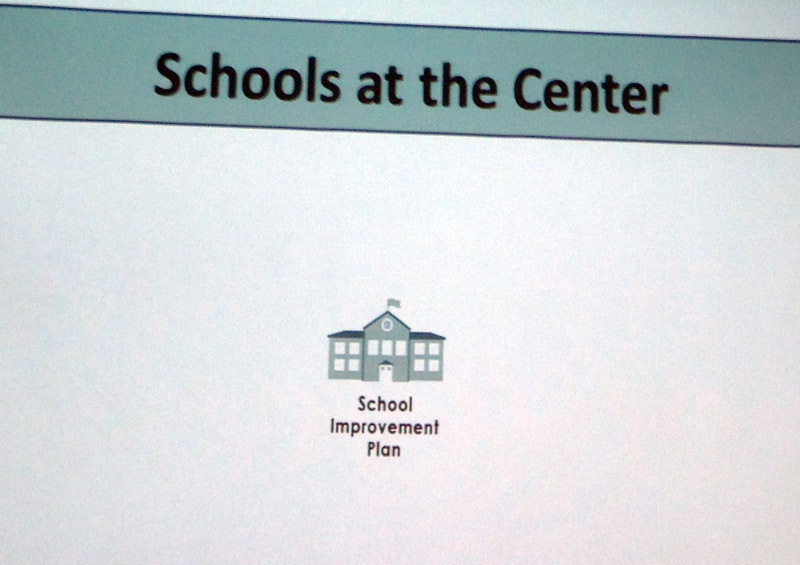
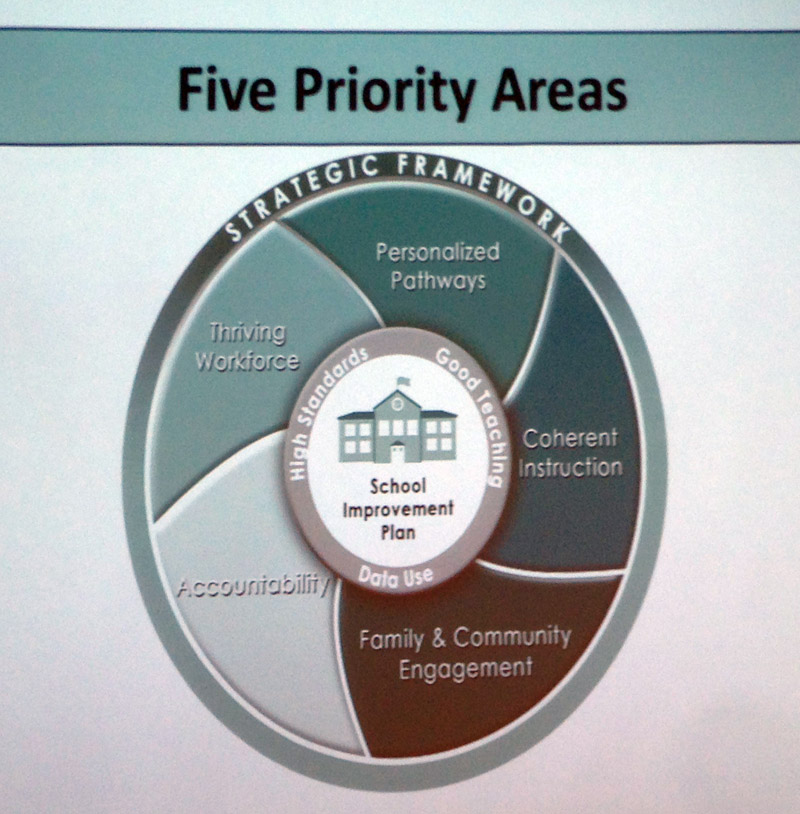
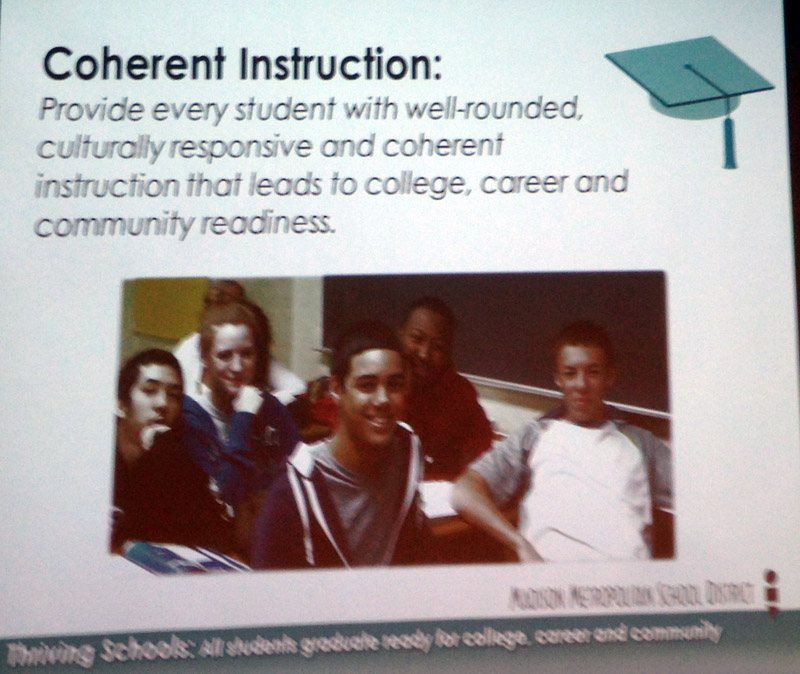
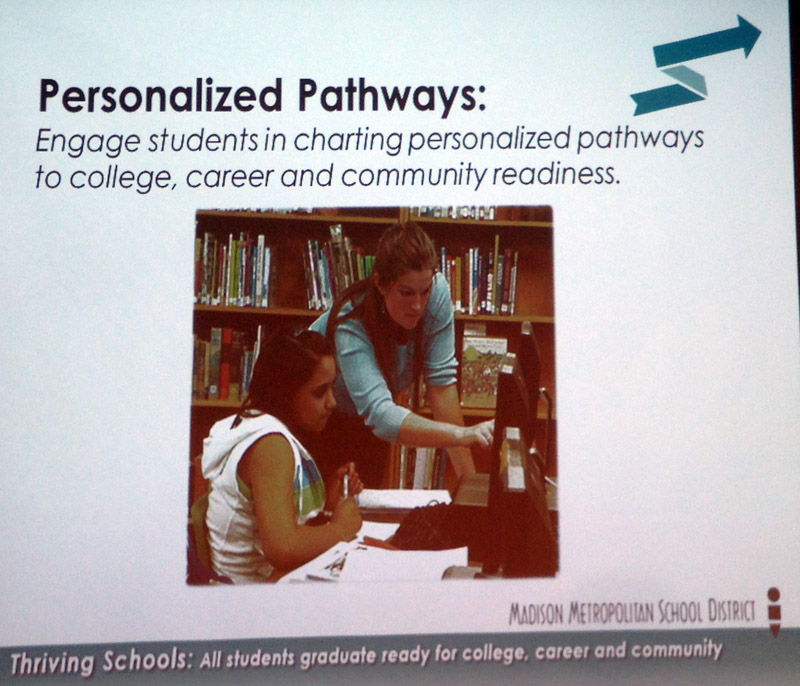


A few of the Superintendent’s words merit a bit of analysis:
1. “What will be different this time?” That rhetoric is appropriate for our Madison schools. I compiled a number of notes and links on this subject, here.
2. “Ready to partner with local businesses and other organizations”. Great idea. The substance of this would certainly be a change after the Madison Preparatory Academy IB Charter school debacle (Urban League) and, some years ago, the rejection of Promega’s kind offer to partner on Madison Middle Schools 2000.
3. Mentions “all Madison schools are diverse”. I don’t buy that. The range of student climate across all schools is significant, from Van Hise and Franklin to LakeView, Mendota and Sandburg. Madison school data by income summary. I have long been astonished that this wide variation continues. Note that Madison’s reading problems are not limited to African-American students.
4. Mentioned Long Beach and Boston as urban districts that have narrowed the achievement gap. Both districts offer a variety of school governance models, which is quite different than Madison’s long-time “one size fits all approach”.
5. Dave Baskerville (www.wisconsin2.org) asked a question about benchmarking Madison students vs. the world, rather than Green Bay and Milwaukee. Superintendent Cheatham responded positively to that inquiry. Interestingly, the Long Beach schools prominently display their status as a “top 5 school system worldwide”.
6. “Some teachers and principals have not been reviewed for as long as 7 years”. This points to the crux of hard decision making. Presumably, we are at this point because such reviews make no difference given rolling administrator contracts and a strong union umbrella (or floor depending on your point of view). Thus, my last point (below) about getting on with the hard decisions which focus the organization on job number one: reading.
Pat Schneider and Matthew DeFour summarize the Superintendent’s press release and appearance.
Finally, I found it a bit curious that the Superintendent is supporting spending (and related property tax growth) for current programs in light of the larger strategy discussed today along with the recent “expert review”. The review stated that the “Madison School District has resources to close achievement gap”
This would be a great time to eliminate some programs such as the partially implemented Infinite Campus system.
Superintendent Cheatham’s plan indicates that choices will be made so that staff and resources can focus on where they are most needed. I wholeheartedly agree. There is no point in waiting and wasting more time and money. Delay will only increase the cost of her “strategy tax“.
The Madison School District won an historic concession from its teachers union over the last two years — the ability to require that teachers pay part of their health insurance premiums.
It came as the district was quickly extending union contracts before a law eliminating most collective bargaining rights took effect, and again while that law was held up in court.
But now as the district goes about crafting a 2013-14 budget that — among other cost-savings measures — reduces maintenance spending, freezes equipment budgets and includes no money for new efforts to close the district’s achievement gap, it doesn’t appear there’s much interest in implementing the concession.
The budget proposal from new Superintendent Jennifer Cheatham doesn’t subject teachers to health insurance premiums, and that’s fine with School Board President Ed Hughes.
“Because of our recent transitions, this was not the budget to take up significant changes to our structure of salary and benefits,” he said in an email. “I and other board members are looking forward to an in-depth review of salary and benefit levels as part of next year’s budget, when we’ll have the benefit of input from Jen Cheatham and (assistant superintendent for business services) Mike Barry, as well as from our affected teachers and staff. I’m sure that health insurance contributions will be part of that discussion.”
“Recent transitions” didn’t keep Cheatham from proposing changes to the district’s salary schedules, though.
Madison’s expensive approach to healthcare benefits are not a new subject.
Much more on the Madison School District’s 2013-2014 plans for spending and property tax increases, here.
Mr. Hughes in 2005
I read with interest Madison School Board President Ed Hughes’ blog post on local spending, redistributed state tax dollars & property tax increases. Mr. Hughes mentioned Oconomowoc:
Superintendent Cheatham and new Assistant Superintendent for Business Services Mike Barry (recently arrived from the Oconomowoc school district to replace Erik Kass) promise a zero-based approach to budgeting for the 2014-15 school year, so the budgeting process promises to be more lively next year.
Mr. Hughes, writing on May 3, 2012: Budget Cuts: We Won’t Be as Bold and Innovative as Oconomowoc, and That’s Okay..
Alan Borsuk recently followed up on the changes (fewer, but better paid teachers) in Oconomowoc.
Rocketship and Avenues are also worth looking into.
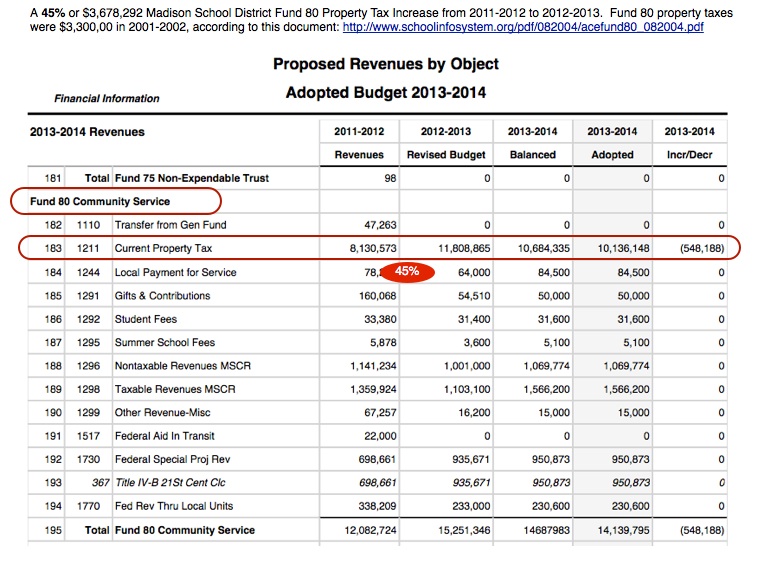
July, 2013 Madison Schools 2013-2014 Budget Presentation (PDF). Notes:
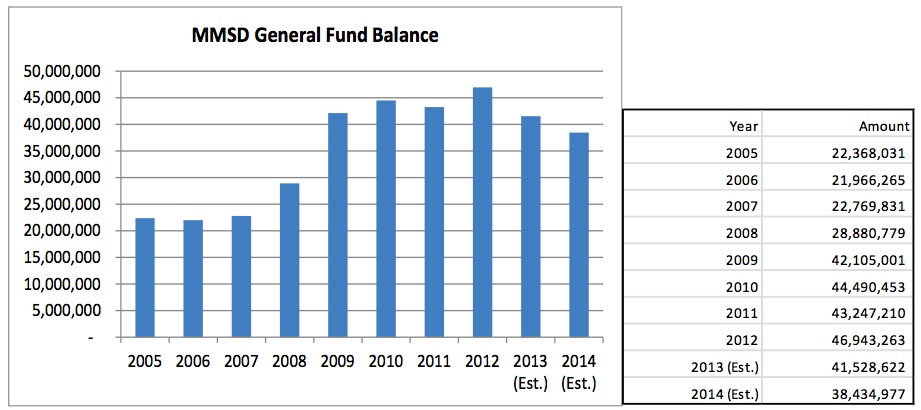
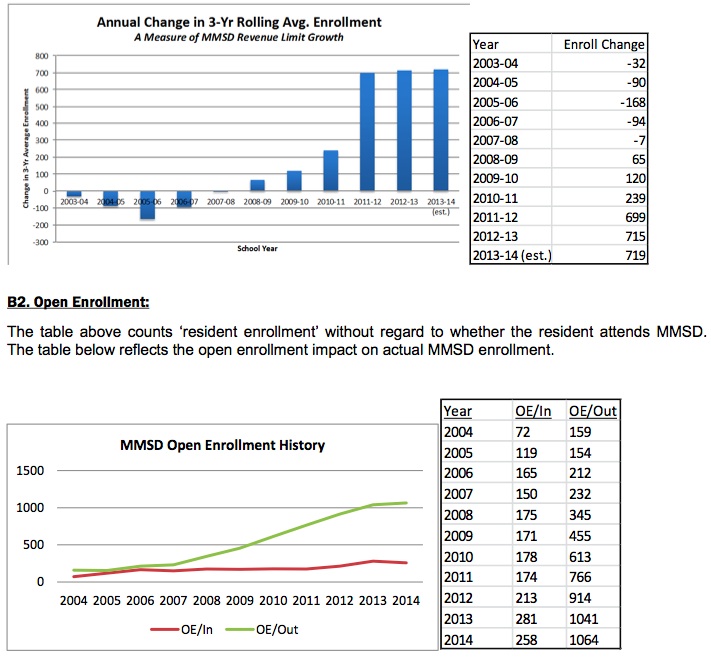


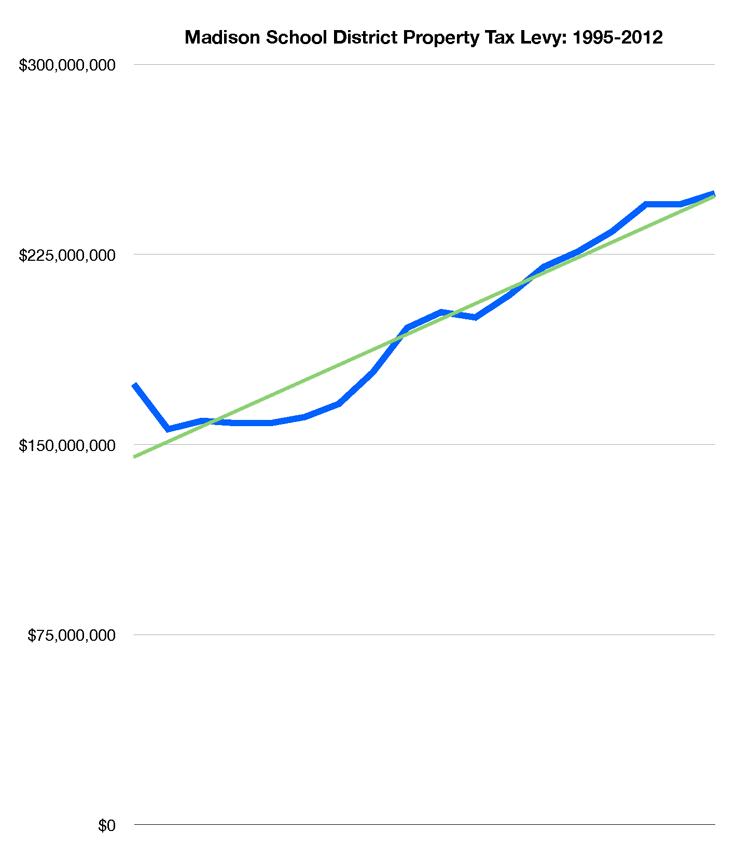
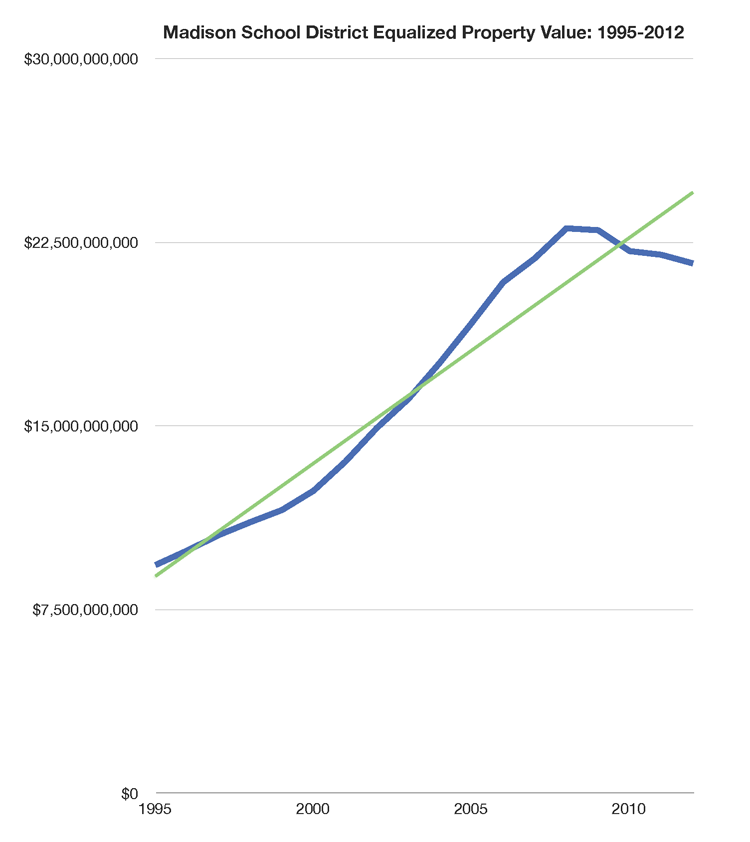
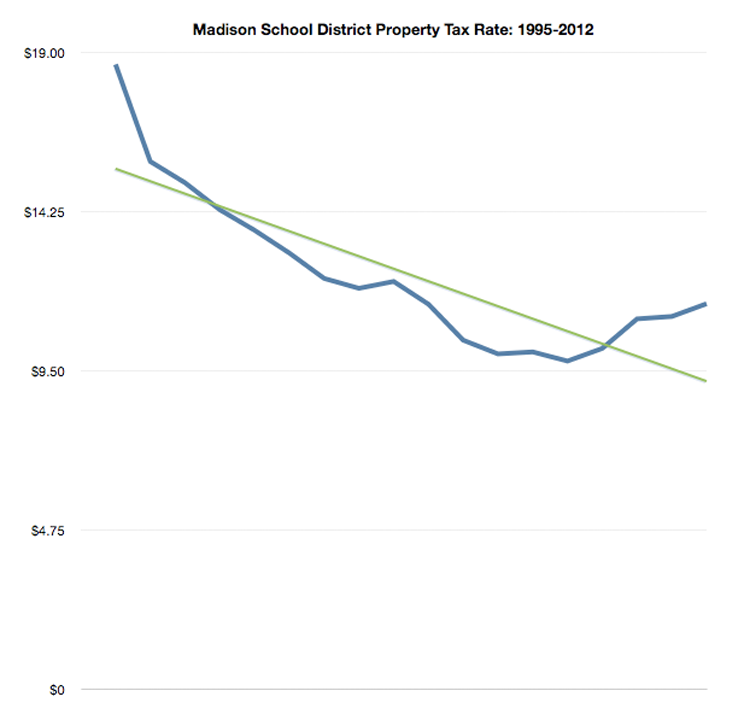
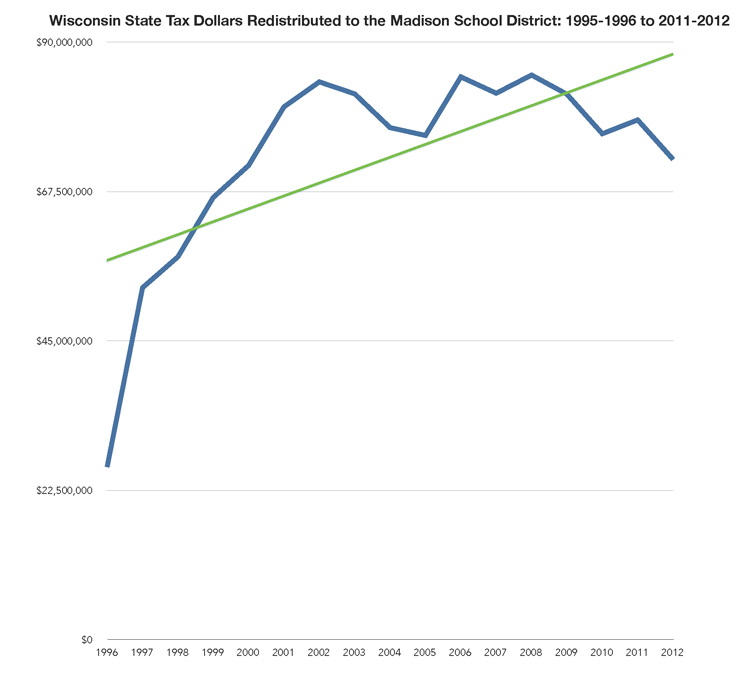

The January, 2012 budget document mentioned “District spending remains largely flat at $369,394,753” (2012-2013), yet the “baseline” for 2013-2014 mentions planned spending of $392,807,993 “a decrease of $70,235 or (0.02%) less than the 2012-13 Revised Budget” (around $15k/student). The District’s budget generally increases throughout the school year, growing 6.3% from January, 2012 to April, 2013. Follow the District’s budget changes for the past year, here.
Finally, the document includes this brief paragraph:
Work will begin on the 2014-15 early this fall. The process will be zero-based, and every line item and FTE will be carefully reviewed to ensure that resources are being used efficiently. The budget development process will also include a review of benefit programs and procurement practices, among other areas.
One hopes that programs will indeed be reviewed and efforts focused on the most urgent issues, particularly the District’s disastrous reading scores.
Ironically, the recent “expert review” found that Analysis: Madison School District has resources to close achievement gap. If this is the case (and I agree with their conclusion – making changes will be extraordinarily difficult), what are students, taxpayers and citizens getting for the annual tax & spending growth?
I took a quick look at property taxes in Middleton and Madison on a $230,000 home. A Middleton home paid $4,648.16 in 2012 while a Madison home paid 16% more, or $5,408.38.
Madison’s aid amount is about the same as it was in 2010-11. The district received a $15 million boost in aid last year mostly because 4-year-old kindergarten enrollment added about 2,000 students.
The Madison School Board taxed the maximum amount allowed last year, resulting in a 1.75 percent property tax increase. That amount was low compared to previous years because of the state aid increase. The additional funds allowed the district to spend more on building maintenance and a plan to raise low-income and minority student achievement.
Property tax increase coming
Cheatham said she hopes to propose a lower property tax increase than 6.8 percent when she introduces her budget on July 15. A group of local and national experts recently advised the district that it should reallocate more funding from the administration into classrooms. Cheatham expects to do a deeper review of district finances for the 2014-15 budget.
“I would not be reluctant to ask the taxpayers of Madison to support us with additional funding moving forward if I knew that we were spending every dollar in the best possible way to support the students in our school district,” Cheatham said. “I’ll know that next budget cycle.”
To reduce the budget, Cheatham said she doesn’t expect any major changes that will affect classroom learning.
Instead she could cut a 1.5 percent proposed increase in the employee salary schedule, reduce maintenance spending or make some previously recommended reductions in administrative positions.
Much more in the 2013-2014 budget, here.
Related: Up, Down & Transparency: Madison Schools Received $11.8M more in State Tax Dollars last year, Local District Forecasts a Possible Reduction of $8.7M this Year.
Madison spends significantly more per student than most districts. Property taxes were increased 9% just a few years ago.
Finally the ongoing tax increases may play a role in Madison School Board member Mary Burke’s rumored race for Governor.
Wages fall at record pace.
Madison’s long term disastrous reading scores.
The Madison School District has the money to improve low-income and minority student achievement but needs to reorganize its central administration to put more resources in the classroom, according to a group of local and national education experts who conducted a district review.
“We’re recommending the system turn on its head,” said Robert Peterkin, the former director of Harvard University’s Urban Superintendents Program who led the review team.
New Madison schools superintendent Jennifer Cheatham, a graduate of the Harvard program, organized the team of experts as part of her transition. She plans to consult their recommendations before releasing next month a set of specific strategies and 2013-14 budget proposal.
According to the team’s analysis, students need to be at the top of the “power pyramid” rather than district administration, with the focused goal of turning out graduates ready to attend college or start a career.
Central office administrators need to spend more time in the classroom and cut down on new programs that contribute to what teachers call “initiative fatigue.”
Principals should have more input into hiring a more diverse staff. Teachers need more focused professional development. And all district employees need specific goals that can be measured and used to hold them accountable.
Students also need “demand parents” who take an active role, not only in school bake sales and sports, but in understanding the curriculum and educational goals for their students.
“Resources even in this environment can be brought to bear from existing dollars to your more focused set of goals and activities, rather than supporting proliferation of those activities,” Peterkin told the Madison School Board on Monday night.
Cheatham said the review team had not taken a deep enough look at district finances to conclude that funding is available, but based on her assessment of the budget so far, she said the conclusion was “fairly accurate.”
“The recommendations from the transition team warrant a deep look at the central office organization and our allocation of resources,” she said.
The “Transition Team” Report (3MB PDF) and Superintendent Cheathem’s “Entry Plan” summary.
Related:
Madison’s disastrous long-term reading results.
Deja Vu: A Focus on “Adult Employment” or the Impossibility of Governance Change in the Madison Schools.
Madison has long spent more per student than most districts. The most recent 2012-2013 budget, via a kind Donna Williams and Matthew DeFour email is $392,789,303 or $14,496.74 per student (27,095 students, including pre-k).
Fresh off a two-month tour to observe the operations of all 48 schools, various programs, and the Madison School District’s central administrative offices, Superintendent Jennifer Cheatham is promising to “ensure accountability at every level.”
Accountability as Cheatham describes it will include student achievement on standardized tests of the type that current school reform movements emphasize, but will go far beyond that to a new understanding of educators’ roles, the support they need to master them, and refined local measures of progress, she said.
“I worry that people perceive accountability as standardized test results, for example, and what I’m talking about is accountability for everybody playing well the function they are best positioned for in the service of children learning well,” Cheatham told me Thursday in an interview. “Educators at every level of the system lack clarity on what that particular function is for them.”https://www.schoolinfosystem.org/archives/2013/06/deja_vu_a_focus.php”>Accountability was one of five priority areas Cheatham identified in anEntry Plan Report released Wednesday. The others are: well-rounded, culturally responsive instruction; personal educational pathways for students; attracting, developing and retaining top-level talent; and engaging families and community members as partners.
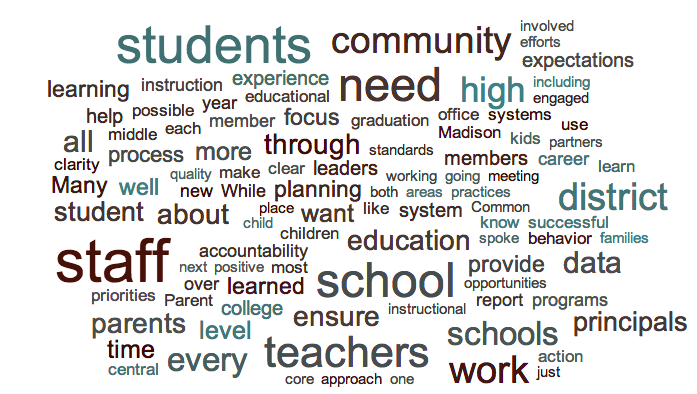
Madison Superintendent Jennifer Cheatham (PDF):
Strengths
Overall Themes
Quality of teachers, principals, and central office staff: By and large, we have quality teachers, principals, support staff and central office staff who are committed to working hard on behalf of the children of Madison. With clarity of focus, support, and accountability, these dedicated educators will be able to serve our students incredibly well.
Commitment to action: Across the community and within schools, there is not only support for public education, but there is also an honest recognition of our challenges and an urgency to address them. While alarming gaps in student achievement exist, our community has communicated a willingness to change and a commitment to action.
Positive behavior: District-wide efforts to implement an approach to positive student behavior are clearly paying off. Student behavior is very good across the vast majority of schools and classrooms. Most students are safe and supported, which sets the stage for raising the bar for all students academically.
Promising practices: The district has some promising programs in place to challenge students academically, like our AVID/TOPS program at the middle and high school levels, the one-to-one iPad programs in several of our elementary schools, and our Dual Language Immersion programs. The district also does an incredibly successful job of inclusion and support of students with special needs. Generally, I’ve observed some of the most joyful and challenging learning environments I’ve ever seen.
Well-rounded education: Finally, the district offers a high level of access to the arts, sports, world language and other enriching activities that provide students with a well- rounded learning experience. This is a strength on which we can build.
“AVID is totally paying off. Kids, staff, everyone is excited about what it has brought to the school.” – Staff member
“Positive Behavior Support has made a dramatic improvement in teaching and the behavior expected. We’ve seen big changes in kids knowing what is expected and in us having consistent, schoolwide expectations”
– Staff member
Challenges
Focus: Principals, teachers and students have been experiencing an ever-changing and expanding set of priorities that make it difficult for them to focus on the day-to-day work of knowing every child well and planning instruction accordingly. If we are going to be successful, we need to be focused on a clear set of priorities aimed at measurable goals, and we need to sustain this focus over time.
“One of the strengths of MMSD is that we will try anything. The problem is that we opt out just as easily as we opt in. We don’t wait to see what things can really do.”
– Staff member
Coherence: In order for students to be successful, they need
to experience an education that leads them from Pre-Kindergarten through 12th grade, systematically and seamlessly preparing them for graduation and postsecondary education. We’ve struggled to provide our teachers with the right tools, resources and support to ensure that coherence for every child.
Personalized Learning: We need to work harder than ever to keep students engaged through a relevant and personalized education at the middle and high school levels. We’ve struggled to ensure that all students have an educational experience that gives them a glimpse of the bright futures. Personalized learning also requires increased access to and integrated use of technology.
Priority Areas
To capture as many voices as accurately as possible, my entry plan included a uniquely comprehensive analysis process. Notes from more than 100 meetings, along with other handouts, emails, and resources, were analyzed and coded for themes by Research & Program Evaluation staff. This data has been used to provide weekly updates to district leadership, content for this report and information to fuel the internal planning process that follows these visits.
The listening and learning phase has led us to five major areas to focus our work going forward. Over the next month, we’ll dive deeper into each of these areas to define the work, the action we need to take and how we’ll measure our progress. The following pages outline our priorities, what we learned to guide us to these priorities and where we’ll focus our planning in the coming month.
Matthew DeFour collects a few comments, here.
Much more on Madison’s new Superintendent Jennifer Cheatham, here.
Madison Superintendent Jennifer Cheatham (PDF):
his report presents high school graduation rates for the Madison Metropolitan School District. For additional information on graduation rates, see the Appendix.
For this report, we focus on a cohort of students expected to graduate at the end of the 2011-12 school year. For additional context and to track changes over time, we provide a three-year history for some measures. This report uses publicly available data from Wisconsin’s Information Network for Successful Schools (WINSS). Additional data is available
through http://winss.dpi.wi.gov/. Key findings include the following:
1. Overall graduation rates improved almost one percent from 2011 to 2012, from 73.7% to 74.6%.
2. African American and Hispanic students have improved their graduation rates by five percent and almost seven percent over the last three years.
3. Graduation rates for students with Limited English Proficiency have improved about four percent over the last three years.
4. MMSD high schools have similar graduation rates, ranging between 74.7% and 82.8%.
The rumor that a national school reform effort moving through Madison would wipe out treasured class electives at West High School has been buzzing in that community for years.
Parents and students got a chance to bring their concerns about the implementation of Common Core standards to the top Thursday evening, during a conversation with new Madison School District Superintendent Jennifer Cheatham, held in the school library after her day-long visit to West High.
It was the second in a series of four public meetings being held at the city’s public high schools this spring to allow Cheatham, who started work in the district on April 1, to hear community concerns.
Cheatham told the crowd of 150 or more that she had heard a lot that day from students and staff about the “amazing potpourri” of elective courses at West.
“They think they are a major asset of the school. I think so too,” she said.
West High School’s elective courses are so popular among students that speculation the Common Core standards would be their death knell fueled a sit-in of some 500 students in fall 2010, the year the state adopted the standards. Today, many of Madison’s public schools are still figuring out a way to incorporate the standards, about which confusion reigns among students, parents and teachers.
Lynn Glueck, a school improvement coordinator at Memorial High School, said this week that Common Core focuses on developing key skills needed for college and career readiness. The standards related to English language arts, for example, are about “close reading, critical thinking and argumentative writing where students pull evidence out of the text,” Glueck said.
In the instances where Common Core has been used at Memorial, which some say is leading the district in implementing the standards, “students are really engaging in it,” she said.
Fascinating. 2006: The movement toward one size fits all via English 10. 2013: “West High School’s elective courses are so popular among students”.
Additional and informative background here.
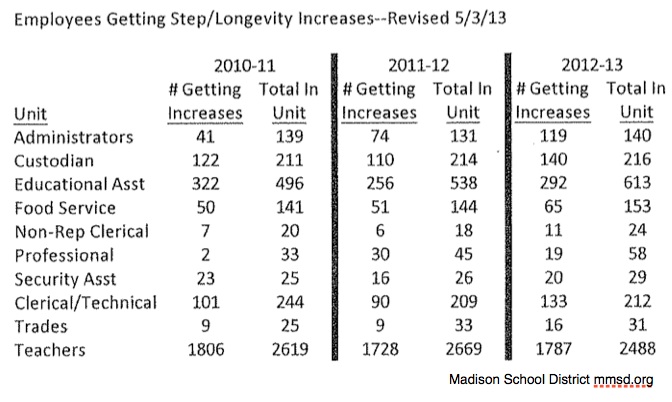
Steve Hartley, Madison Schools Chief of Staff:
Attached is a spreadsheet listing questions received from BOE members to date and some of our responses. Over the course of the next two months, we will continue to collect your questions and respond at both Operational Support and Regular Board meetings.
Madison Superintendent Jennifer Cheatham (PDF):
The draft budget included several new positions for the Board’s consideration. After refining and prioritizing with staff and vetting with principals, we are only asking for approval of two essential positions at this point. The position changes represent a savings of just over $2 million from the draft budget.
As we prepare for next year, we must keep our efforts and resources focused on providing supports to schools to improve instruction. We must also be responsible stewards of taxpayer dollars by reducing the impact of our budget.
To get to these recommendations, we conducted a rigorous examination of positions funded in the draft budget to decide what we believe is absolutely necessary right now. Much of the work we need to do next year is about improving the systems and structures for how we serve students, not adding additional resources. It will be critical going forward that we narrow our focus to the strategies that we know work, implement them well and sustain the focus over time.
So far, we have only considered the position decisions that we need the Board to approve. Over the next two months, we will continue to work through the draft budget in order to reduce the tax impact and align with our efforts for next year. Also, we have only reviewed positions based on the draft budget. Next year, we plan to engage in a more thorough, zero-based budgeting process.
Position Additions from Draft Budget that are No Longer Recommended
There are several positions included in the draft budget that we are no longer recommending at this point. In looking at specific positions, we considered our ability to carry out necessary work through more efficient systems and in some cases, the need to pause and re-consider our approach.
With that in mind, we are no longer recommending going forward with the following position additions that were included in the draft budget. Because these were new positions in the draft budget, they do not have staff in them currently and do not require any layoffs.
Mental Health Coordinator: Through redistribution of work in student services, we will be able to provide support to implementation of the Mental Health Task Force’s work.
Safety Coordinator: We will continue to coordinate efforts across the organization to ensure safety.
Perhaps a positive sign “we must keep our efforts and resources focused on providing supports to schools to improve instruction”. Reading is surely job one, as the District’s long term disastrous reading scores illustrate.
March, 2013 Madison Schools’ financial reports (PDF).
Related: Status Quo Costs More: Madison Schools’ Administration Floats a 7.38% Property Tax Increase; Dane County Incomes down 4.1%…. District Received $11.8M Redistributed State Tax Dollar Increase last year. Spending up 6.3% over the past 16 months.
Commentary on Madison School Board Member Ed Hughes’ Teacher Salary Increase Words.
Madison Superintendent Jennifer Cheatham (PDF):
This report includes data from the Fall 2012 Wisconsin Knowledge and Concepts Examination (WKCE). In this report, we focus on reading and math scores. Students in grades 4, 8, and 10 also take Science, Social Studies, and Language Arts tests, but these tests are not used for school accountability in the same manner as Reading and Math tests and are not aligned to the new rigorous standards, so they are not directly comparable.
This year, WKCE results reflect the state’s transition to the Common Core State Standards in that DPI has adjusted the cut scores for each performance level to reflect higher expectations for student proficiency. As a result, MMSD’s scores (and scores for every district in the state) look very different from prior years.
1. The new cut scores can be applied to last year’s scores to provide a more meaningful year-to-year comparison. Scores have remained roughly unchanged from last year when the same scale is used.
2. Achievement gaps between subgroups of students exist across grades and locations and show few signs of either increasing or decreasing.
3. Scores showed some changes from last year at the building level, but these changes were mostly small.
4. Schools with more students scoring “Advanced” in Fall 2011 faced smaller negative impacts from the new performance cut scores.
In addition, overall proficiency rates in MMSD are close to state averages. Asian and White students in MMSD significantly outperform the state averages for their racial groups in both Reading and Math. In addition, large achievement gaps exist statewide as well as within MMSD.
Much more on the oft-criticized WKCE, here.
Madison School Board Member Ed Hughes:
Here in Madison, our attention is primarily focused on our troubling achievement gaps, and those gaps are achingly apparent in the new WKCE scores. Under new superintendent Jen Cheatham’s leadership, we’ll continue to pursue the most promising steps to accelerate the learning of our African-American, Latino and Hmong students who have fallen behind.
At the same time, we also need to continue to meet the needs of our students who are doing well. I am going to focus on the latter groups of students in this post.
In particular, I want to take a look at how our Madison students stack up against those attending schools in other Dane County school districts under the new WKCE scoring scale. The demographics of our Madison schools are quite a bit different from those of our surrounding school districts. This can skew comparisons. To control for this a bit, I am going to compare the performance of Dane County students who do not fall into the “economically disadvantaged” category. I’ll refer to these students as “non-low income.”
I took a quick look at property taxes in Middleton and Madison on a $230,000 home. A Middleton home paid $4,648.16 in 2012 while a Madison home paid 16% more, or $5,408.38. Local efforts to significantly increase property taxes may grow the gap with Middleton.
Madison School District property taxes for 2013 could increase 7.4 percent under budget recommendations being presented Monday to the Madison School Board.
That would be the biggest percent increase in the district’s property tax levy in a decade. Taxes on an average Madison home valued at $230,831 would total $2,855, a $182 increase from last year.
However, district officials cautioned the numbers likely will change once the state budget is finalized and new superintendent Jennifer Cheatham conducts a review of the district.
“Before I can feel comfortable recommending a tax increase I would want to make sure that every dollar is spent effectively and I can feel confident that the funds that we’re investing are going to pay off for students,” Cheatham said.
Did you get a 7.4% pay raise this year? State employees have forgone a pay raise the last couple years. They had to reach in their pockets to pay new health insurance and pension co-pays. Annuitants covered by the Wisconsin Retirement System have been treading water since 2009. Those who retired nine or more years ago are facing a 9.6% reduction in their pensions. Many of those, ironically, are retired teachers.
Yet the Madison School Board proposes a 1.5% across-the-board pay increase. Actually, reporter DeFour underreported the proposed pay increase. Add another 1% for the “step” increases to account for longevity to equal a 2.5% increase. Almost uniquely among taxpayer-supported employees these days, the district’s teachers still would pay nothing toward their generous health insurance benefits. Job security is nearly guaranteed. Meanwhile, the district acts as bagman for union boss John Matthews, deducting dues from teacher paychecks.
Can we expect the district to end that statutorily forbidden practice when the current contract expires after this June? Let’s hope so, unless the district hides behind Dane County Judge Juan Colas’ Act 10 ruling.
What would get the axe? Parent-teacher conferences. So much for addressing the achievement gap.
The way Principal Michael Hernandez tells it, something had to go.
Hernandez decided that at Sherman Middle School, it will be French class.
With a renewed emphasis on curriculum basics in the Madison School District, the need at Sherman to double-down on math skills, and a scheduled expansion there of the AVID program that prepares low-income minority kids for college, Hernandez figures the north-side middle school will need to drop its second “world language” offering next year.
French 2 will continue for seventh-graders who took French 1 this year. The school’s Spanish-language program — including three sections of dual-language instruction — also will continue.
“Unfortunately, there are tough decisions we have to make,” Hernandez told me. “With budget cuts, I can’t have a class with only approximately seven students, when I could use that (staff) allocation for a math intervention class.”
Principals will be developing these kinds of adjustments around the margins to prepare for the 2013-2014 school year as district officials begin work on the budget and schools get projections on how many staff members they will have.
School Board members on Monday will receive a “budget briefing” instead of fleshed-out budget proposal. Penciled in is $392,807,993 in district-wide spending next school year, down a fraction from this year.
The scaled-down budget proposal is due to the uncertain prospects of a controversial proposal in Gov. Scott Walker’s budget to shift aid and expand vouchers to Madison and eight other school districts — at a projected cost of more than $800,000 to the Madison public schools. In addition, new Superintendent Jennifer Cheatham just came on the job three weeks ago and is not prepared yet to present a detailed budget.
Superintendent’s Teaching and Learning Transition Team to Begin Work This Week
A group of national and local education experts will support Superintendent Jennifer Cheatham’s entry plan work, the district announced today. The Superintendent’s Teaching and Learning Transition Team will begin work this week.
“Instruction and leadership are critical components of systemic improvement,” Superintendent Cheatham said. “This team of local and national practitioners will join district and school staff in assessing and analyzing strengths, areas of opportunities and priorities for improving teaching and learning in Madison schools.”
The eight member team brings together education experts from Harvard University and the University of Wisconsin-Madison, as well as educational practitioners from other urban school districts.
“We are fortunate to have access to national experts with a wide range of expertise from standards based instruction and leadership development, to bilingual and special education, to family and community involvement,” Cheatham said. “This team will help to deepen and strengthen my ongoing understanding of the strengths and challenges of our district. Their national perspective, coupled with the local perspective shared by principals, staff, parents and community members, will support us in narrowing our focus to only the most high leverage strategies for ensuring every student is college and career ready.”
The team, which was selected by the superintendent and will be funded through community and private foundations, will be chaired by Dr. Robert Peterkin, Professor Emeritus of the Harvard Graduate School of Education and includes: Maree Sneed, partner at Hogan and Lovells US LLC; John Diamond, sociologist of education at the Harvard Graduate School of Education; Sheila Brown, Co-Director at the Aspen Institute’s Education and Society Program; Allan Odden, Professor of Educational Leadership and Policy Analysis at the University of Wisconsin-Madison; John Peterburs, Executive Director of Quarles & Brady; Wilma Valero, Coordinator for English Language Learner Programs in Elgin, Il; and Gloria Ladson-Billings, Professor of Urban Education at the University of Wisconsin-Madison.
As Superintendent Cheatham continues the listening and learning phase of her entry plan, the Teaching and Learning Transition Team will also meet with central office leaders, conduct focus groups with teachers, principals, and parents as needed, and review a variety of relevant data.
At the end of their work, the team will present the superintendent with a report of what they have learned and recommendations for moving forward systemically with best practices. That report will be used, along with data collected by the superintendent in school visits and other entry plan activities, to refine the district’s goals and strategic priorities.
Related:
FOR IMMEDIATE RELEASE
THURSDAY, MARCH 1, 2001 (additional background here)
Updated Strategic Plan Results in Priority Action Teams
Five Strategic Priority Action Teams, centered around the most critical challenges facing the Madison Metropolitan School District, are among the outcomes of the recently-completed strategic plan.
“The immediate and emerging challenges facing the district are addressed in our revitalized strategic plan,” said Superintendent Art Rainwater, “and the Action Teams are focused on five important priorities for us.”
The five strategic priorities are:
Instructional Excellence – improving student achievement; offering challenging, diverse and contemporary curriculum and instruction
Student Support – assuring a safe, respectful and welcoming learning environment
Staff Effectiveness – recruiting, developing and retaining a highly competent workforce that reflects the diversity of our students
Home and Community Partnerships – strengthening community and family partnerships and communication
Fiscal Responsibility – using resources efficiently and strategically
The five Strategic Priority Action Teams, one for each of the five priorities, are taking on the responsibility for continuous improvement toward “their” priority.
The Action Teams, which will have both staff members and non-staff members, will be responsible for existing initiatives. In addition they will identify and recommend benchmarks to use in assessing school district performance.
“We have a huge number of initiatives,” said Rainwater. “This strategic plan gives us a systemic approach to change, so that every initiative, everything we do, leads us to these established goals. I believe it is critical to our district’s success that we follow this strategic plan and use it as a decision filter against which we measure our activities.”
Two other outcomes from the updated strategic plan are:
a set of beliefs about children, families, enhanced learning, and the quality of life and learning, all of which are integrated with an identified District vision and mission.
improved cost efficiency and effectiveness of many central office functions, which are being addressed on an ongoing basis.
Madison Schools’ initial strategic plan came about in 1991, and provided direction until this update.
“As a result of this project,” said Rainwater, “all of us who are stakeholders — parents, students, teachers and staff, administrators and community members — will share a renewed sense of clarity, while seeing an ever-more efficient deployment of resources.”
You can see the complete strategic plan on the district’s Web site: http://www.mmsd.org.
Amid the picket signs Madison teachers carried at a rally last month protesting slow-moving contract talks, some teachers also carried a bright purple flier.
On one side was written the heading “standards and benchmarks.” On the other, “Dimensions of Learning.” Beneath each, and filling the entire page, was one uninterrupted string of text: “Blah, Blah, Blah, Blah. . . .”
While hardly erudite — some would call it juvenile — the flier expressed the sentiment many teachers have toward two of Superintendent Cheryl Wilhoyte’s biggest initiatives: the effort to create districtwide academic standards, and the teacher-training program that goes along with it.
Neither issue is a subject of bargaining. But the programs have become a sort of catch-all target for teachers who blame Wilhoyte for everything from the poor state of labor-management relations to the current contract impasse.
Wilhoyte, who was hired in part to implement the district’s 1991 strategic plan, including establishing rigorous standards, says carrying out that plan is central to the compact she has with the …
Wilhoyte, on the other hand, has demonstrated that she is a tough, hands-on administrator in her role as assistant superintendent for instruction and school administration in Anne Arundel County, Maryland. And even those who have tangled with her praise her philosophy, which is to put kids first.
She has been a leader in Maryland in shaking up the educational status quo, of moving it forward to meeat the needs of the children, even while juggling new programs with budget cuts. The big question remaining about her: She has never been a superintendent. How would she handle the top job?
Matthew DeFour summarizes and collects some feedback on the District’s press release here. It would be useful to dig into the archives and review the various strategic plans and initiatives over the years and compare the words and spending with results.
Deja vu.
You’ll find Jennifer Cheatham, new superintendent of the Madison School District, at the Capitol Wednesday when local education officials talk about how Gov. Scott Walker’s proposed budget would hurt Dane County schools.
But don’t expect her to be spending much time making political statements, Cheatham told me and other staff members of the Cap Times Tuesday. Too much focus on politics would distract her from her work in the Madison schools, she said.
“I think my major role is to work on improving schools in Madison. That’s why I was hired and I need to remain focused on that,” Cheatham said. “But I do think there are times it is important for me to voice my opinion on behalf of the school district on state issues.”
That includes the Walker education budget.
Cheatham is scheduled to be on hand at noon Wednesday when School Board members, superintendents, parents and other advocates from around Dane County talk about the impact of Walker’s education proposals in Room 411, the large Senate meeting room.
The Madison School Board has already actively lobbied against the Walker budget, urging local legislators not to support a plan that is “bad for our students, our taxpayers and the future of public education.”
Board members say expanding vouchers into Madison, as Walker has proposed, is a particularly bad idea. They note there’s no consistent evidence that kids using publicly funded vouchers to attend private schools do better academically, and they say that funding vouchers is likely to raise local property taxes.
It’s not just school officials who are weighing in on the highly politicized issue of school vouchers. The Madison City Council passed a resolution last month, sponsored by all 20 members, opposing expansion of vouchers to Madison. The Dane County Board is considering a similar resolution.
Reading has been job one for quite some time, unfortunately.
Right to read lawsuit filed in Michigan.
Jen Cheatham, who started Monday as Madison’s new schools superintendent, said she was planning to visit each of the district’s schools by the end of May.
The visits will include community meetings at each of the district’s high schools, allowing parents and community members to share what’s working and what needs to improve in the district, Cheatham said.
“It’s important to me to learn about what’s working and what isn’t working,” Cheatham said. “Often, new superintendents make changes to things that are actually beneficial to the district — unknowingly.”
Cheatham said she would start working soon with the school board on a list of priorities, which would include bridging the district’s minority achievement gap. The board will have at least two new members after Tuesday’s spring election, with Maya Cole and Beth Moss retiring.
The superintendent warned that state funding cuts, which district administrators have estimated will cost Madison schools about $8 million next year, may force the district to raise property taxes. She called Gov. Scott Walker’s school voucher proposal “a real threat to the quality of education we can provide.”
Related: Up, Down & Transparency: Madison Schools Received $11.8M more in State Tax Dollars last year (2012), Local District Forecasts a Possible Reduction of $8.7M this Year.
One would hope that the new Superintendent’s job 1 is addressing the District’s long term disastrous reading results.
“I have no doubt that the way we’re going to improve student achievement is by focusing on what happens in the classroom,” Cheatham said.
Clash with unions
Madison Teachers Inc. executive director John Matthews and others say poverty drives the achievement gap more so than classroom factors.
“We do have a high-quality teaching force in Madison — it’s been that way for years,” Matthews said. He added that one challenge he’d like to see Cheatham address is the administration’s tendency to adopt new programs every few years.
Cheatham’s salary will be $235,000, 17 percent more than predecessor Dan Nerad. Unlike Nerad, a former Green Bay social worker and superintendent, Cheatham has never led an organization. She also hasn’t stayed in the same job for more than two years since she was a teacher in Newark, Calif., from 1997 to 2003.
Mitchell, who beat out Cheatham for the top job at Partners in School Innovation where she worked for a year before moving to Chicago, said Cheatham has the talent to become schools chief in a major city like Chicago or New York in seven to 10 years. That’s a benefit for Madison because Cheatham is on the upswing of her career and must succeed in order to advance, Mitchell said.
“The thing about Madison that’s kind of exciting is there’s plenty of work to do and plenty of resources with which to do it,” Mitchell said. “It’s kind of a sweet spot for Jen. Whether she stays will depend on how committed the district is to continuing the work she does.”
Related: A history of Madison Superintendent experiences.
I asked the three (! – just one in 2013) 2008 Madison school board candidates (Gallon, Nerad or McIntyre), if they supported “hiring the best teachers and getting out of the way”, or a “top down” approach where the District administration’s department of “curriculum done our way” working in unison with Schools of Education, grant makers and other third parties attempt to impose teaching models on staff.
Union intransigence is one of the reasons (in my view) we experience administrative attempts to impose curricula via math or reading “police”. I would prefer to see a “hire the best and let them teach – to high global standards” approach. Simplify and focus on the basics: reading, writing, math and science.
f you are tired of all the talk about the achievement gap in our school district, take heart. Newly appointed Superintendent Jennifer Cheatham’s entry plan is a promising beginning.
From racial disparities in academics to the race politics in the School Board primary election, the feeling of frustration has been palpable. The YWCA Madison suggests the reason this talk hasn’t created much tangible progress is that these issues are part of a larger system of racial inequalities. Individual strategies, action plans or initiatives are less likely to be successful if they are not part of a larger racial equity strategy.
So we are delighted to see Cheatham’s plan is based on values including commitment to equity and systemic improvement. If our community is serious about racial equity in education, we will join Cheatham in learning what kids of color need to be successful, and then making those resources and solutions the priority.
We will also consider every education-related decision and discussion with racial equity in mind. We will think holistically about Dane County’s future as a more racially diverse community and welcome and retain professionals, including educators, of color.
Let’s be part of a community-wide commitment to equity, and let’s remember that we’re doing it for the kids.
Related: And, so it continues.
But Cheatham, who served as what amounts to an area superintendent overseeing 25 schools and later as chief of instruction and curriculum for the entire 400,000-student, $5.1 billion-budget school system, not only got strong recommendations, she demonstrated intellect and ideas to Madison school officials, Passman said. The Madison School District, in comparison, has a $376 million budget and an enrollment of about 27,000.
Board member Mary Burke told me she wasn’t thrilled at first to be considering a candidate from the perennially troubled Chicago Public Schools. “I feel Madison is the type of district that should be able to attract people from the best school districts,” Burke said. So she used a method that had served her well in hiring situations over a career that has included executive positions in the private and public sectors: Burke and other School Board members went beyond resumes and references and contacted additional people Cheatham had worked with in the past.
“They were very consistent in terms of what they said: She’s a great instructional leader, really smart and hardworking, and the schools under her made incredible progress raising students’ level of achievement,” Burke told me.
Like the board members, I also turned to people Cheatham had worked with in Chicago to get a glimpse of how her skills and personality will dovetail with the Madison community.
Pat Schneider refers to the Madison School District’s $376,000,000 budget, yet Matthew Defour just a few days ago, put it at $394,000,000. A subsequent email from the District’s Donna Williams placed the 2012-2013 budget at $392,789,303 for approximately 27,000 students, or $14,547/student about 12% more than Chicago’s $12,750, according to Schneider’s article.
Many notes and links on Jennifer Cheatham, here.
The Wisconsin State Journal editorial board interviewed — in person — 20 candidates for the City Council and four for Madison School Board. Every candidate deserves praise for giving voters a choice.
Yet the candidates pictured below are best prepared to tackle local challenges, including a dismal graduation rate for minority students and the need for a stronger economy and more jobs.
Seat 3
Wayne Strong will bring urgency to narrowing the achievement gap for minority students in Madison schools, while insisting on high standards for all. A father of two Madison graduates and an active community volunteer, Strong served on the strategic committee that prioritized the gap for action. Strong promises more accountability for results, starting with the new superintendent. He also wants to improve the school climate for minority families to encourage more involvement. A retired police officer, he’s well versed on effective strategies for reducing conflicts in schools that often lead to suspensions — “the genesis of the problem.” Strong’s opponent, Dean Loumos, is impressive, too. But Strong seems more willing to try new strategies for success.
Seat 4
James Howard likes to focus on school data to inform board decisions, rather than relying on assumptions or bowing to political pressure. The longtime economist and father of Madison students doesn’t go along to get along. Yet his peers elected him board president, and he played a big role in hiring incoming Superintendent Jennifer Cheatham. Howard expects action toward better results for struggling students. He wants to hire more minority educators and let key staff work flexible hours to better engage parents. Unlike his opponent, Greg Packnett, Howard cites concern for the burden property taxes place on older homeowners. A legislative aide at the Capitol, Packnett shows promise. But Howard’s experience makes him the clear choice.
Much more on the 2013 Madison School Board election, here.
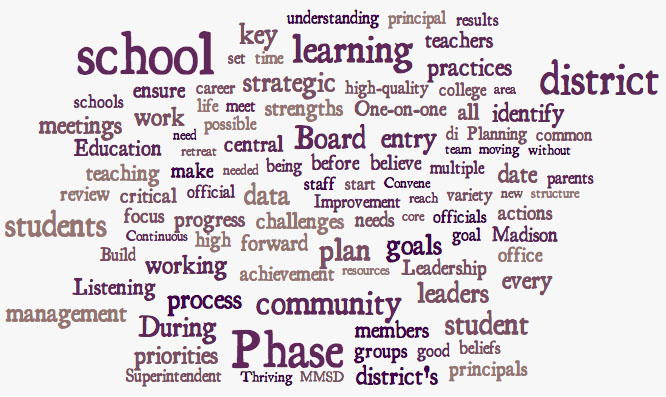
Incoming Madison Superintendent Jennifer Cheatham (1.4MB PDF):.
More from Matthew DeFour.
Much more on Jennifer Cheatham, here along with a history of Madison Superintendents.
Five candidates are competing for three seats on the Madison school board, with the general election on April 2, 2013.
The political context for the races is explosive, given Gov. Scott Walker’s revolutionary proposals for education in Wisconsin: cuts to public school funding, an expansion of the voucher program, and a revamping of teachers’ evaluations and bargaining rights.
In Madison, the issues are particularly complex, with the intense disagreements over the district’s achievement gap between white and minority students.
In the race for Seat 3, former La Follette High School teacher and low-income housing provider Dean Loumos is running against retired Madison police lieutenant Wayne Strong. The winner will replace retiring school board member Beth Moss.
In this competitive series of elections, there are numerous candidate forums and listening sessions under way, and we thought we’d pose our own questions to candidates.
This week, we ask the candidates about where they think incoming superintendent Jennifer Cheatham should direct her attention. We also ask about the changes in collective bargaining wrought by Act 10: How have they affected the district, and how should it respond to this new policy?
Much more on the 2013 Madison School Board election, here.
Five candidates are competing for three seats on the Madison school board, with the general election on April 2, 2013.
The political context for the races is explosive, given Gov. Scott Walker’s revolutionary proposals for education in Wisconsin: cuts to public school funding, an expansion of the voucher program, and a revamping of teachers’ evaluations and bargaining rights.
In Madison, the issues are particularly complex, with the intense disagreements over the district’s achievement gap between white and minority students.
TJ Mertz, an Edgewood College history instructor and education blogger, is running unopposed after Sarah Manski dropped out of the race for Seat 5 following the February primary. Her name will appear on the ballot, but she is moving to California. Mertz will replace retiring school board member Maya Cole.
In this competitive series of elections, there are numerous candidate forums and listening sessions under way, and we thought we’d pose our own questions to candidates. This week, we ask the candidates about where they think incoming superintendent Jennifer Cheatham should direct her attention. We also ask about the changes in collective bargaining wrought by Act 10: How have they affected the district, and how should it respond to this new policy?
Much more on the 2013 Madison School Board election, here.
Five candidates are competing for three seats on the Madison school board, with the general election on April 2, 2013.
The political context for the races is explosive, given Gov. Scott Walker’s revolutionary proposals for education in Wisconsin: cuts to public school funding, an expansion of the voucher program, and a revamping of teachers’ evaluations and bargaining rights.
In Madison, the issues are particularly complex, with the intense disagreements over the district’s achievement gap between white and minority students.
In the race for Seat 4, incumbent James Howard is running against Greg Packnett, a Democratic legislative aide.
In this competitive series of elections, there are numerous candidate forums and listening sessions under way, and we thought we’d pose our own questions to candidates. This week, we ask the candidates about where they think incoming superintendent Jennifer Cheatham should direct her attention. We also ask about the changes in collective bargaining wrought by Act 10: How have they affected the district, and how should it respond to this new policy?
Much more on the 2013 Madison School Board elections here.
I applaud the Wisconsin State Journal’s efforts to dig deeper into the Madison Superintendent search process. A kind reader pointed out to me how “shocking” it is that Barbara Thompson was NOT one of the two finalists.
The Madison School Board named these two finalists:
Jennifer Cheatham – apparently selected.
Walter Milton, Jr. – withdrew under a cloud of controversy.
from a larger group that included:
- Joe Gothard, Madison’s assistant superintendent for secondary education.
- Barbara Thompson, a former Madison principal and New Glarus superintendent who is currently superintendent in Montgomery, Ala.
- Tony Apostle, a retired superintendent from the Puyallup School District near Tacoma, Wash.
- Curtis Cain, administrator of the Shawnee Mission School District near Kansas City, Mo.
- Sandra Smyser, superintendent of Eagle County Schools in Eagle, Colo.
Madison has many wonderful traits. This town’s obsession with process is not one of them.
All indications are that the one remaining choice for the Madison public schools’ new superintendent, Dr. Jennifer Cheatham, would be a great pick. I’m told by people close to the decision that the Chief Instruction Officer for the Chicago Public Schools has been the top candidate all along, and that she is a “rock star” in the education world.
There is no job harder or more important in our city than being its schools superintendent. This is a city full of education experts whose child is clearly a genius (just like them) and yet isn’t being challenged enough by their teachers. At the same time, we have a growing number of poor kids who come to school without the basics, even a good breakfast. So, the challenge is to meet the high expectations of highly educated parents, while trying to give underprivileged kids the best chance possible to succeed, all in the context of constricted budgets.
At the same time, the stakes for our whole city are enormous. Failing public schools have been the downfall of dozens of American cities.
Much more on Madison’s most recent Superintendent search, here.
Madison Urban League, via a kind email:
The Urban League of Greater Madison strongly supports the Madison School Board’s decision to hire Dr. Jennifer Cheatham to serve as the next Superintendent of Schools of the Madison Metropolitan School District. Dr. Cheatham’s strong background in teacher quality, teacher evaluation, instructional leadership and organizing school system functions and operations around the educational and developmental needs of young people will be great assets for Madison’s public schools.
Kaleem Caire, President and CEO of the Urban League shared that, “Dr. Cheatham’s experience as a leader of teachers and her strong focus on improving instruction, implementing a rigorous curriculum for all students, ensuring teachers build strong and motivating relationships with children, and using data to inform teaching represent the core of what our school system needs right now.” Caire further stated that, “The Urban League believes that children in Madison deserve world class leadership, world class teachers and world class schools. Dr. Cheatham’s history and track record show that she shares a common belief in these ideals and what it takes to get there. We look forward to supporting her transition and welcoming her and her family to Madison.”
The Urban League is presently partnering with the Madison Metropolitan School District on the recruitment of high quality teachers and professional staff, preparing high school juniors and seniors for the ACT college entrance exam, and engaging parents of color in the work and decision-making of the school system. The Urban League also launched the Urban League Scholars Academy in January 2013 at Sennett and Toki Middle Schools, a program that extends the instructional day for 6th graders by 80 minutes in reading/language arts and mathematics. The League also operates the Schools of Hope tutoring program at 17 middle and high schools in Madison, Middleton, Oregon and Sun Prairie in partnership with these school districts, the United Way of Dane County and Madison School Community Recreation.
In her first visit to a Madison school, superintendent candidate Jennifer Cheatham met two La Follette High School students whom principal Chad Wiese said represent the district’s diversity and also its greatest challenge.
Senior Tanner Trickle, a basketball player and honors student, and junior Khaleah Monger, a varsity cheerleader, president of the black student union and an AVID/TOPS participant, led Cheatham on a tour of the school, highlighting a remodeled study hall, the gym and Lussier Stadium.
When Trickle told Cheatham he had applied to University of Chicago, Cheatham replied, “That was my first choice too. It didn’t work out at all.”
Nonetheless, Cheatham, 41, chief of instruction for Chicago Public Schools, received her bachelor’s degree from DePaul University in Chicago and earned graduate degrees from the University of Michigan and Harvard University.
Much more on Madison’s latest Superintendent search, here.
Five years ago, people were praising newly named Madison schools superintendent Dan Nerad as a paragon of listening skills and inclusiveness — a trained social worker who seemingly never burned a bridge in his life.
By contrast, Milton, the current superintendent at the Springfield (Ill.) school district, and Chicago School District administrator Jennifer Cheatham seem willing to upset the apple cart if they think it will help students.
School Board president James Howard told me the board’s focus was not to find candidates who would shake things up because, overall, Madison remains a quality district that doesn’t need a whole lot of shaking.
Rather “the issue” — or, as he later clarified, one the most important issues — “is one thing: the achievement gap.”
And the board certainly wanted to know if candidates had “the kind of will to make the kind of changes” to tackle that problem, he said. “To demonstrate success, you have to be from a district that has some diversity.”
Much more on the Madison School District’s latest Superintendent search, here.
School Board members and Ray and Associates, the consultant in the superintendent search process, have been under fire since Sunday when the district announced finalists Walter Milton Jr., superintendent of schools in Springfield, Ill., and Jennifer Cheatham, chief of instruction for the Chicago Public Schools.
Milton pulled his name from consideration late Tuesday, following days of online comment by Madison residents on incidents in his past. Those included a 2007 state audit finding of mismanagement at the New York school district he headed and his hiring of a former business partner who was a convicted sex offender while with the Flint, Mich., school district. according to news reports. Milton also had been questioned about inaccurate resumes in applying for previous jobs.
The question bandied about in comments to online stories is: If citizens could unearth these apparent red flags about Milton’s background on Google, why didn’t Ray and Associates?
Much more on Madison’s latest Superintendent search, here.
As a top Chicago Public Schools administrator visits Madison on Thursday to make her case to be the next Madison superintendent, questions linger about the School Board’s selection process.
The day after the other finalist for the job suddenly withdrew amid questions about his past, two Madison School Board members stood by the board’s decision to move forward with the visit by Jennifer Cheatham. The other five did not return calls seeking comment.
Board members Ed Hughes and Mary Burke also said they weren’t ready to pass judgment on the search consultant, Ray and Associates of Cedar Rapids, Iowa, after Walter Milton Jr., superintendent in Springfield, Ill., withdrew, and it was not clear how much board members knew about his background.
“We understand why people have questions about our process because it hasn’t gone as smoothly as we’d like,” Hughes said. “That said, I think we are excited about the possibility of Jennifer Cheatham. She sounds like she could be a terrific candidate.”
Much more on Madison’s latest Superintendent search, here.
Jennifer Cheatham links: Bing, Blekko, Clusty, Google, Twitter.
After paying an Iowa-based headhunting firm $30,975 to develop a candidate profile and launch a three-month nationwide recruitment effort, and after screening 65 applications, the Madison school board has narrowed its superintendent search down to two finalists. Dr. Jenifer Cheatham is chief of instruction for Chicago Public Schools, and Dr. Walter Milton, Jr., is superintendent of Springfield Public Schools in Illinois.
Parents and community members will get a chance to meet both finalists at a forum at Monona Terrace starting at 5:45 p.m. Thursday night. But despite the exhaustive and expensive search, the finalists aren’t without flaws.
Cheatham was appointed to her current post as chief of instruction in June of 2011 by Chicago Public Schools CEO Jean-Claude Brizard, who has since resigned. According to her Chicago district bio, Cheatham’s focus is improving urban school districts by “developing instructional alignment and coherence at every level of a school system aimed at achieving breakthrough results in student learning.” Cheatham received a master’s and doctorate in education from Harvard and began her career as an 8th grade English teacher. But she found herself in a harsh spotlight as Chicago Mayor Rahm Emanuel and district officials pushed for a contentious 7.5 hour school day last year, which became one of many big issues that led to the Chicago teachers strike in September.
“It was handled horribly in terms of how it was rolled out,” says Chicago attorney Matt Farmer, who also blogs about Chicago school issues for The Huffington Post.
Farmer says pressure was mounting last spring for the district to explain how the longer day would work and how it would be paid for. Cheatham was sent to a community meeting he attended on the city’s south side to explain the district’s position.
Some of candidate Walter Milton Jr.’s history a surprise to School Board president
Madison School Board president James Howard said Monday he wasn’t aware of some of the controversial aspects of Walter Milton Jr.’s history until after the board named him a finalist to be Madison’s next superintendent.
Prior to becoming superintendent in Springfield, Ill., Milton was criticized for hiring without a background check a colleague who had been convicted of child molestation in Georgia. The colleague, Julius B. Anthony, was forced to resign from a $110,000 job in Flint, Mich., after a background check uncovered the case, according to the Springfield State Journal-Register.
Milton and Anthony were former business partners and worked together in Fallsburg, N.Y., where Milton was superintendent before moving to Flint, according to news reports.
Steven Verburg: Jennifer Cheatham fought for big changes in Chicago schools:
“Jennifer Cheatham will be the third person in the last two years from our administration who I’ve been a reference for who has taken over a fairly significant school district,” Vitale said. “Chicago is a pretty good breeding place for leaders.”
A Springfield School District spokesman said Milton is declining interviews until a community forum in Madison on Thursday.
Prior to Fallsburg, Milton was a teacher and principal in his hometown of Rochester, N.Y. He received a bachelor’s degree in African history and African-American studies from Albany State University, a master’s degree in education from the State University of New York College at Brockport and a Ph.D. in education from the University of Buffalo.
Milton’s contract in Springfield expires at the end of the 2013-14 school year. His current salary is $220,000 plus about $71,000 in benefits.
School Board members want a superintendent with vision, passion and a thick hide
Madison School Board member Marj Passman says she was looking for superintendent candidates who have had experience working in contentious communities. “That’s important, considering what we’ve gone through here,” she told me Monday.
And what Madison schools are going through now.
The Madison Metropolitan School District had scarcely released the names of the two finalist candidates — Jennifer Cheatham, a top administrator in the Chicago Public School System and Walter Milton Jr., superintendent of the schools in Springfield, Ill. — before the online background checks began and comments questioning the competency of the candidates were posted. So the new Madison superintendent has to be someone who can stand up to public scrutiny, Passman reasoned.
And the issues that provoked the combative debate of the last couple of years — a race-based achievement gap and charter school proposal meant to address it that proved so divisive that former Superintendent Dan Nerad left the district — remain unresolved.
So, Passman figured, any new superintendent would need experience working with diverse student populations. Both Cheatham and Milton fit that bill, Passman says.
What are the odds that the traditional governance approach will substantively address Madison’s number one, long term challenge? Reading….
Much more on the latest Madison Superintendent search, here along with a history of Madison Superintendent experiences, here.
The Madison Metropolitan School District had scarcely released the names of the two finalist candidates — Jennifer Cheatham, a top administrator in the Chicago Public School System and Walter Milton Jr., superintendent of the schools in Springfield, Ill. — before the online background checks began and comments questioning the competency of the candidates were posted. So the new Madison superintendent has to be someone who can stand up to public scrutiny, Passman reasoned.
And the issues that provoked the combative debate of the last couple of years — a race-based achievement gap and charter school proposal meant to address it that proved so divisive that former Superintendent Dan Nerad left the district — remain unresolved.
So, Passman figured, any new superintendent would need experience working with diverse student populations. Both Cheatham and Milton fit that bill, Passman says.
Madison School Board members had 90-minute interviews with a pool of semifinalists before selecting Cheatham and Milton, and will interview them again on Thursday. The candidates also will appear at a public forum that starts at 5:45 p.m. Thursday at Monona Terrace Convention Center.
Much more on Madison Superintendents past, present and future, here.
The Madison Metropolitan School District has chosen the two finalists for the superintendent position, it was announced Sunday in a press release.
The two finalists are Dr. Jennifer Cheatham, chief of instruction at Chicago Public Schools, and Dr. Walter Milton, Jr., superintendent of Springfield (Ill.) Public Schools.
The public is invited to a public forum Thursday, Feb. 7 at 5:45 p.m. at the Monona Terrace to meet and ask questions of the two candidates. If you cannot attend the forum, you can email your comments or questions to board@madison.k12.wi.us.
Much more on Madison Superintendents.
A recent look at Madison Superintendent hires.
UPDATE: Samara Kalk Derby:
According to Cheatham’s biography on the Chicago Public Schools website, her focus is on “systemic improvement in urban school districts” and her expertise “lies in developing instructional alignment and coherence at every level of a school system aimed at achieving breakthrough results in student learning.”
She has worked as a Chief Area Officer for Chicago Public Schools and the executive director of Curriculum and Instruction for San Diego City Schools, the biography said. She has a bachelor’s degree in English from DePaul University, a master’s in education from the University of Michigan, and a master’s and doctorate in education from Harvard University.
According to a personal website promoting his book, “Me in the Making: One Man’s Journey to Becoming a School Superintendent,” Milton is a native of Rochester, N.Y., who earned a bachelor’s degree from the University of Albany and a master’s from SUNY College at Brockport. He took post-graduate courses at the University of Rochester to receive his administrative certifications, including his superintendent’s license. He holds a doctorate of education in leadership and policy from the University of Buffalo. He has also been a teacher and principal.
Google News on On Chicago & Dr. Jennifer Cheatham. More, here:Long on Class Time, Short on Answers .
Google News on Springfield Superintendent Walter Milton.
The selection of Joe Gothard as Madison’s next public schools superintendent has met with widespread praise, including from me. But digging a little deeper into his record raises some concerns.
Let’s start with the good stuff. Gothard has led the St. Paul school district since 2017. That district is bigger and more diverse than ours and so he should be up to the task here. In fact, Gothard was named Minnesota Superintendent of the Year and then won National Superintendent of the Year just before he was selected for the Madison job in late February.
In addition, Gothard is well known in Madison and, apparently, well-respected by many. He grew up here, went to Madison public schools, got his education degrees from Edgewood College, started his teaching career with MMSD, and had administration experience in the Doyle Building. In fact, he was a runner-up for the top job when the board picked Jen Cheatham instead back in 2013.
Now for the concerns.
Let’s start with that Superintendent of the Year award. It’s given out by the School Superintendents Association. The criteria for selection include leadership, communication, professionalism and community involvement. Notice what’s missing? None of the criteria for that award have anything to do with the actual success of students. And, in fact, the criteria the Madison school board developed for selecting the new superintendent didn’t include that either.
That was lucky for Gothard because St. Paul students are not performing well. Numbers available as of August 2023 showed that only 26% of St. Paul third through eighth graders were proficient in math, only 34% in reading and only 24% in science. In addition, only 57% of St. Paul students were showing up in school at least 90% of the time, compared to almost 70% statewide in Minnesota. The St. Paul math scores are even worse than Madison’s, and those lag both the state and national averages.
If you can keep your head when all about you are losing theirs, you’re not paying attention to the experts. Epidemiologists tell us that if we do not hide in our houses with the door securely locked, hundreds of thousands will surely perish. Economists tell us that if we do not return immediately to work, civilisation will collapse. Good luck figuring out which expert has the better advice. Is it any wonder a harried Michael Gove blurted out (1:02-1:15), “I think the people in this country have had enough of experts from organisations with acronyms saying they know what is best and getting it consistently wrong.”
Expert fear-mongering did not begin with the pandemic or Project Fear. In 1922, John Maynard Keynes warned that “squalor follows” if we do not make the economist “king.” Daniel Defoe complained of the “calculators” and “quack-conjurers” whose fear-mongering “kept up their trade” in London’s plague year of 1665. He shrewdly observed, “And had the people not been kept in fright about that, the wizards would presently have been rendered useless, and their craft had been at an end.”
Defoe complained of quacks and wizards, whereas today’s epidemiologists and economists have rigorous scientific training, mathematical models, advanced statistics, and careful evidence all going for them. True. But today’s scientists are still people. And that means they respond to incentives just like everyone else. The issue is not lying and cheating. Sure, some modern experts are quack-conjurers who lie and cheat. Let’s not mistake a white lab coat for a golden halo. But that’s not the main thing. Even when the experts are trying to be sober, scientific, and scrupulously neutral, they will feel certain pressures.
Think if it were you. You’re an epidemiologist and the prime minister calls to ask you how many will die if we don’t have a lockdown. What do you tell him? You can’t just look up the number. The pandemic is only now taking off and your knowledge of it is correspondingly sketchy. It’s hard to say. Every number is a guess. If you give the prime minister a low number, there will be no lockdown. What if he accepts your low number and we have no lockdown? Maybe everything will be fine. But maybe there will be many more deaths than you predicted. You will get blamed. People will shame you as a bad scientist. And, because you are a good and decent person, you will feel guilty. Blame, shame, and guilt. This is a bad outcome.
If you give him a high number, there will be lockdown. No one will ever be able to say that your estimate was too high, because your estimate assumed no lockdown. Even if a lot of people die during the lockdown you can say, “See? Think how much worse it would have been without the lockdown.” Thus, if you give the prime minister a high number, you will get credit for saving lives. You will be able to take pride in your sterling reputation as a scientist. And you won’t have to feel guilty about lost lives. Praise, pride, and innocence. This is a good outcome. The logic of the situation is clear. You have every incentive to predict doom and gloom if no lockdown is ordered.
It may be that the famous epidemiologist Neil Ferguson, who, until recently, was an important member of SAGE, has felt such pressures in his career. At one point in the pandemic he told a columnist for the New York Timesthat 1.1 million deaths was the “best case” for the US. In 2001 he blasted as “unjustifiably optimistic” a study suggesting that mad cow disease deaths “may peak at 100 cases per year in Britain and kill no more than a few thousand people in coming decades.” Rejecting this relatively optimistic view, he said deaths are in the long-term likely to be much higher at something only slightly less than 136,000. The true number as of June 2014 seems to have been 177. In 2005, he was alarmed by bird flu (H5N1). “Around 40 million people died in 1918 Spanish flu outbreak,” he told the Guardian. “There are six times more people on the planet now so you could scale it up to around 200 million people probably.” That’s a lot more than the World Health Organisation’s estimate for cumulative worldwide deaths, 2003-2020 of, ahem, 455.
Notes and links on Madison’s 2020 Superintendent search.
2013-2019: Jennifer Cheatham and the Madison experience.
Madison’s taxpayer supported K-12 school district, despite spending far more than most, has long tolerated disastrous reading results.
In addition, Madison recently expanded its least diverse schools.
In the words of the report, Montgomery County’s curriculum does “not include the necessary components to adequately address foundational skills.”
If you’re not immersed in these issues, you might not recognize just how scathing this language is. Montgomery County fails to do what just about all cognitive scientists and most reading researchers agree is critical to ensuring that children learn to read.
In addition, the report said that MCPS provided little to no support for students to build the vocabulary and background knowledge necessary for students to read well as they proceed through the grades. That doesn’t mean that teachers aren’t doing their best with what they have. But for decades the county has failed to provide a coherent, research-based curriculum that would mean that teachers don’t have to spend endless evening and weekend hours writing and finding materials. “Teachers should not be expected to be the composers of the music as well as the conductors of the orchestra,” the report said, quoting an educator.
In the wake of that report, Montgomery County adopted new curriculums for elementary and middle school that may help children to build vocabulary and background knowledge through the elementary and middle school years.
But if students don’t learn how to get words off the page efficiently and smoothly, huge numbers of children will continue to struggle academically. And there is little evidence that Montgomery County is providing teachers with either the knowledge or the materials to help them teach their students to read. Nor is the county ensuring that principals understand how to support teachers as they learn to improve reading instruction.
On November 7, Superintendent Art Rainwater made his annual report to the Board of Education on progress toward meeting the district’s student achievement goal in reading. As he did last fall, the superintendent made some interesting claims about the district’s success in closing the academic achievement gap “based on race”.
According to Mr. Rainwater, the place to look for evidence of a closing achievement gap is the comparison of the percentage of African American third graders who score at the lowest level of performance on statewide tests and the percentage of other racial groups scoring at that level. He says that, after accounting for income differences, there is no gap associated with race at the lowest level of achievement in reading. He made the same claim last year, telling the Wisconsin State Journal on September 24, 2004, “for those kids for whom an ability to read would prevent them from being successful, we’ve reduced that percentage very substantially, and basically, for all practical purposes, closed the gap”. Last Monday, he stated that the gap between percentages scoring at the lowest level “is the original gap” that the board set out to close.
Unfortunately, that is not the achievement gap that the board aimed to close.
2006: “They’re all Rich White Kids, and they’ll do just fine, NOT!”
2009: An emphasis on adult employment.
2013: What will be different, this time?
Madison Superintendent Jennifer Cheatham, 2015:
Shortly after the office was proposed, Cheatham said non-district-authorized charter schools have “no consistent record of improving education for children, but they do drain resources from public schools, without any control in our local community or school board.”
“Rather than invest in what we know works in education, this proposal puts resources in strategies with mixed results at the expense of our public school students,” she said in May 2015
The Wisconsin Department of Public Instruction, lead by Governor Elect, Tony Evers, has waived Massachusetts’ style elementary teacher content knowledge requirements for thousands of teachers.
Compare Madison, WI high school graduation rates and academic achievement data.
Madison’s taxpayer supported K-12 school district, despite spending far more than most, has long tolerated disastrous reading results.
In addition, Madison recently expanded its least diverse schools.
Dr. Louisa Moats: The body of work referred to as the “science of reading” is not an ideology, a philosophy, a political agenda, a one-size-fits-all approach, a program of instruction, nor a specific component of instruction. It is the emerging consensus from many related disciplines, based on literally thousands of studies, supported by hundreds of millions of research dollars, conducted across the world in many languages. These studies have revealed a great deal about how we learn to read, what goes wrong when students don’t learn, and what kind of instruction is most likely to work the best for the most students.
Collaborative Classroom: What is your perspective on the current national discussion about the science of reading? For example, Emily Hanford of American Public Media has done significant reporting that has really elevated the conversation.
Dr. Louisa Moats: These days I have moments when I feel more optimistic. Emily Hanford’s reports have been the catalyst sparking our current national discussion.1 A growing number of states are confronting what is wrong with the way many children are being taught to read. I’m inspired by the dialogue and courage of the people who know enough about the science of reading to offer a vigorous critique of those practices, programs, and approaches that just don’t work for most children. I am also optimistic about the recent report out from the National Council on Teacher Quality. There’s an increasing trend of new teachers being trained in the components of reading, and I think that many veteran educators are open to deepening their learning.
However, there’s still a long way to go. In general our teaching practice lags far behind what the research tells us. We consolidated the research on what it takes to teach children to read way back in the early 1990s, and yet today a majority of teachers still haven’t been given the knowledge or instruction to effectively teach children to read.
On November 7, Superintendent Art Rainwater made his annual report to the Board of Education on progress toward meeting the district’s student achievement goal in reading. As he did last fall, the superintendent made some interesting claims about the district’s success in closing the academic achievement gap “based on race”.
According to Mr. Rainwater, the place to look for evidence of a closing achievement gap is the comparison of the percentage of African American third graders who score at the lowest level of performance on statewide tests and the percentage of other racial groups scoring at that level. He says that, after accounting for income differences, there is no gap associated with race at the lowest level of achievement in reading. He made the same claim last year, telling the Wisconsin State Journal on September 24, 2004, “for those kids for whom an ability to read would prevent them from being successful, we’ve reduced that percentage very substantially, and basically, for all practical purposes, closed the gap”. Last Monday, he stated that the gap between percentages scoring at the lowest level “is the original gap” that the board set out to close.
Unfortunately, that is not the achievement gap that the board aimed to close.
2006: “They’re all Rich White Kids, and they’ll do just fine, NOT!”
2009: An emphasis on adult employment.
2013: What will be different, this time?
Madison Superintendent Jennifer Cheatham, 2015:
Shortly after the office was proposed, Cheatham said non-district-authorized charter schools have “no consistent record of improving education for children, but they do drain resources from public schools, without any control in our local community or school board.”
“Rather than invest in what we know works in education, this proposal puts resources in strategies with mixed results at the expense of our public school students,” she said in May 2015
The Wisconsin Department of Public Instruction, lead by Governor Elect, Tony Evers, has waived Massachusetts’ style elementary teacher content knowledge requirements for thousands of teachers.
Compare Madison, WI high school graduation rates and academic achievement data.
Madison’s taxpayer supported K-12 school district, despite spending far more than most, has long tolerated disastrous reading results.
In addition, Madison recently expanded its least diverse schools.
The problem, some say, is that disparities impact a population that has little political or economic clout. And white people, who control the levers of commerce and government, address only pieces of an interconnected web of issues that include child development, education, economics and criminal justice.
Brandi Grayson co-founded Young, Gifted and Black and now runs Urban Triage, an organization that provides educational support, teaches parenting skills and promotes wellness to help black families become self-sufficient.
She said elimination of racial disparities would require a seismic shift in attitude throughout society, which would take years, maybe generations. In the meantime, she said, government has to enact policies that enforce equitable treatment of people in housing, health care, education, employment and criminal justice.
“In Dane County there have been no policy changes,” she said. “Just a lot of talk, a lot of meetings, a lot of conversation and a lot of money given to organizations that do community engagement or collect data. What’s the point of that investment if we already know what it is?”
She said initiatives consistently fail because society at large hasn’t called out the root cause of the disparities: racism.
If white people felt that the problem was worth solving, she said, they’d do something about it. For example, blacks are way more likely to experience infant mortality, low birth weight, early death, hypertension and a raft of other health conditions, much of that due to lack of access to health care.
What’s Madison’s answer?
Teaching responsibility instead of victimhood? Demanding performance, not excuses?
ARE YOU KIDDING? !!! This is Madison, where the answers are: More money, more baffling programs, more guilt, rinse and repeat. The Capital Times reports:
County officials and local nonprofits are hoping to reverse the trend with a new program that provides intensive mentoring for youthful offenders, which showed promise during a pilot program last year.
At $250,000 from the United Way and $100,000 from the county, the program would serve up to 49 kids — that’s $7,000 a kid for those who didn’t take math. As for the Policy Werkes, we’re siding with a neighbor who ventured, on social media:
If it isn’t stray bullets it is out-of-control 4,000-pound missiles. Next time you vote, consider how many chances a particular judge tends to give juveniles before applying the maximum extent of the law or creatively applies a deterrent.
On November 7, Superintendent Art Rainwater made his annual report to the Board of Education on progress toward meeting the district’s student achievement goal in reading. As he did last fall, the superintendent made some interesting claims about the district’s success in closing the academic achievement gap “based on race”.
According to Mr. Rainwater, the place to look for evidence of a closing achievement gap is the comparison of the percentage of African American third graders who score at the lowest level of performance on statewide tests and the percentage of other racial groups scoring at that level. He says that, after accounting for income differences, there is no gap associated with race at the lowest level of achievement in reading. He made the same claim last year, telling the Wisconsin State Journal on September 24, 2004, “for those kids for whom an ability to read would prevent them from being successful, we’ve reduced that percentage very substantially, and basically, for all practical purposes, closed the gap”. Last Monday, he stated that the gap between percentages scoring at the lowest level “is the original gap” that the board set out to close.
Unfortunately, that is not the achievement gap that the board aimed to close.
2006: “They’re all Rich White Kids, and they’ll do just fine, NOT!”
2009: An emphasis on adult employment.
2013: What will be different, this time?
Madison Superintendent Jennifer Cheatham, 2015:
Shortly after the office was proposed, Cheatham said non-district-authorized charter schools have “no consistent record of improving education for children, but they do drain resources from public schools, without any control in our local community or school board.”
“Rather than invest in what we know works in education, this proposal puts resources in strategies with mixed results at the expense of our public school students,” she said in May 2015
The Wisconsin Department of Public Instruction, lead by Governor Elect, Tony Evers, has waived Massachusetts’ style elementary teacher content knowledge requirements for thousands of teachers.
Compare Madison, WI high school graduation rates and academic achievement data.
Madison’s taxpayer supported K-12 school district, despite spending far more than most, has long tolerated disastrous reading results.
In addition, Madison recently expanded its least diverse schools.
By many measures, the Boston schools are in crisis. Graduation rates dropped last year, while the gap between Black and white students earning diplomas more than doubled. The state last fall ordered the school district to ramp up improvement efforts at nearly three dozen low-performing schools. A Globe review revealed that fewer than one in four graduates at several Boston high schools earned college degrees. The school system’s buildings are deteriorating, and school officials can’t even keep bathrooms stocked with soap and toilet paper.
As the state wraps up its first comprehensive review of the Boston system in a decade, local officials are bracing themselves — and the public — for more bad news. Mayor Martin J. Walsh, whose administration has examined a draft of the findings, warned on public radio last week that the final version is “not going to be a real pretty report.”
The low performance of the Boston school system is propelling a growing number of state officials and other advocates to call on Massachusetts Education Commissioner Jeffrey Riley to take decisive action, even a state takeover of the entire system. Just last week, a statewide advocacy organization representing Black and Latino families pleaded with Riley and the state education board to act swiftly and aggressively.
“Mayor Walsh and Superintendent [Brenda] Cassellius do not deserve more trust or more time,” Keri Rodrigues, founding president of Massachusetts Parents United, told the state education board members. “How much longer is the state going to accept Boston’s excuses for its inability to fix its schools? How many more children do we have to lose before you take this seriously?”
Many in Boston, though, believe state receivership would be a mistake.
“I don’t even want to say the word ‘receivership’ — that would be the worse thing that could happen,” said Ruby Reyes, director of the Boston Education Justice Alliance, a coalition of Boston students, parents, and educators, characterizing the state’s record on receivership as poor. “State oversight hasn’t been helpful. I think state assistance should be resources.”
Meanwhile: Outsourcing Madison’s taxpayer supported K-12 School District Governance (while spending more, for less).
2013: What will be different, this time? 2019: Jennifer Cheatham and the Madison Experience.
Madison’s taxpayer supported K-12 school district, despite spending far more than most, has long tolerated disastrous reading results.
In addition, Madison recently expanded its least diverse schools.
Jennifer Cheatham’s tenure, to a not-insignificant extent, became increasingly defined by her efforts to deflect vocal pressure from Freedom Inc., by how those efforts affected her determination to convince opinion leaders of her commitment to racial justice, and by her inability to actually reduce the black achievement gap.
To reinvigorate her bona fides, she caved in to unsubstantiated claims of racism and sacrificed teachers with no record of bias.
But that undermined teachers’ ability to discipline disruptive students who are African-American, and, in consequence, significantly contributed to schools becoming increasingly dysfunctional, which leads to middle class flight. Then, because her efforts also proved misdirected to reduce the black achievement gap, Dr. Cheatham misrepresented performance data by lowering expectations in order to artificially inflate the reputation she cultivated.
Behavior Education Plan
The debilitating problems began with the roll out or Dr. Cheatham’s Behavior Education Plan in 2014. The plan itself was a well-intentioned replacement of the earlier zero tolerance policy, which had a disparate impact on black students from troubled homes. The Plan provided for a progressive approach to discipline, and restorative justice in lieu of punishment, that was intended to keep misbehaving students in classrooms.
Problems arose in the Plan’s implementation that led students to conclude that there no longer any consequences for bad behavior.
No consequences for misbehavior
For the Plan’s positive approach to work, it was critical that students continued to believe that there were real consequences for bad behaviors, which meant they had to see positive reinforcements and restorative practices as something serious, and not as a free pass to continue misbehaving. Otherwise, discipline will break down and the other students will increasingly be unable to learn, and will convey that fact to their parents.
Despite spending far more than most taxpayer supported K-12 school districts, Madison has long tolerated disastrous reading results.
Notes and links on previous Superintendent searches.
2013; 2019 Jennifer Cheatham and the Madison experience.
The Madison Metropolitan School District could continue its expansion of the Community Schools program as soon as the 2021-22 school year.
School Board members will receive an update on the program, which offers expanded services at four schools to help serve as a “hub” to their surrounding community, at a Monday Instruction Work Group meeting beginning at 5 p.m. at the Doyle Administration Building.
MMSD began its Community Schools program in 2016-17 at Leopold and Mendota elementary schools, expanding it to Lake View and Hawthorne in the 2018-19 school year. The schools ask parents, students and neighborhood residents to help identify school issues and find solutions to address them. The district website defines them as “a welcoming and inclusive place that builds on the assets of the community to help serve the identified needs of the students, families and community through well integrated and coordinated, strategic partnerships.
Madison taxpayers spend far more than most K-12 school districts. Yet, we have long tolerated disastrousreading results.
Madison K-12 administrators are planning a substantial tax & spending increase referendum for 2020.
Madison School District projects loss of 1,100 students over next five years, yet 2020 referendum planning continues.
Madison School Board approves purchase of $4 million building for special ed programs
2013: What will be different, this time? 2019: Jennifer Cheatham and the Madison Experience
The hallways of the predominantly African American University Prep are lined with pennants and banners of colleges and universities — but the promise of a college education has gone mostly unfulfilled.
Students at the 6-12 public school in the Hill District have struggled academically, with less than 17% of its middle schoolers achieving proficiency in reading and none in math.
On top of that, the school has been the site of several melees that have required a police response. In fact, the school’s principal is currently on medical leave after being injured trying to break up one such fight.
“We have not been successful in turning this school around,” said school board member Sala Udin. “The administration has not been successful.”
Distressed over the performance of U Prep, the school board is set to vote Wednesday evening on a proposal to move the middle school students to Arsenal Middle School in Lawrenceville.
But Udin argues that the administration of Superintendent Anthony Hamlet must fix the school rather than close a large section of it.
“You need to do your job. Come up with a formula that works and make this school work,” Udin said.
Related: What will be different, this time?
“In the last two years, we have had very little conversation at our meetings about student achievement,” said Pasco County superintendent Kurt Browning, who assumes the leadership post in July. “We need to bring it back into balance.”
Browning noted the state has taken an increasing tough line with schools that do not meet academic expectations, as measured by annual exams. Lawmakers have removed the district-managed turnaround as an option for schools that persistently score poorly in the state grading and accountability system, he observed, while they also have eased the way for alternative models to open.
2013: WHAT WILL BE DIFFERENT, THIS TIME? 2019: JENNIFER CHEATHAM AND THE MADISON EXPERIENCE.
The report, conducted by Market Street Services, an Atlanta business consulting firm, updates the first Advance Now plan, presented in 2012, and many of its recommendations are similar: Develop a brand identity for the Madison region — identified as Dane, Columbia, Dodge, Jefferson, Rock and Sauk counties — and promote it; educate and train more students for STEM (science, technology, engineering and math) careers; promote a more diverse workforce; and create more centers of excellence.
As a companion to Advance Now 2.0 is a series of in-depth analyses conducted by MadREP and UW-Madison Extension over the past several years that explores each of the sectors determined to be the area’s main employment clusters: information and communication technology; bioscience; health care; agriculture, food and beverages; and advanced manufacturing.
In all, the reports comprise 900 pages of data and strategy, Jadin said.
They show the Madison region is strong in the technology, biotechnology and health-related industries.
Related: “The data clearly indicate that being able to read is not a requirement for graduation at (Madison) East, especially if you are black or Hispanic”.
Related: Superintendent Cheatham’s 2013 Madison Rotary Club speech and, again in 2019.
2013: “Plenty of resources”. Indeed, Madison taxpayers spend far more than most K-12 school Districts, now between $18k – 20k per student.
Jennifer Cheatham will leave but nothing has changed. Madison elected, if anything, an even racialized school board, a school board content to evict its school resource police officers despite increasing disorder. Helzz bellz, the school board can’t even maintain order at its own meetings.
Related: Superintendent Cheatham’s 2013 Madison Rotary Club speech and, again in 2019.
The small parent rebellion forming in one of Pennsylvania’s wealthiest school districts began at a Starbucks in suburban Chester County.
Over coffee, three moms — Kate Mayer, Jamie Lynch, and Wendy Brooks — swapped stories about how their kids struggled to read as they moved through the Tredyffrin/Easttown school district, located about 30 minutes west of Philadelphia on the Main Line.
They decided to start a local awareness campaign, beginning with an event where they passed out flyers and donuts to teachers. It seemed as benign as a bake sale.
That was a little less than two years ago.
Today, their group, “Everyone Reads T/E,” pushes a more subversive idea: that their acclaimed district doesn’t know how to teach reading. They’ve rallied a growing group of parents around this notion, and joined a national effort.
Laurie Frost and Jeff Henriques on Madison’s disastrous reading results:
Children who are not proficient readers by fourth grade are four times more likely to drop out of school. Additionally, two-thirds of them will end up in prison or on welfare.
Though these dismal trajectories are well known, Madison School District’s reading scores for minority students remain unconscionably low and flat. According to the most recent data from 2017-18, fewer than 9 percent of black and fewer than 20 percent of Hispanic fourth graders were reading proficiently. Year after year, we fail these students in the most basic of our responsibilities to them: teaching them how to read.
Much is known about the process of learning to read, but a huge gap is between that knowledge and what is practiced in our schools. The Madison School District needs a science-based literacy curriculum overseen by licensed reading professionals who understand the cognitive processes that underlie learning how to read.
Compare Madison, WI high school graduation rates and academic achievement data.
Routing around Madison’s non-diverse K-12 legacy governance model:
In March 2016, Cheatham said that it was her intent to make OEO “obsolete — that our schools will be serving students so well that there isn’t a need.”
Since then, the district has tried to keep tabs on any new charter proposals for Madison, going so far as to send former School Board member Ed Hughes to a September meeting of the Goodman Community Center board of directors to express the district’s opposition to another proposed charter school, Arbor Community School, which was looking to partner with the Goodman center.
Hughes gave the board a letter from Cheatham to UW System President Ray Cross that expressed the district’s dismay at allegedly being kept out of the loop on Arbor’s plans, pointed to alleged deficiencies in Arbor’s charter proposal, and asked that Arbor either be rejected or at least kept out of Madison.
Hughes also told the board that as a Goodman donor, he did not think other donors would look kindly on a Goodman partnership with Arbor.
Becky Steinhoff, Goodman executive director, later told the Wisconsin State Journal that Goodman was “experiencing a period of enormous change,” including the recent opening of a new building, and chose not to work with Arbor.
“I understand the climate and the polarizing topic of charters” in Madison, McCabe said, but he wasn’t concerned the district would attempt to thwart Milestone and he said it would “be a dream come true” if Milestone were one day folded into the district.
He said Community—Learning—Design has an application due to the state Feb. 22 for a federal planning grant.
Much more on our 2019 school board election:
Seat 3
Kaleem Caire, 7856 Wood Reed Drive, Madison
Cristiana Carusi, 5709 Bittersweet Place
Skylar Croy, 502 N. Frances St., Madison
Seat 4
David Blaska, 5213 Loruth Terrace, Madison
Laila Borokhim, 2214 Monroe St., Madison
Albert Bryan, 4302 Hillcrest Drive, Madison
Ali Muldrow, 1966 East Main St., Madison
Seat 5
TJ Mertz, 1210 Gilson St., Madison
Ananda Mirilli, 1027 S. Sunnyvale Lane Unit A, Madison
Amos Roe, 5705 Crabapple Lane, Madison
A majority of the Madison School Board rejected the proposed Madison Preparatory IB Charter School (2011).
Madison has long tolerated disastrous reading results, despite spending far more than most taxpayer supported K-12 School Districts.
The Madison School District’s “Strategic Framework”.
On November 7, Superintendent Art Rainwater made his annual report to the Board of Education on progress toward meeting the district’s student achievement goal in reading. As he did last fall, the superintendent made some interesting claims about the district’s success in closing the academic achievement gap “based on race”.
According to Mr. Rainwater, the place to look for evidence of a closing achievement gap is the comparison of the percentage of African American third graders who score at the lowest level of performance on statewide tests and the percentage of other racial groups scoring at that level. He says that, after accounting for income differences, there is no gap associated with race at the lowest level of achievement in reading. He made the same claim last year, telling the Wisconsin State Journal on September 24, 2004, “for those kids for whom an ability to read would prevent them from being successful, we’ve reduced that percentage very substantially, and basically, for all practical purposes, closed the gap”. Last Monday, he stated that the gap between percentages scoring at the lowest level “is the original gap” that the board set out to close.
Unfortunately, that is not the achievement gap that the board aimed to close.
2006: “They’re all Rich White Kids, and they’ll do just fine, NOT!”
2009: An emphasis on adult employment.
2013: What will be different, this time?
Madison Superintendent Jennifer Cheatham, 2015:
Shortly after the office was proposed, Cheatham said non-district-authorized charter schools have “no consistent record of improving education for children, but they do drain resources from public schools, without any control in our local community or school board.”
“Rather than invest in what we know works in education, this proposal puts resources in strategies with mixed results at the expense of our public school students,” she said in May 2015
2013: What will be different, this time?
The Wisconsin Department of Public Instruction, lead by Governor Elect, Tony Evers, has waived Massachusetts’ style elementary teacher content knowledge requirements for thousands of teachers.
Compare Madison, WI high school graduation rates and academic achievement data.
The Madison School District’s “Strategic Framework”.
The Wisconsin Department of Public Instruction, lead by Governor Elect, Tony Evers, has waived Massachusetts’ style elementary teacher content knowledge requirements for thousands of teachers.
Sarah Manski and Ed Hughes “withdrew” from their respective races in recent elections. The timing, in both cases was unfortunate for voters, and other candidates.
“Minnesota has a state of emergency regarding literacy. I’m very disappointed with where we’re at right now with the persistent reading success gap between white students and students of color,” he said Wednesday. “We are not making adequate progress, and the future of tens of thousands of our students is seriously at risk if we don’t address this.”
Third-grade reading skills are a critical benchmark for students’ future success. By the end of third grade, they should have the literacy skills they need to transition from learning to read to reading to learn.
Yet according to the latest state assessments, only 56 percent of fourth-graders tested proficient in reading. That number has remained relatively flat for years. Broken down by race and special status, the proficiency rates are even more alarming: Minnesota now has the widest gap in reading scores between white and nonwhite students in the nation. Only 32 percent of black fourth-graders and 34 percent of Hispanic fourth-graders are proficient in reading, compared to 66 percent of white fourth-graders.
Laurie Frost and Jeff Henriques on Madison’s disastrous reading results:
Children who are not proficient readers by fourth grade are four times more likely to drop out of school. Additionally, two-thirds of them will end up in prison or on welfare.
Though these dismal trajectories are well known, Madison School District’s reading scores for minority students remain unconscionably low and flat. According to the most recent data from 2017-18, fewer than 9 percent of black and fewer than 20 percent of Hispanic fourth graders were reading proficiently. Year after year, we fail these students in the most basic of our responsibilities to them: teaching them how to read.
Much is known about the process of learning to read, but a huge gap is between that knowledge and what is practiced in our schools. The Madison School District needs a science-based literacy curriculum overseen by licensed reading professionals who understand the cognitive processes that underlie learning how to read.
Compare Madison, WI high school graduation rates and academic achievement data.
Routing around Madison’s non-diverse K-12 legacy governance model:
In March 2016, Cheatham said that it was her intent to make OEO “obsolete — that our schools will be serving students so well that there isn’t a need.”
Since then, the district has tried to keep tabs on any new charter proposals for Madison, going so far as to send former School Board member Ed Hughes to a September meeting of the Goodman Community Center board of directors to express the district’s opposition to another proposed charter school, Arbor Community School, which was looking to partner with the Goodman center.
Hughes gave the board a letter from Cheatham to UW System President Ray Cross that expressed the district’s dismay at allegedly being kept out of the loop on Arbor’s plans, pointed to alleged deficiencies in Arbor’s charter proposal, and asked that Arbor either be rejected or at least kept out of Madison.
Hughes also told the board that as a Goodman donor, he did not think other donors would look kindly on a Goodman partnership with Arbor.
Becky Steinhoff, Goodman executive director, later told the Wisconsin State Journal that Goodman was “experiencing a period of enormous change,” including the recent opening of a new building, and chose not to work with Arbor.
“I understand the climate and the polarizing topic of charters” in Madison, McCabe said, but he wasn’t concerned the district would attempt to thwart Milestone and he said it would “be a dream come true” if Milestone were one day folded into the district.
He said Community—Learning—Design has an application due to the state Feb. 22 for a federal planning grant.
Much more on our 2019 school board election:
Seat 3
Kaleem Caire, 7856 Wood Reed Drive, Madison
Cristiana Carusi, 5709 Bittersweet Place
Skylar Croy, 502 N. Frances St., Madison
Seat 4
David Blaska, 5213 Loruth Terrace, Madison
Laila Borokhim, 2214 Monroe St., Madison
Albert Bryan, 4302 Hillcrest Drive, Madison
Ali Muldrow, 1966 East Main St., Madison
Seat 5
TJ Mertz, 1210 Gilson St., Madison
Ananda Mirilli, 1027 S. Sunnyvale Lane Unit A, Madison
Amos Roe, 5705 Crabapple Lane, Madison
A majority of the Madison School Board rejected the proposed Madison Preparatory IB Charter School (2011).
Madison has long tolerated disastrous reading results, despite spending far more than most taxpayer supported K-12 School Districts.
The Madison School District’s “Strategic Framework”.
On November 7, Superintendent Art Rainwater made his annual report to the Board of Education on progress toward meeting the district’s student achievement goal in reading. As he did last fall, the superintendent made some interesting claims about the district’s success in closing the academic achievement gap “based on race”.
According to Mr. Rainwater, the place to look for evidence of a closing achievement gap is the comparison of the percentage of African American third graders who score at the lowest level of performance on statewide tests and the percentage of other racial groups scoring at that level. He says that, after accounting for income differences, there is no gap associated with race at the lowest level of achievement in reading. He made the same claim last year, telling the Wisconsin State Journal on September 24, 2004, “for those kids for whom an ability to read would prevent them from being successful, we’ve reduced that percentage very substantially, and basically, for all practical purposes, closed the gap”. Last Monday, he stated that the gap between percentages scoring at the lowest level “is the original gap” that the board set out to close.
Unfortunately, that is not the achievement gap that the board aimed to close.
2006: “They’re all Rich White Kids, and they’ll do just fine, NOT!”
2009: An emphasis on adult employment.
2013: What will be different, this time?
Madison Superintendent Jennifer Cheatham, 2015:
Shortly after the office was proposed, Cheatham said non-district-authorized charter schools have “no consistent record of improving education for children, but they do drain resources from public schools, without any control in our local community or school board.”
“Rather than invest in what we know works in education, this proposal puts resources in strategies with mixed results at the expense of our public school students,” she said in May 2015
2013: What will be different, this time?
The Wisconsin Department of Public Instruction, lead by Governor Elect, Tony Evers, has waived Massachusetts’ style elementary teacher content knowledge requirements for thousands of teachers.
Compare Madison, WI high school graduation rates and academic achievement data.
The Madison School District’s “Strategic Framework”.
The Wisconsin Department of Public Instruction, lead by Governor Elect, Tony Evers, has waived Massachusetts’ style elementary teacher content knowledge requirements for thousands of teachers.
Sarah Manski and Ed Hughes “withdrew” from their respective races in recent elections. The timing, in both cases was unfortunate for voters, and other candidates.
But districts are free to use their READ Act per-pupil funds on whatever curriculum they want, even on interventions researchers have found ineffective.
“Typically, as with any education policy, we’re only given so much authority on what we can tell districts to do and what we monitor for,” Colsman said in an interview with The Colorado Sun.
The state spends $3 million annually through the READ Act to provide diagnostic software school districts can use to assess student reading levels, but not all districts use it. Data shows the state’s software is used on fewer than half of the students in the state. The reading proficiency of most of the young students in Colorado is determined through other diagnostic tools never subjected to quality reviews by the state.
Meanwhile, state tracking of READ Act student performance shows that only 6 percent of children identified with a significant reading deficiency in kindergarten were reading at their grade level by third grade.
“All of us are looking for a way to get better results for kids because we can’t wait a generation for this,” Colsman said.
Half of state districts see worsening rates for significant deficiencies
Nearly half of the state’s 178 school districts saw the rate of students with significant reading deficiencies worsen since the READ Act program was put in place, according to a review of state data.
Commerce City’s Adams County 14 school district, home to 7,500 students, received more than $3 million in per-pupil READ Act funding to tackle significant reading deficiencies from 2012 through 2018, but reading problems there have worsened over same period.
In 2014, slightly more than 18 percent of the district’s kindergarten through third-grade students had a significant reading deficiency, according to state records. By 2018, that rate had more than doubled to nearly 40 percent.
New administrators at the district, forced by the Colorado Board of Education in November to hire an outside management consultant, said they’ve discovered the reading curriculum they were using was ineffective and not suited to the district’s heavily bilingual student population. They’ve since switched curriculum and are putting in place a summer school program devoted solely to reading instruction.
“Over the past 19 years we’ve had a high turnover in teachers and administrators,” said Jeanette Patterson, who was hired as the district’s executive director of curriculum and instruction last summer. “We’ve had to do a lot of training and retraining and retraining. That leads to inconsistency in the literacy block at the elementary school level.”
Laurie Frost and Jeff Henriques on Madison’s disastrous reading results:
Children who are not proficient readers by fourth grade are four times more likely to drop out of school. Additionally, two-thirds of them will end up in prison or on welfare.
Though these dismal trajectories are well known, Madison School District’s reading scores for minority students remain unconscionably low and flat. According to the most recent data from 2017-18, fewer than 9 percent of black and fewer than 20 percent of Hispanic fourth graders were reading proficiently. Year after year, we fail these students in the most basic of our responsibilities to them: teaching them how to read.
Much is known about the process of learning to read, but a huge gap is between that knowledge and what is practiced in our schools. The Madison School District needs a science-based literacy curriculum overseen by licensed reading professionals who understand the cognitive processes that underlie learning how to read.
Compare Madison, WI high school graduation rates and academic achievement data.
Routing around Madison’s non-diverse K-12 legacy governance model:
In March 2016, Cheatham said that it was her intent to make OEO “obsolete — that our schools will be serving students so well that there isn’t a need.”
Since then, the district has tried to keep tabs on any new charter proposals for Madison, going so far as to send former School Board member Ed Hughes to a September meeting of the Goodman Community Center board of directors to express the district’s opposition to another proposed charter school, Arbor Community School, which was looking to partner with the Goodman center.
Hughes gave the board a letter from Cheatham to UW System President Ray Cross that expressed the district’s dismay at allegedly being kept out of the loop on Arbor’s plans, pointed to alleged deficiencies in Arbor’s charter proposal, and asked that Arbor either be rejected or at least kept out of Madison.
Hughes also told the board that as a Goodman donor, he did not think other donors would look kindly on a Goodman partnership with Arbor.
Becky Steinhoff, Goodman executive director, later told the Wisconsin State Journal that Goodman was “experiencing a period of enormous change,” including the recent opening of a new building, and chose not to work with Arbor.
“I understand the climate and the polarizing topic of charters” in Madison, McCabe said, but he wasn’t concerned the district would attempt to thwart Milestone and he said it would “be a dream come true” if Milestone were one day folded into the district.
He said Community—Learning—Design has an application due to the state Feb. 22 for a federal planning grant.
Much more on our 2019 school board election:
Seat 3
Kaleem Caire, 7856 Wood Reed Drive, Madison
Cristiana Carusi, 5709 Bittersweet Place
Skylar Croy, 502 N. Frances St., Madison
Seat 4
David Blaska, 5213 Loruth Terrace, Madison
Laila Borokhim, 2214 Monroe St., Madison
Albert Bryan, 4302 Hillcrest Drive, Madison
Ali Muldrow, 1966 East Main St., Madison
Seat 5
TJ Mertz, 1210 Gilson St., Madison
Ananda Mirilli, 1027 S. Sunnyvale Lane Unit A, Madison
Amos Roe, 5705 Crabapple Lane, Madison
A majority of the Madison School Board rejected the proposed Madison Preparatory IB Charter School (2011).
Madison has long tolerated disastrous reading results, despite spending far more than most taxpayer supported K-12 School Districts.
The Madison School District’s “Strategic Framework”.
On November 7, Superintendent Art Rainwater made his annual report to the Board of Education on progress toward meeting the district’s student achievement goal in reading. As he did last fall, the superintendent made some interesting claims about the district’s success in closing the academic achievement gap “based on race”.
According to Mr. Rainwater, the place to look for evidence of a closing achievement gap is the comparison of the percentage of African American third graders who score at the lowest level of performance on statewide tests and the percentage of other racial groups scoring at that level. He says that, after accounting for income differences, there is no gap associated with race at the lowest level of achievement in reading. He made the same claim last year, telling the Wisconsin State Journal on September 24, 2004, “for those kids for whom an ability to read would prevent them from being successful, we’ve reduced that percentage very substantially, and basically, for all practical purposes, closed the gap”. Last Monday, he stated that the gap between percentages scoring at the lowest level “is the original gap” that the board set out to close.
Unfortunately, that is not the achievement gap that the board aimed to close.
2006: “They’re all Rich White Kids, and they’ll do just fine, NOT!”
2009: An emphasis on adult employment.
2013: What will be different, this time?
Madison Superintendent Jennifer Cheatham, 2015:
Shortly after the office was proposed, Cheatham said non-district-authorized charter schools have “no consistent record of improving education for children, but they do drain resources from public schools, without any control in our local community or school board.”
“Rather than invest in what we know works in education, this proposal puts resources in strategies with mixed results at the expense of our public school students,” she said in May 2015
2013: What will be different, this time?
The Wisconsin Department of Public Instruction, lead by Governor Elect, Tony Evers, has waived Massachusetts’ style elementary teacher content knowledge requirements for thousands of teachers.
Compare Madison, WI high school graduation rates and academic achievement data.
The Madison School District’s “Strategic Framework”.
The Wisconsin Department of Public Instruction, lead by Governor Elect, Tony Evers, has waived Massachusetts’ style elementary teacher content knowledge requirements for thousands of teachers.
Sarah Manski and Ed Hughes “withdrew” from their respective races in recent elections. The timing, in both cases was unfortunate for voters, and other candidates.
For example? “If you’re looking for the simplest examples, we weren’t consistently teaching students the fundamentals of reading in the earliest grades. We weren’t teaching phonics consistently in the early grades, and then you wonder why students aren’t attaining the skills, the basic skills … the foundational skills of reading. We still have some more work to do in that area, but boy, we have come a long way.”
With her background in California schools before she held senior-level jobs in the gigantic Chicago school district, one wonders whether a successful 45-year-old administrator might find appeal in returning to lead a big urban district. When she was hired, Cheatham talked about being here for the long haul. She still does.
She says she is excited that her son, Theo, is starting elementary school at Crestwood this fall and adds: “I am more committed and invested than ever. Like I said, I think we had this foundation-building phase that we’re going to be bringing to a close and I’m really excited about what comes next. I think we’re poised to do so much and especially for students who need and deserve more, students of color in particular.
“When I signed up I told the board that I was walking in the door thinking that I was here for a good 10 years, or as long as you guys will keep me, and I serve the community, and so that commitment remains, so I’m not planning on going anywhere.”
Notes and links:
“Plenty of resources“, now nearly $20k/student.
Madison’s long-term, disastrous reading results.
Jennifer Cheatham. Previous Superintendents.
A majority of the Madison school board rejected the proposed Madison preparatory IB charter school.
“It always feels like we are starting over instead of building. Where do you feel we are at in terms of preparing our kids now who are in K-5?” he said.
“It seems as though the pool (for advanced learners) will shrink if we haven’t prepared them early on.”
Cheatham pointed to the academic growth of elementary school students and the use of universal assessments that test all kids for advanced learning in second and fifth grades. She agreed with Howard’s sentiments, but believed developing accountability plans for individual schools will help the district better showcase progress.
“I do feel like we have made progress, but we are having a hard time capturing the progress,” she said. “The school-based plan seems like a small thing, but it does feel like an essential missing piece that has made it hard for us to measure where we are and capture our growth.”
Related:
“They’re all rich white kids and they will do just fine, not!”
Madison’s long-term disastrous reading results.
We were sold on the Madison School District’s Personalized Pathways program when Superintendent Jen Cheatham first proposed it.
But if any additional persuasion was needed we direct your attention to the news that both UW-Madison and Edgewood College have joined Madison College as partners in the program to get high school students thinking about college and career possibilities earlier and more strategically.
Cheatham’s Strategic Framework, of which Personalized Pathways is a piece, has community collaboration as a fundamental component.
As Edgewood College President Scott Flanagan points out, partnership and community are core values of Edgewood’s, and similar shared values exist at Madison College and UW.
Much more on Personalized Pathways: SIS and DDG.
Madison’s disastrous reading results continue to be job 1.
With a contested race for state superintendent of public instruction and a legislative session that is swinging into gear, much is at stake for public education in Wisconsin.
One of the fundamental issues at the center of the debate is the potential expansion of “school choice,” which is the term used to describe using public school funds to expand independent charter schools, school vouchers, and a more recent phenomenon called “education savings accounts.”
The way “choice” works is that state lawmakers force public school districts to pay for vouchers for private schools or the creation of charter schools that have no accountability or connection to our local districts.
In other words, even if the state provides us with more aid, which some have promised, it is then drained from our public schools and given to independent charters and private schools on the back end.
This is the thing. Over 50 million students are served in K-12 public schools in the United States. In comparison, 5 million are served in private or independent charter schools. Public education is paramount to the success of our students, our communities and our country.
As a public school superintendent and longtime educator, I am exhausted by the oversimplification of the problem and the potential solutions. That’s because the persistent correlation between socioeconomic status and educational achievement in our country is real. And race, structural racism in particular, is the driving force behind it.
It is absurd to me that some policymakers believe that the solution is simply to give parents “choice” — or in other words, drain more and more resources from public schools.
My key question to our legislators is this: What is your agenda for helping our public schools better serve the vast majority of students in the United States and in Wisconsin? How can you help us do more of what we know works in education?
What can you do to help us address gaps in students’ health and well-being, making it possible for every child to attend school daily and be fully attentive and ready to learn? Even if our academic strategies are perfect, if a child is not ready to learn, we won’t see better results. We have to find ways for our system to ensure those needs are met so that children are ready to excel.
Here in Madison, we are embracing the community school model. Community schools take our support of students and families to the next level through power sharing and integration of coordinated services into schools, where our students and families are every day.
What can you do to help us personalize the educational experience for students? Our students deserve unique educational opportunities that build on their strengths and interests and help them meaningfully explore future college and career options so that they can be successful at each stage of their education and graduate ready for today’s world and today’s economy.
We are doing that locally — through the implementation of our technology integration plan and through the establishment of personalized pathways to graduation at the high school level.
Unfortunately, Madison has long tolerated disastrous reading results. This, despite “plenty of resources“.
Related: Jennifer Cheatham on “what’s different, this time?“.
A small, environmental-themed charter school in Madison with a substandard academic record is facing heightened School Board scrutiny as its charter comes up for renewal.
Badger Rock Middle School, 501 E. Badger Road, opened in 2011 amid great enthusiasm for its emphasis on urban agriculture, environmental sustainability and project-based learning. Last month, though, it landed in the “fails to meet expectations” category on the latest round of state-issued report cards.
The school’s overall accountability score, which takes into account such things as test scores, student academic progress and college and career readiness, was the lowest of the 45 district schools that received ratings.
Superintendent Jennifer Cheatham this week called Badger Rock an “under-performing” school but said it “has incredible potential to be an excellent school.” She said she is leaning toward recommending a charter renewal of three years. That’s less than the five-year contract sought by school leaders, but the recommendation still should be seen as a vote of “confidence and hope,” Cheatham said.
The School Board is expected to vote on the issue Monday. Wright Middle School, the district’s oldest charter school, also is to be up for discussion the same night, but for a very different reason. Its leaders say they want to drop the school’s charter status.
The designation no longer makes sense for them, they say, as Wright has operated for many years as a traditional district school. The change in designation would have little effect on day-to-day school operations, district officials said.
Badger RockA charter school is a publicly funded school that does not have to adhere to many of the state laws governing traditional public schools. The intent is to foster innovation and experimentation and to give students more choices.
Madison has three charter schools. In addition to Badger Rock and Wright, there’s the dual-language Nuestro Mundo Community School. Each is an “instrumentality” of the district, meaning the district authorizes the school, employs the staff and retains ultimate authority.
Madison’s K-12 world lacks governance diversity. Many cities, including Minneapolis, offer families diverse school options.
Wright developed from the largely aborted “Madison Middle School 2000” project.
A majority of the Madison School Board rejected the proposed Madison Preparatory IB Charter School several years ago.
For example, early elementary black students overall increased reading proficiency and growth with a 10 percent increase in reading proficiency for third grade in two years, according to the report.
“In our community, we can choose to reinforce these patterns by inaction, by not testing our assumptions, by not testing our assumptions about students and families and by not examining the long-held institutional ways of working that keep those systems in place,” Cheatham said, “or we could choose to disrupt these patterns.”
The district’s next steps are to expand intensive support on literacy and adolescent development to the district’s highest-need middle schools, according to the report. It will also continue planning for the implementation of the Personalized Pathways program, a new model of curriculum where students are able to make real-world connections to their education by taking classes clustered in a thematic structure.
Related: Madison’s long term, disastrous reading results.
Assembly Speaker Robin Vos’ special Task Force on Urban Education will hold the first in a series of public hearings — this one on teacher recruitment, retention and training — at 1 p.m. Tuesday at the State Capitol, Room 412.
The panel will take testimony from the public after hearing from invited individuals and organizations. They include Jennifer Cheatham, superintendent of the Madison Metropolitan School District; University of Wisconsin System President Ray Cross; the Wisconsin Department of Public Instruction; Teach for America; the Leadership for Educational Equity; and Pablo Muirhead, coordinator of teacher education for Milwaukee Area Technical College.
Vos created the task force in August to address numerous issues affecting urban schools, including retention and training, poor academic performance among some students and low graduation rates. Public school advocates have criticized the panel, saying it is dominated by Republicans with little or no experience with urban schools and, in some cases, have received significant campaign contributions from voucher- and charter-school proponents.
Task force Chairman, Rep. Jessie Rodriguez (R-Franklin), who worked previously for Hispanics for School Choice, said those concerns had not come up in her discussions with educators and lawmakers.
Related: Madison’s long term, disastrous reading results.
“My main concern is that right now we are at a 20-year low in funding for public education so our public schools are already in a state of crisis,” Moffit said.
Sierra disagrees and said vouchers are really about choice.
“We pay taxes also,” Sierra said. “Nothing against public schools, but we decided we wanted our children to come here. So why not use the vouchers and receive the help from the state like every other parent is receiving help?”
The plan faces an unclear future in the Legislature, with both Republicans and Democrats concerned about the funding structure in the plan.
The governor defended the plan in interviews Wednesday, calling it “a workable” plan.
Madison’s Superintendent Jennifer Cheatham blasted the school choice proposal in a statement Tuesday night.
Wednesday she said changes proposed would make it difficult, if not impossible, to do what is right for the district.
“When the announcement like the one that that we heard last night occurs, there’s no doubt that it feels like a punch to the stomach,” Cheatham said.
Cheatham called the political environment at the Capitol unsettling and distracting, and said the expansion of vouchers is very concerning to the future of the school district’s budget.
Madison spends around $15,000 per student, annually, roughly double the national average. Yet, it has long supported disastrous reading results.
The 2009 strategic plan goals… for 2015.
I have a special interest in Civics education. My high school civics/government teacher drilled the Constitution, Bill of Rights and the Federalist Papers into our small brains. This Vietnam Vet worked very hard to make sure that we understood how the US political system worked, or not.
While reading the ongoing pervasive spying news, including the battle between the CIA and its Senate “oversight” committee, I read with interest the recent University of Wisconsin-Madison “Associated Students of Madison” spring, 2014 election results. One piece of data somewhat surprised me: the UW-Madison School of Education lacked any declared candidates.
Conversely, Julie Underwood, Dean of the UW-Madison School of Education has been quite active in the political scene, while dealing with criticism of ed school standards and practices.
Do schools of education provide civics training, or do they assume that students learn about our government and their role as citizens in high school? A friend well steeped in the education world and with children recently remarked that “you can no longer count on the public schools to teach our kids the things they need to know”. I’ve been pondering this statement in light of the recent ASM election.
Madison Superintendent Jennifer Cheatham recently jumped into the state academic standards rhetorical battle with a statement that included:
“Politicizing the creation of learning standards, while simultaneously abandoning the broadly-supported Common Core State Standards, will not serve the students of Wisconsin well. Rather, such moves will only serve to cause confusion and uncertainty,” Cheatham said.
Students would be better served if legislators focused on a fairly-funded public school system “that maintains a relentless focus on implementing consistent, rigorous standards,” Cheatham said.
Yet, education is inherently political, encompassing substantial spending with, to be charitable, challenging results.
Education spending, policies and curricular choices have long been “politicized”. The Wisconsin DPI’s decade plus implementation of the criticized WKCE reveals the challenge of improving standards for our students. How many million$ have been wasted?
It appears that Ms. Underwood and Ms. Cheatham’s landscape is ripe for vast improvement.
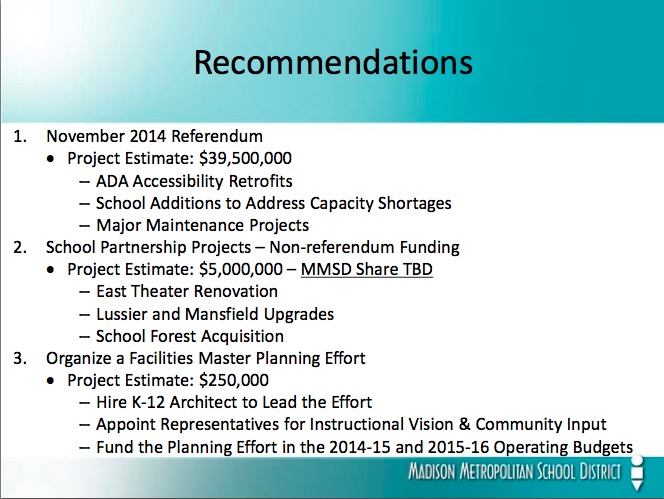
Madison Superintendent Jennifer Cheatham is proposing a $39,500,000 November, 2014 maintenance referendum (page 38 of 39), according to her “Strategic Framework Progress” update [1MB PDF]. Questions remain on where the money went from the $26,200,000 2005 maintenance referendum. The District has, according to page 3, launched a “zero based budget”. I am hopeful that the District will address past spending initiatives and provide a complete, easy to understand look at its finances.
Finally, bricks and mortar have their place, but nothing is more important than addressing Madison’s disastrous reading results.
Although Wisconsin currently requires the fewest number of math and science credits in the Midwest for high school students to graduate, recently proposed legislation would increase the number of necessary credits in those subjects.
The bill, which received a public hearing Thursday, would require students to take three credits of math and science, as opposed to the current state-required two credits of each.
“As we work to raise the bar this year, we are challenging students to think critically and solve complex problems. We believe that’s what it takes to ensure students are college, career and community ready,” Madison Metropolitan School District Superintendent Jennifer Cheatham said in an email to The Badger Herald. “Additional math and science classes align with that vision. Many of our students already take additional math and science in high school, and we’re supportive of making that a requirement.”
The bill would require more credits at the state level, but many districts in Wisconsin already have higher numbers of mandatory credits, Peter Goff, UW professor in the department of educational leadership and policy analysis, said.
Madison Teachers, Inc (PDF), via a kind Jeanie (Bettner) Kamholtz email:
Several joint committees were created in the recent negotiations over MTI’s 2014-15 Teacher Collective Bargaining Agreement. The joint committees will study and potentially recommend modification of Contract terms. Each committee will report its recommendations, if any, to Superintendent Cheatham and to the MTI Board of Directors.
The Committee on Teacher Assignments will discuss potential modification of Contract Section IV-F, Teacher Assignments, Surplus, Vacancies and Transfers. MTI’s appointees are: Andy Mayhall (Thoreau), Nancy Roth (West), Karlton Porter (Cherokee) and Doug Keillor.
The Committee on Teacher Evaluation will study and make recommendations pertaining to the District’s implementation of the State-mandated teacher evaluation system, “Educator Effectiveness”. Any revisions will be incorporated into Section IV-H of the Teacher Collective Bargaining Agreement and will become effective July 1, 2014. MTI’s appointees are: MTI President Peggy Coyne (Black Hawk), Andrew McCuaig (La Follette), Kerry Motoviloff (Doyle) and Sara Bringman.
The Committee on Professional Collaboration Time will discuss implementation of the MTI/MMSD Memorandum of Understanding on High School & Middle School Professional Collaboration Time. MTI’s appointees are: Art Camosy (Memorial), Karen Vieth (Sennett), Aisha Robertson (West), and Nichole Von Haden (Sherman).
The Committee on Elementary Planning Time will discuss potential modification of Section V-I-1-d, Early Monday Release and Section V-P, Planning Time. MTI’s appointees are: Nancy Curtin (Crestwood), Greg Vallee (Thoreau), Holly Hansen (Falk) and Doug Keillor.
The Madison School Board and new Madison School Superintendent Jennifer Cheatham sure have the nerve proposing a new tax levy for Madison homeowners that will raise the average homeowner property tax bill in Madison by about $120.
Not only is it hard for those homeowners on fixed incomes (think retirees), but what about all of those public employees who are on reduced incomes as the result of the last several years of public employee bashing?
Most public employees in Madison will be lucky to get 2 percent raises over the course of the last 5 years, not to mention having to pay considerable more for their benefits.
Enough is enough. We all can’t afford to continually pay more.
Much more on the Madison Schools’ 2013-2014 budget, here.
MMSD School Board President Ed Hughes said that public education these days is under a lot of pointed criticism if not under an outright attack. “Initiatives like the voucher expansion program are premised on the notion that urban traditional public schools are not up to the task of effectively educating a diverse body of students,” Hughes says. “We’re out to prove that they are wrong. We agree with Superintendent Cheatham that in Madison all of the pieces are in place for us to be successful. Following the framework that she will describe to you, we set the goal for ourselves to be the model of a thriving urban school district that is built on strong community partnerships as well as genuine collaboration of teachers and staff. As we do that, we will be the school district of choice in Dane County.”
Cheatham said that Madison has a lot of great things going for it, but also had its share of challenges.
“A continually changing set of priorities has made it difficult for our educators to remain focused on the day-to-day work of teaching and learning, a culture of autonomy that has made it difficult to guaranteed access to a challenging curriculum for all students,” Cheatham said. “The system is hard for many of our students to navigate which results in too many of our students falling through the cracks.”
It starts with a simple but bold vision that every school is a thriving school that prepares every student for college, career, and community. “From now on, we will be incredibly focused on making that day-to-day vision become a reality,” she said.
“Many districts create plans at central office and implement them from the top down. Instead, schools will become the driving force of change in Madison,” Cheatham said. “Rather than present our educators with an ever-changing array of strategies, we will focus on what we know works — high quality teaching, coherent instruction, and strong leadership — and implement these strategies extremely well.”
Related: The Dichotomy of Madison School Board Governance: “Same Service” vs. “having the courage and determination to stay focused on this work and do it well is in itself a revolutionary shift for our district”.
“The notion that parents inherently know what school is best for their kids is an example of conservative magical thinking.”; “For whatever reason, parents as a group tend to undervalue the benefits of diversity in the public schools….”.
Madison’s long term, disastrous reading results.

Where have all the students gone?
Madison School Board President Ed Hughes:
Esenberg sets out to identify the fundamental differences between voucher advocates and opponents. His thesis is that views on vouchers derive from deeper beliefs than objective assessments of how well voucher schools perform or concerns about vouchers draining funds from public schools. To him, your take on vouchers depends on how you view the world.
Esenberg asserts that voucher advocates are united by their embrace of three fundamental principles: that a centralized authority is unlikely to be able to decide what is best for all; that families should be trusted to select their children’s schools since ordinary people are capable of making choices for themselves without paternalistic direction; and that “government does not do diversity, experimentation and choice very well.”
By implication, he asserts that voucher opponents think that a centralized authority will be able to decide what’s best for all, that families shouldn’t be trusted to make choices for their children, and that government control is the best way to foster innovation.
And there you have it. Your views on school voucher expansion are entirely explained by whether you prefer individual freedom, like the voucher advocates, or stultifying government control, like the voucher opponents. In cinematic terms, voucher opponents are the legions of lifeless, gray drones in Apple’s famous 1984 commercial and voucher supporters are the colorful rebel, bravely challenging the control of Big Brother and hurling her sledgehammer to smash mindless conformity. You couldn’t ask for a more sophisticated analysis than that, could you?
While his thesis invites mockery, Esenberg’s short article does present a bit of a challenge to voucher opponents like myself. Can we set out a coherent justification for our opposition that doesn’t depend on the facts that voucher schools drain needed resources from public schools and don’t perform any better? Sweeping those fairly compelling points aside, Esenberg asks, in effect, what else you got?
Mr Hughes anti-voucher rhetoric is fascinating on several levels:
1. The Madison School District’s long term, disastrous reading results. How much time and money has been wasted on anti-voucher rhetoric? Reading has long been job one.
2. Local private schools do not have much, if any availability.
3. Madison spends double the national average per student (some of which has been spent on program explosion). Compare Milwaukee Public and Voucher Schools’ Per Student Spending.
4. Madison’s inability to address its long-term disastrous reading results will bring changes from State or Federal legislation or via litigation.
5. Superintendent Cheatham cited Long Beach and Boston as urban districts that have “narrowed the achievement gap”. Both districts offer a variety of school governance models, which is quite different than Madison’s long-time “one size fits all approach”.
I recall being astonished that previous Madison School District administrators planned to spend time lobbying at the State level for this or that change – while “Rome is burning“. Ironically, Superintendent Cheatham recently said:
“Rather than do a lot of work on opposing the voucher movement, we are going to focus on making sure our schools are the best schools possible and the schools of choice in Madison,” Cheatham said.
This points up one of the frustrating aspects of trying to follow school issues in Madison: the recurring feeling that a quoted speaker – and it can be someone from the administration, or MTI, or the occasional school board member – believes that the audience for an assertion is composed entirely of idiots.
A great, salient quote. I would hope that the District would focus completely on the matter at hand, disastrous reading scores. Taking care of that problem – and we have the resources to do so – will solve lots of other atmospheric and perception issues.
In closing, I sense politics in the voucher (and anti-open enrollment) rhetoric. Two Madison School Board seats will be on the Spring, 2014 ballot. One is currently occupied by Mr. Hughes, the other by Marj Passman. In addition, local politics play a role in becoming school board President.
The Madison School District’s recent rhetoric around annual property tax increases (after a significant increase in redistributed state tax dollars last year and a “return to normal” this year) is, to the ongoing observer, unsurprising. We appear to be in the Rainwater era “same service” approach to everything, from million$ spent on a partially implemented Infinite Campus to long-term disastrous reading scores.
Steve Coll’s 5 July 2013 New Yorker column nails it:
The most likely explanation is that President Obama never carefully discussed or specifically approved the E.U. bugging, and that no cabinet-level body ever reviewed, on the President’s behalf, the operation’s potential costs in the event of exposure. America’s post-September 11th national-security state has become so well financed, so divided into secret compartments, so technically capable, so self-perpetuating, and so captured by profit-seeking contractors bidding on the next big idea about big-data mining that intelligence leaders seem to have lost their facility to think independently. Who is deciding what spying projects matter most and why?
Much more on annual local property tax increases, here:
The Madison School Board should limit the school property tax hike to the rate of inflation next year, even if that means scaling back a proposed 1.5 percent across-the-board salary increase for school district employees, says member Mary Burke.
“I think in an environment where we’ve seen real wages in Dane County decrease, and a lot of people are on fixed incomes, we have to work as hard as possible to limit any increase to the inflation rate,” Burke said Tuesday in an interview.
…
But School Board discussions have focused around reducing the proposed salary hike, and cutting back on facility maintenance to pare down the $392 million proposed budget enough to bring the property tax increase to 4 or 5 percent, board President Ed Hughes told me.
The district under state law could increase its levy by as much as $18,385,847 or 9 percent. Keeping the increase to around the rate of inflation would mean an increase of less 2 percent.
…
Board member TJ Mertz can’t vote on salaries because his wife is a teacher’s aide with the school district, he told me, but he has long been outspoken in his belief in good pay for teachers to ensure the best academic achievement for students.
“As a citizen, I understand our staff needs to be compensated,” he said, adding that teachers have taken losses in take-home pay since they were required to begin making contributions to their pensions in 2011. “If the state won’t invest in our children, it has to come from the property tax,” he said.
Mertz said he would prefer a tax increase steeper than the 4 percent or 5 percent the board as a whole is focusing on. “I firmly believe the most important thing we can do is invest in our students; the question should not be what property tax levy can we afford,” he said.
I appreciate Schneider’s worthwhile questions, including a discussion of “program reviews”:
Several School Board members interviewed for this story stressed that the 2013-2014 budget will be a transitional one, before a broad re-evaluation of spending planned by Cheatham can be conducted.
Yet, it would be useful to ask if in fact programs will be reviewed and those found wanting eliminated. The previous Superintendent, Dan Nerad, discussed program reviews as well.
Madison Schools’ 2013-2014 Budget Charts, Documents, Links, Background & Missing Numbers.
The Madison School Board seat currently occupied by Mr. Hughes (Seat 7, and Seat 6 – presently Marj Passman) will be on the Spring, 2014 ballot (candidate information is available at the Madison City Clerk’s website). 




After two months on the job, Madison Metropolitan School District (MMSD) Superintendent Jennifer Cheatham has released a report summarizing what she’s learned during her entry process and previewing the district’s planning work going forward.
“I’d like to thank our staff, parents, students and the Madison community for helping me build a shared understanding of our district’s strengths and challenges,” Cheatham said. “The work ahead will take urgency, determination and tenacity, but my experience over the past two months has made me so confident because I know that all of the ingredients for success are here in Madison.”
Over the past two months, Superintendent Cheatham has visited all 48 MMSD schools, as well as several after-school programs, alternative programs, community early childhood care and education centers, and the district’s alternative high school. Each visit included a meeting with teachers and staff, classroom observations and a meeting with the principal and members of their leadership team. In high schools, visits also included discussions with students and culminated in community meetings. The superintendent also met with parents, elected officials, community leaders, university partners, religious leaders, business leaders and union leaders.
The Madison Urban League, via a kind Kaleem Caire email:
FOR IMMEDIATE RELEASE
April 23, 2013
Media contact: Kaleem Caire
kcaire@ulgm.org
608.729.1249
Click Here for Urban League’s 2013-14 Agenda
State Test Scores Confirm Urban League’s Concerns and Call to Action
Madison, WI – Today, the Wisconsin Department of Public Instruction released students’ results on the annual statewide achievement test, Wisconsin Knowledge and Concepts Exam (WKCE). The results confirm concerns raised by the Urban League of Greater Madison, that disadvantaged students and students of color are severely underperforming in many of Wisconsin’s public schools, particularly in the Madison Metropolitan School District.
All Wisconsin public school students completed the test in November 2012. This revised test raised the standards of performance for all students, thereby providing a more accurate picture of students who are on track to graduate from high school academically ready to succeed in college or a career. Test results show that all students, regardless of their race, socioeconomic status or disability, are struggling to achieve to high standards in Madison-area public schools.
This afternoon, the Urban League of Greater Madison joined Madison Metropolitan School District Superintendent Jennifer Cheatham, and leaders of other community organizations, at a press conference where Cheatham shared MMSD’s results. Cheatham presented data showing that an astounding 92% of African American and 85% of Latino students are reading below their grade level, and 90% of African American and 77% of Latino children are failing in mathematics. The data further showed that a large percentage of white students have fallen behind as well, with 42% are reading below grade level and 33% failing in math.
In reflecting on the scores, Darrell Bazzell, the Chair of Urban League’s Board of Directors said, “These numbers are a stark message that Madison’s public schools are at a tipping point and that our community must embrace change. The implications for our region are profound. For the sake of our community and our children, Madison can, and must, do better for all students and families.”
Bazzell further stated that, “Every citizen in our community must say that ‘we will no longer harbor these gaps; that we accept responsibility for addressing these challenges; and that we will commit to doing all that we can to ensure all of our children succeed. We must also acknowledge where we are not succeeding and commit to change in smart, innovative and effective ways that lead to real progress for our kids’.”
In response to these troubling statistics, Urban League President and CEO, Kaleem Caire, shared that, “When 90% of Black children cannot read at their grade level, we are significantly reducing the possibility of success for an entire generation. This issue negatively affects not only this generation of children, but also the vitality of our entire region. If not addressed quickly, it will affect the quality of the lives of all citizens who call Madison home.” To address these challenges, Caire said “The Urban League is working to build a pipeline of high quality cradle to career educational and employment services that positively impact the entire family, move all children towards high performance, and prepare youth and adults for career success.” He further highlighted, “We have already begun working with the Madison Schools, other area school districts, employers and community partners to ensure that we attack the persistence of underachievement and other contributing factors, such as poverty, at its core. ”
The Urban League’s 2013-14 Strategic Plan creates opportunities that will help the community overcome these challenges. Caire enthusiastically shared that, “We are a community of great people, great teachers and great families who are passionate about helping others transform their lives. But our passion now must become our reality.”
About the Urban League of Greater Madison
The Urban League of Greater Madison’s mission is to ensure that African Americans and other community members are educated, employed and empowered to live well, advance professionally and contribute to the common good in the 21st Century. We are committed to transforming Greater Madison into the Best [place] in the Midwest for everyone to live, learn, and work. We are working to make this vision a reality through a comprehensive strategic empowerment agenda that includes programs & services, advocacy, and partnerships & coalition building. www.ulgm.org
Urban League of Greater Madison | 2222 S. Park Street | Suite 200 | Madison | WI | 53713
Related: The rejected Madison Preparatory Academy IB charter school
Madison’s long term disastrous reading results.
The recently released WKCE results.

schoolinfosystem.org